At the start of May 2024, I was to attend the wedding of a good friend in Barcelona. Originally, I planned to take the train there from Paris a few days before the wedding, explore the city for a few days, attend the wedding, and then take the train back to Paris.
However, about a month before the trip, I realised that I happened to have nine vacation days that I would lose if they remained unused before the end of the month of May. I wondered, how might I extend my trip to use up all of those extra days?
At first, I thought of visiting some other parts of Spain after the wedding, or returning to Paris and then travelling in a different direction (a night train to Austria and then Croatia, for example). However, I also considered the possibility of taking my bicycle to Barcelona on the train, and then riding it back to Paris.
This bicycle idea didn’t come from nowhere: when I moved to France, I planned on staying for only a few years, saving some money for travelling, and then embarking on a multi-year bicycle trip through Europe and Asia before eventually ending somewhere not far from Australia, where I would spend a year on a Working Holiday Visa before moving on to New Zealand and French Polynesia around the time I turned 30. Spoiler alert: I have already hit 30, and as is often the case, what I’ve done in the years since making those plans has been quite different from what was planned. I still have not done that long bicycle adventure, and I question whether it’s still something that would bring me joy, given that it would require leaving many people that I care about deeply.
Apart from one week spent cycling around the Alps in 2021, I had never done any extended travelling by bicycle, so this trip from Barcelona to Paris presented an opportunity to “dip my toe into the water” and see whether I enjoyed the bicycle travel experience. I decided that I would bring my bicycle with me on the train from Paris to Barcelona, then ride it back to Paris.
Depending on the route taken, the trip from Barcelona to Paris would be about 1100 kilometres long, and due to a commitment in Paris after the wedding, I would have just ten days to complete the trip. During my only bicycle trip in the Alps a few years before, I had managed to ride well over 100 kilometres per day, so I did not have concerns about the distance, and I was reassured with the knowledge that if my progress proved to be slower than expected, I would be able to simply bring the bike on a train and get back to Paris that way.
Travelling to Barcelona
On the day of my departure from Paris, after a night of unsatisfying sleep, I strapped my backpack, tent, suit bag containing jacket/shirt/pants/shoes, and various storage bags onto my bike, then rode it to Paris Gare de Lyon, from where the train to Barcelona would depart. In theory, there are French high-speed trains with spaces for assembled bicycles, but none of the trains going to Barcelona seemed to have any of these spaces available to be reserved, so I was forced to disassemble the bicycle at the train station and pack it into a large bag as luggage. I arrived at the station early, removed everything from the bicycle, disassembled it, and then dragged the bicycle and my collection of bags across the station after having realised that I was in the incorrect departure area.
After getting on the train, the trip began on a sour note. An older man behind me had placed his phone on his tray table, and every few minutes it would make a loud tone when he received a notification. General etiquette in French trains involves putting your phone in silent mode (and there are signs in every car indicating as such), so I got up and politely asked the man if he could put his phone on silent mode, assuming he had just forgotten, and thanked him. He looked at me stupidly for a few seconds, and then responded with (rough translation) “Is it going to kill you, the beep, beep sound? You’re young, it won’t kill you. Let other people live their lives without being told what to do.” It would have cost this inconsiderate prick nothing to just mute his phone, and his comments clearly indicated that he thought that his older age gave him the right to bother other people for his own pleasure. In any case, I realised that trying to reason with that inconsiderate prick would yield no benefit, so I returned to my chair, feeling both angry and sorry for this person who must have lived a pretty sad life to be so needlessly and intentionally inconsiderate and rude.
On my way to the train station, I had noticed that the sandwiches that I had prepared for the trip were not in my my backpack, meaning that I had foolishly forgotten then in my apartment during my rushed departure. In the past, I had found that the SNCF, France’s national railway operator, would often put in the minimum effort required to ensure that there would be some vegan meal on long trains, so I went to the dining car to see what would be available, yet on that particular train, there was no vegan meal available. I had initially been presented with a single, tasty-looking sushi-like snack as a possibility, but after purchasing four of them (as it was all I’d be able to eat for the next seven hours), I inspected the ingredients and found that they contained fromage blanc, a soft white French cheese that seemed to serve a role similar to cottage cheese or yogurt. Returning the sushi to the counter, I was left with nothing but plain potato chips, apple sauce, and cashews to eat for the remainder of the relatively long trip.
After almost seven hours (during which sleep did not come easily, due to the various telephone noises being produced throughout the train car), I got off the train, re-assembled my bicycle, and then immediately screwed up by:
- Getting black grease from the bicycle chain all over the only shirt and pair of pants that I would wear outside of the wedding, and
- Over-tightening the seat height adjustment bolt, causing it to break into two pieces and leaving my seat unable to be raised to the correct height.
I packed up my belongings onto the bicycle, rode to a nearby bike shop to purchase a new seat adjustment bolt, and after having fixed that, rode to my hostel where I would stay the night.
Barcelona and the Wedding
The weather in Barcelona was beautiful when I arrived, so I spent part of the evening walking around the city. I enjoyed a proper meal at an excellent vegan café, then returned to my hostel, where I tried in vain to wash the bicycle grease out of my clothes. The next day, I had a great lunch at a Mexican vegan restaurant that had been recommended to me, stopped to see the soon-to-be bride and groom for a while, and then started my first mini-trip: a bicycle ride from Barcelona to a hotel in the countryside close to the village of Granollers, where some friends and fellow guests at the wedding were also staying.
On this trip, I had my first experience with the questionable reliability of Google Maps’s bicycle navigation function. The route from Barcelona to the hotel roughly followed a river, the Besòs, and Google indicated that there was a bicycle path along the river, so I expected a pleasant 90-minute ride from Barcelona to the hotel on that sunny afternoon. However, after just a few kilometres of travelling along the river, the paved bike path turned into a still-navigable dirt trail, and then turned into a deep gravel trail that would have been navigable only by a well-equipped mountain bike equipped with large tires, and which was entirely impracticable on my heavy bicycle onto which I had so many bags attached. I was forced to double back for a large part of the distance that I’d travelled until I found an alternate bike path farther from the river which was quite pleasant and which got me about halfway to my destination, but even this path ended, so I ended up finishing the trip on a rural highway shared with cars. Due to the limited visibility around the curves on the road, cars often had to wait behind me before passing, but the Spanish drivers were always courteous, and I felt much safer in their company than I did when I was forced to ride on rural roads in France.
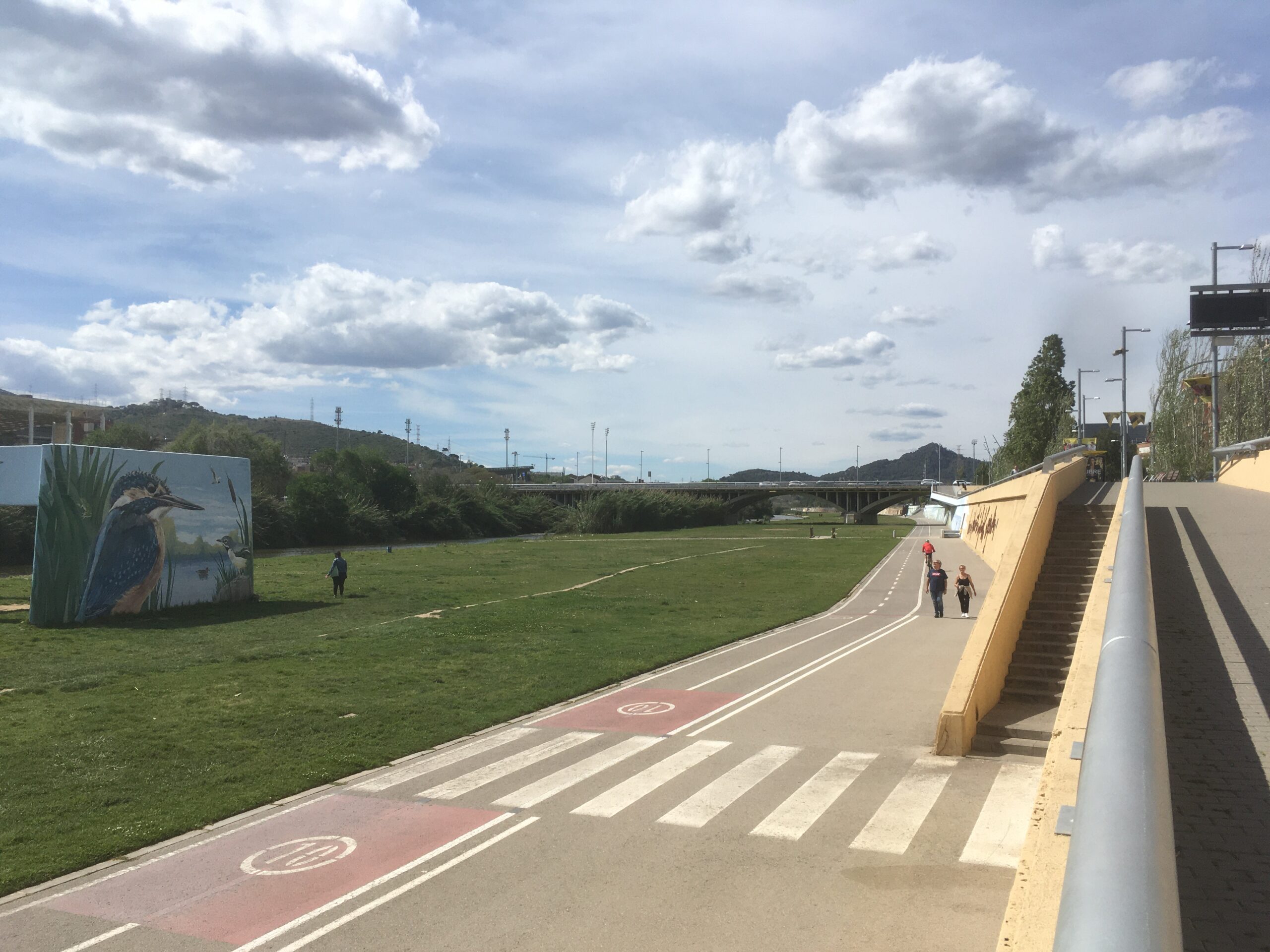
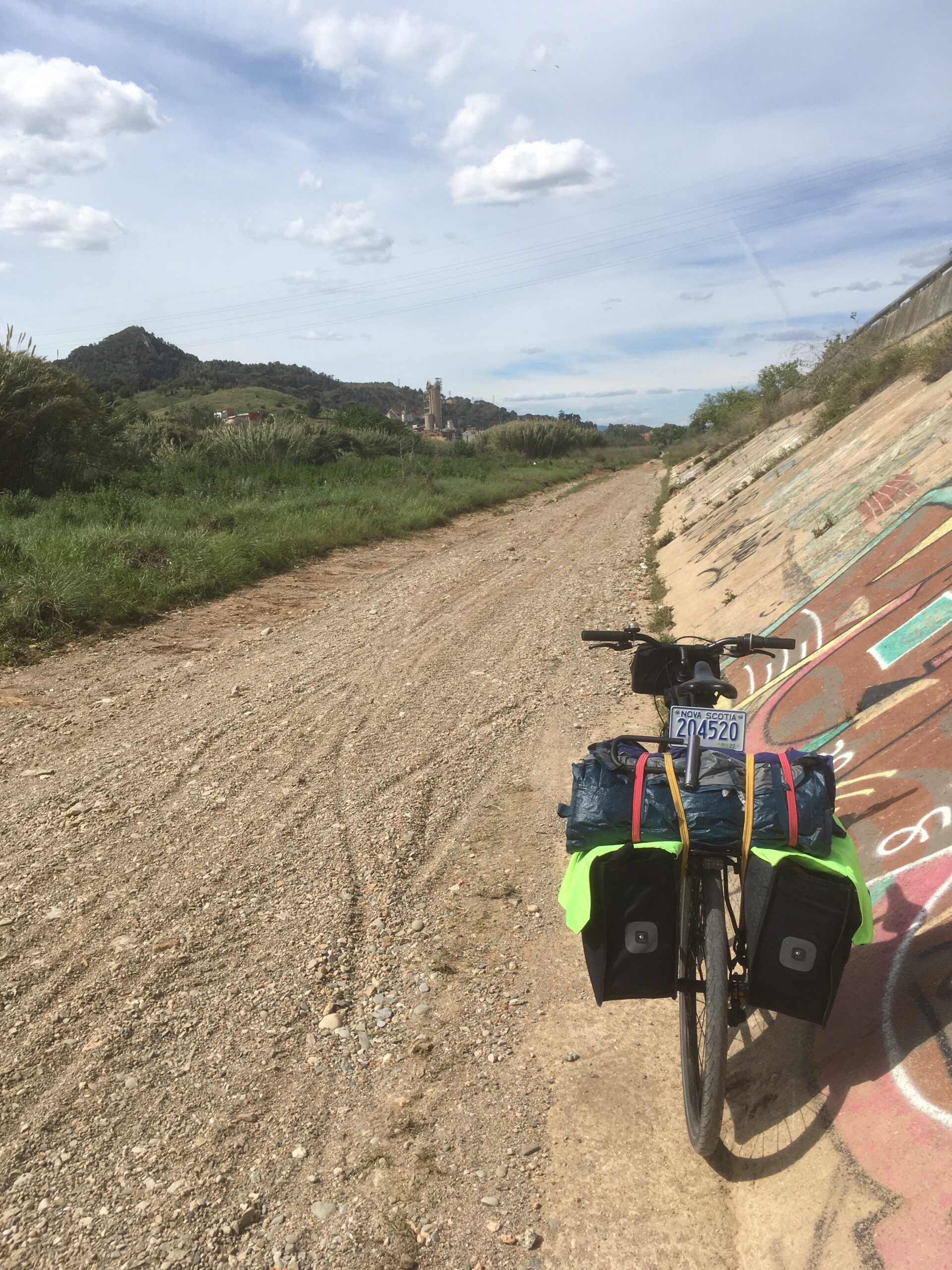
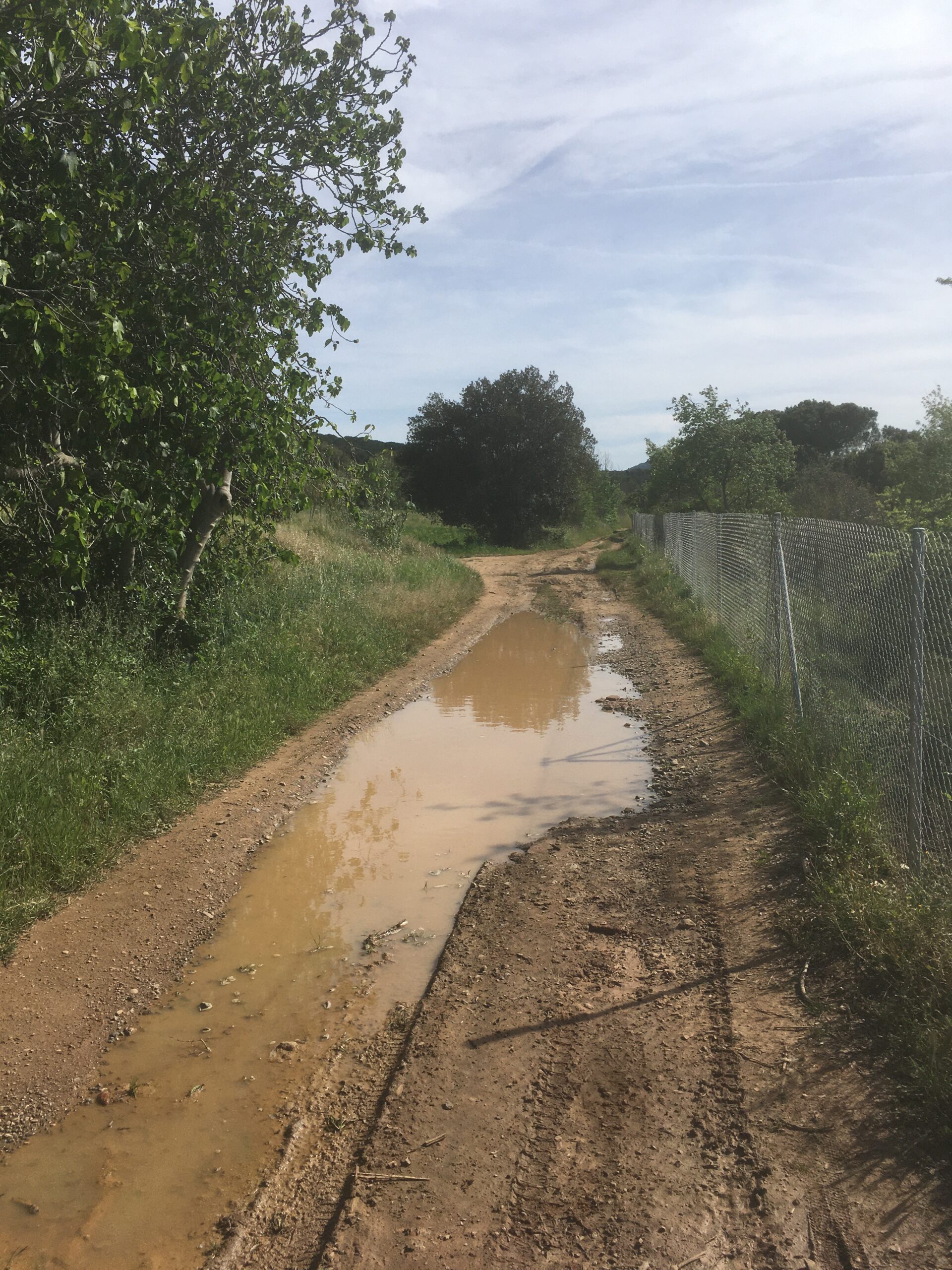
Upon arriving at the hotel, after having survived a few more bizarre navigation recommendations from Google that sent me across a highway overpass on which I suspect bicycles were not actually supposed to be present, I was happy to be able to settle into my room. I ended up spending part of the evening dealing with a work emergency that arose by chance while I was briefly checking my e-mail, then had a nice dinner with friends before settling in for some sleep.
The day of the wedding was wonderful. The trilingual English/French/Spanish ceremony took place in the late afternoon at a beautiful venue, accompanied by perfectly sunny weather and a light breeze, and the evening of drinks/appetizers/dinner/dancing was great fun. There were many people other than myself with dietary restrictions, but because the couple had taken care to ensure that everyone was well fed despite their restrictions, no one felt as though they were just getting a bad alternative to the main dish.
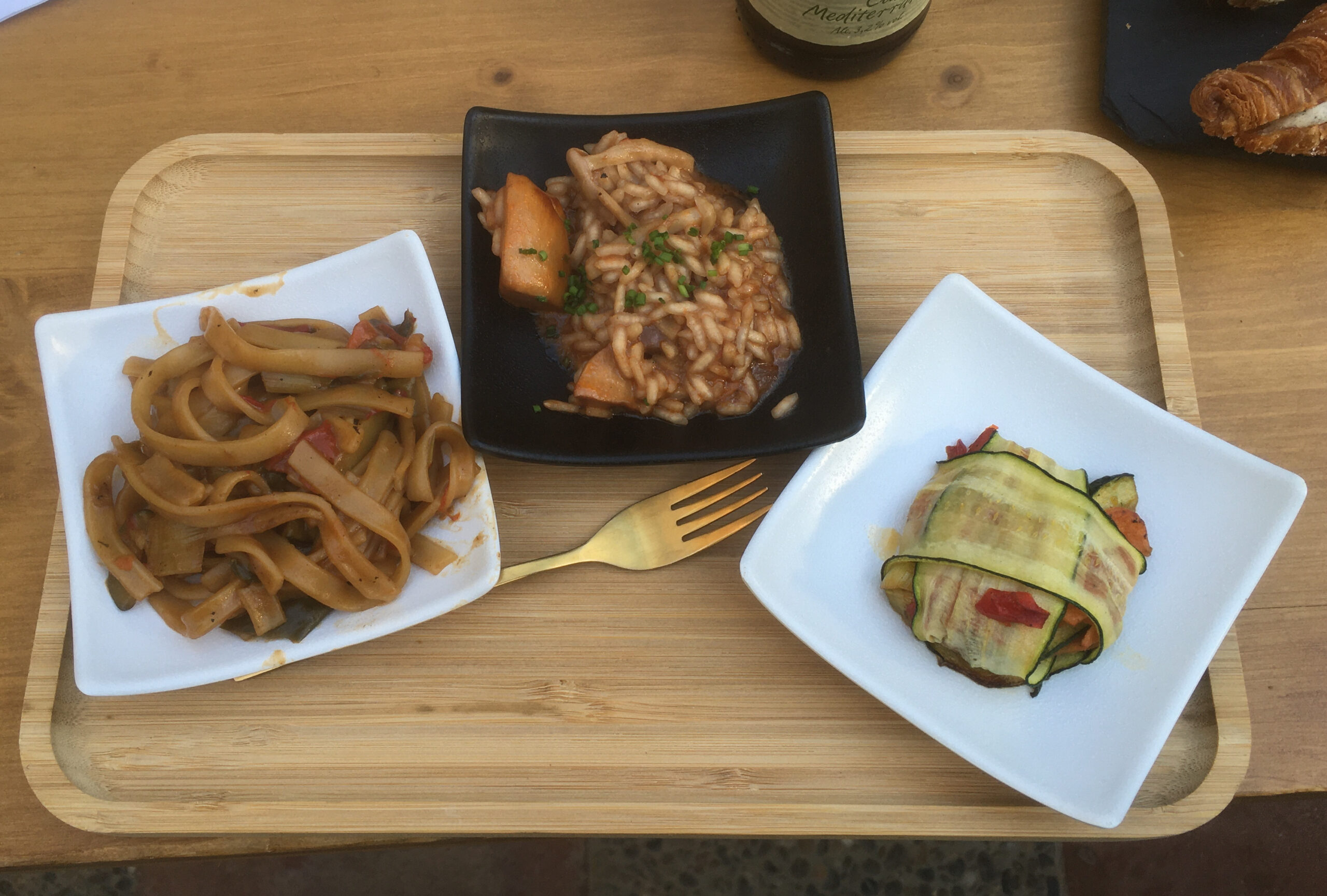
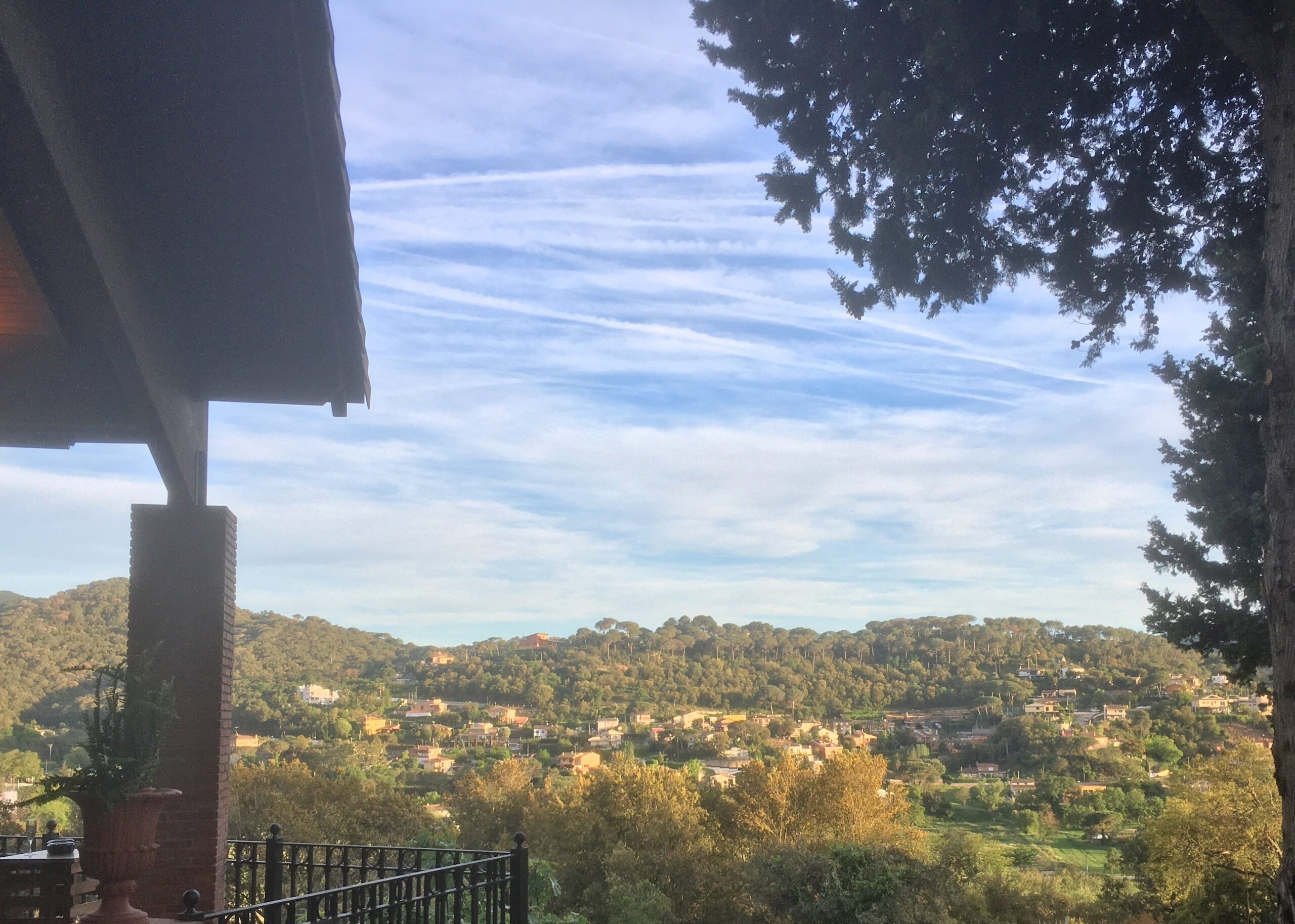
I have never felt so well taken care of at any event, a sentiment that I suspect was shared by the other guests in my position, and which allowed us to focus on enjoying the celebration without having to wonder what we would have to eat. Properly nourished and watered, we enjoyed dancing until late in the night.
The day after the wedding provided an opportunity to see the newlyweds and other guests in the afternoon. I was able to give my suit to friends who were flying back to Paris, which saved me from having to bring it on my bicycle the whole way. In the evening, I packed my supplies, and prepared for departure.
Day 1: Granollers to Caldes de Malavella, ~100 kilometres
My plan was to ride from the hotel to the Mediterranean coast about 10 kilometres away, and then follow the EuroVelo 8 bicycle route all the way up the coast into France towards the city of Montpellier, where I would head north to Paris through the centre of the country, following the French cycle route V70 where possible and then joining with the EuroVelo 6 route to take me the remaining distance to Paris.
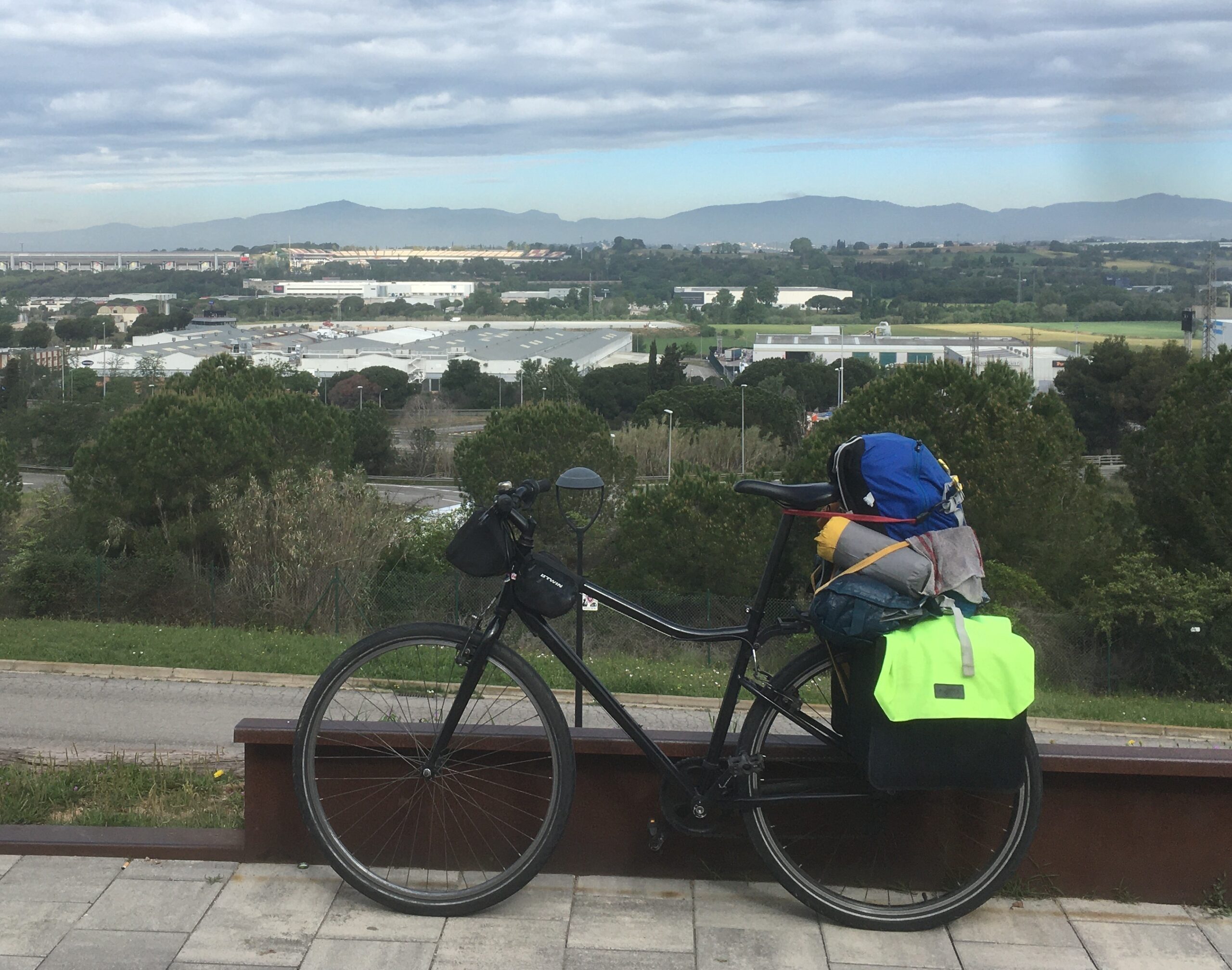
I left the hotel later than I had hoped, around 10 AM. The initial ride to the Mediterranean coast was not a particularly easy start, involving an almost 300-metre vertical climb in the first four or five kilometres before descending towards the coast. After reaching the coast, I looked for the cycle path that was indicated online when looking at the map of the EuroVelo 8 route, but soon realised that the route seemed to simply follow the N-II highway all the way from Barcelona to the border of France. While I would normally be very hesitant about riding for long periods along a major highway, I continued to be pleasantly surprised by the courteous driving of the Spanish drivers, who almost all moved an entire lane away from me when passing.
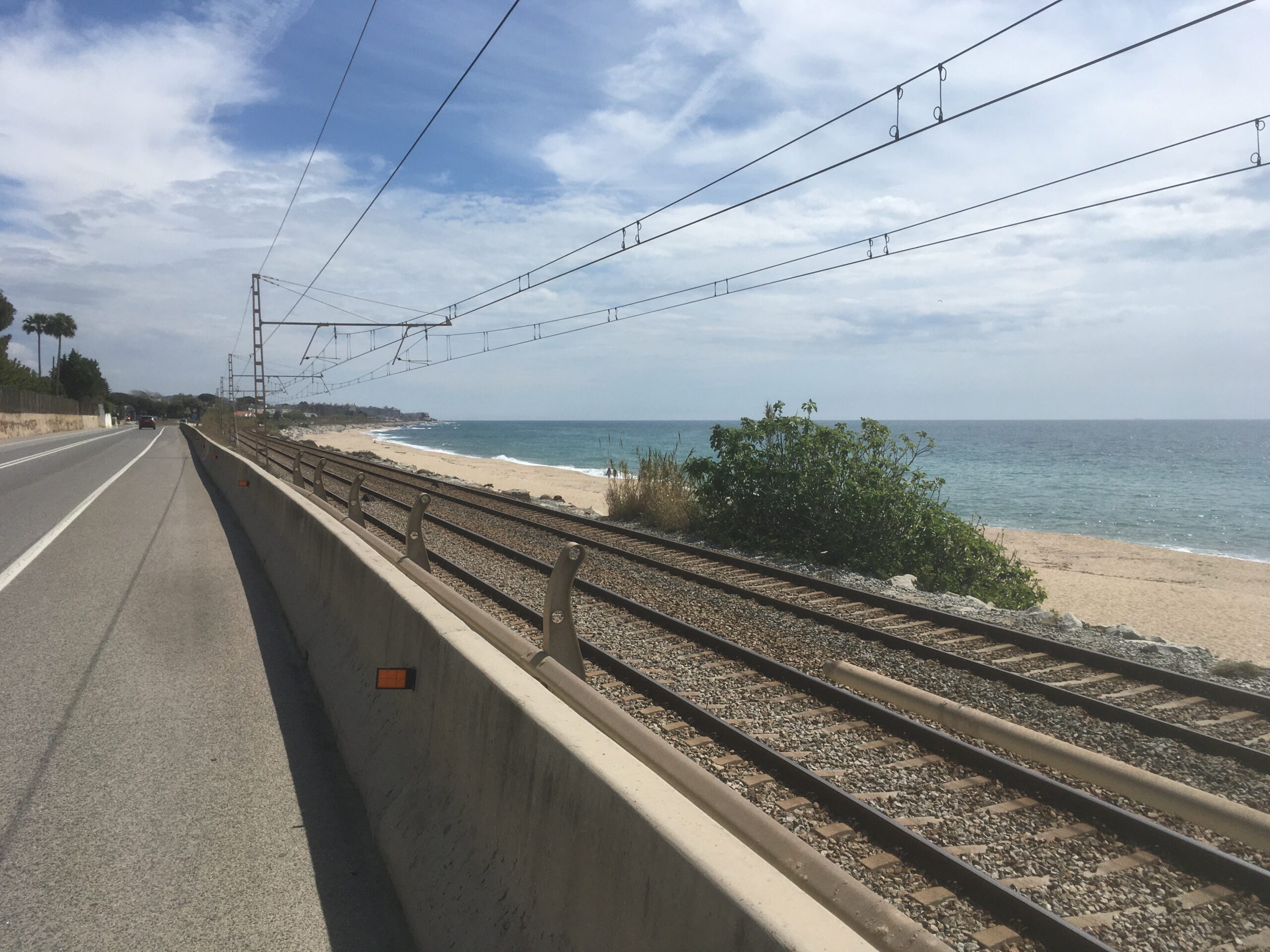
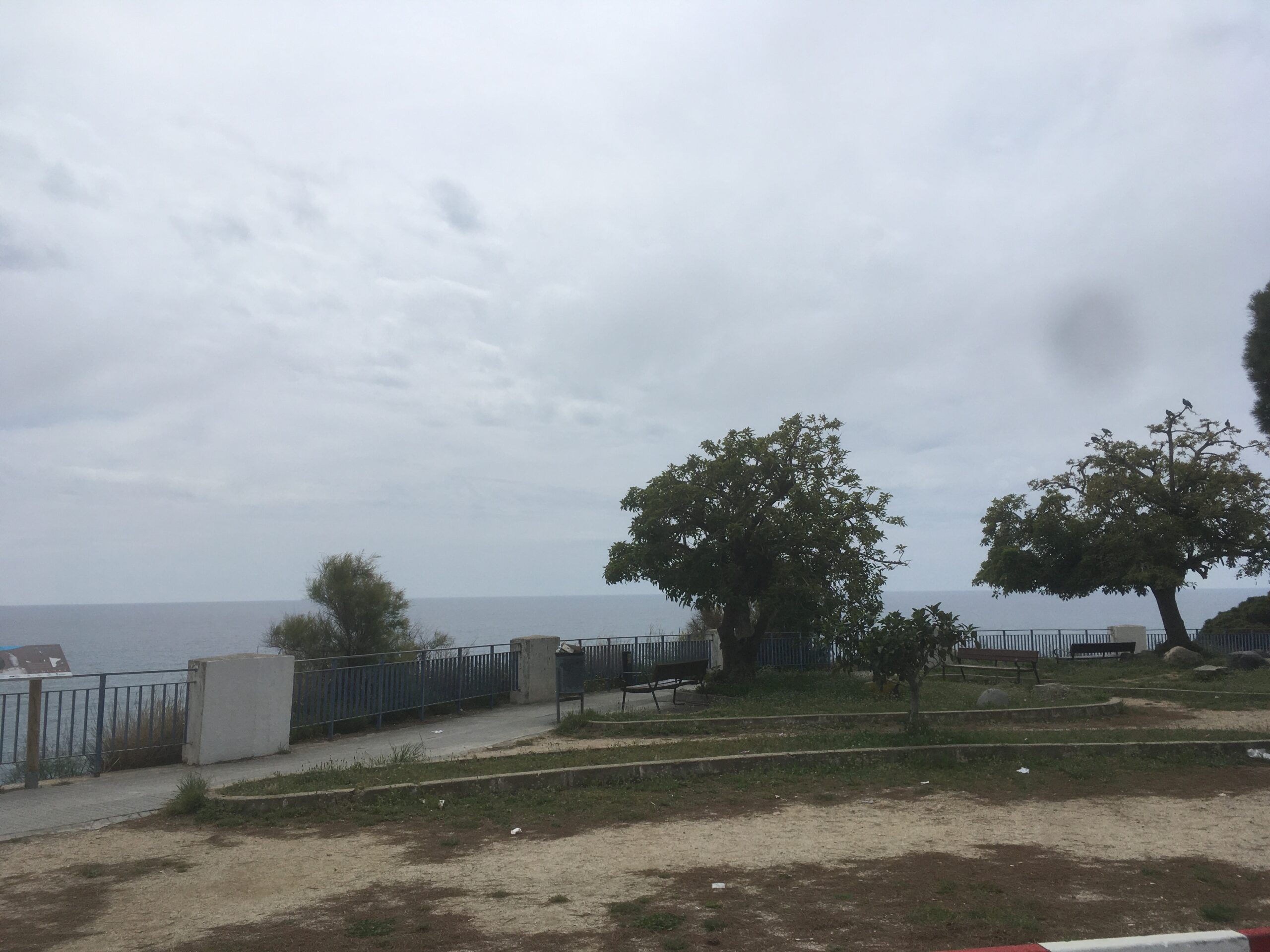
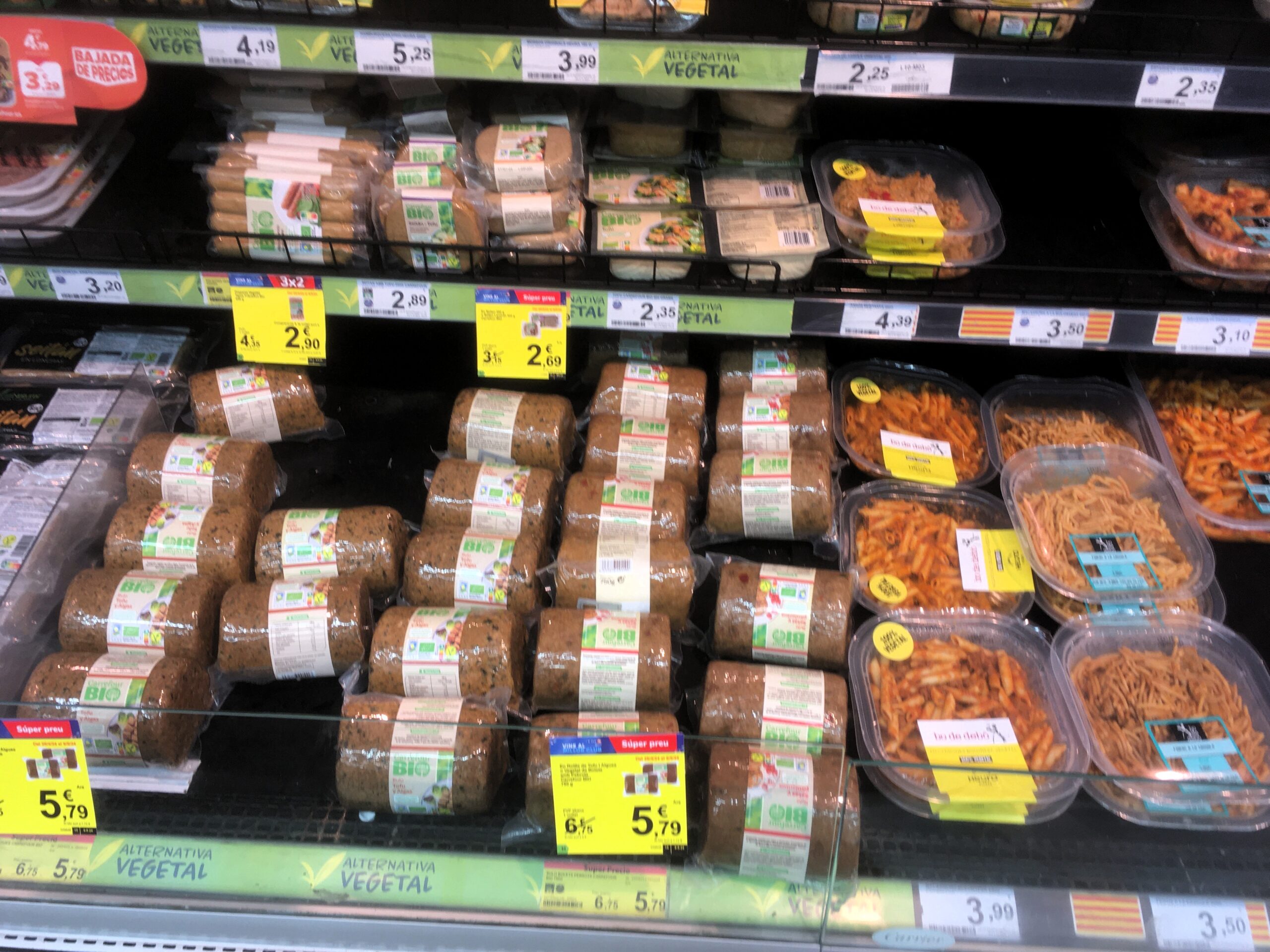
After a few hours of following the N-II highway along the coast, the route headed inland, and I noticed that the official EuroVelo 8 cycle route started to diverge from the very direct N-II highway. Deciding to trust the EuroVelo 8 creators to choose pleasant cycle routes, I used my GPS to follow the route for a few hours. Although EuroVelo routes are supposed to be marked with directional signs, this route did not seem to have markings for most of the sections in Spain, so I wasted a lot of time stopping every few minutes to check the route on my GPS. The route was frustratingly complex, often taking me onto difficult-to-navigate dirt paths that significantly slowed progress, and sometimes showing entirely impossible itineraries, including an instance where the GPS showed a straight line forward, but my route was blocked by a multi-lane freeway that required a 20-minute, multi-kilometre detour to cross.
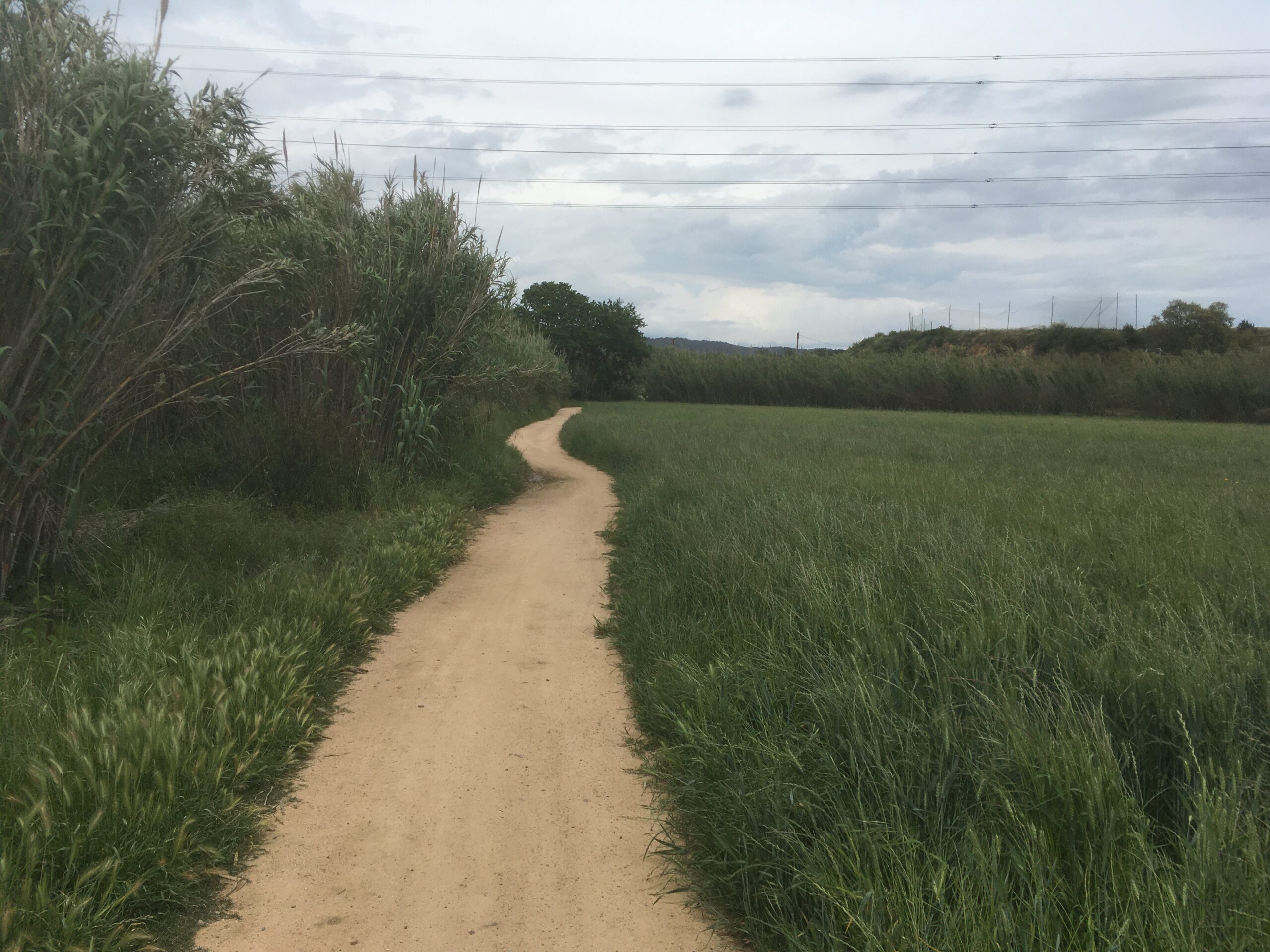
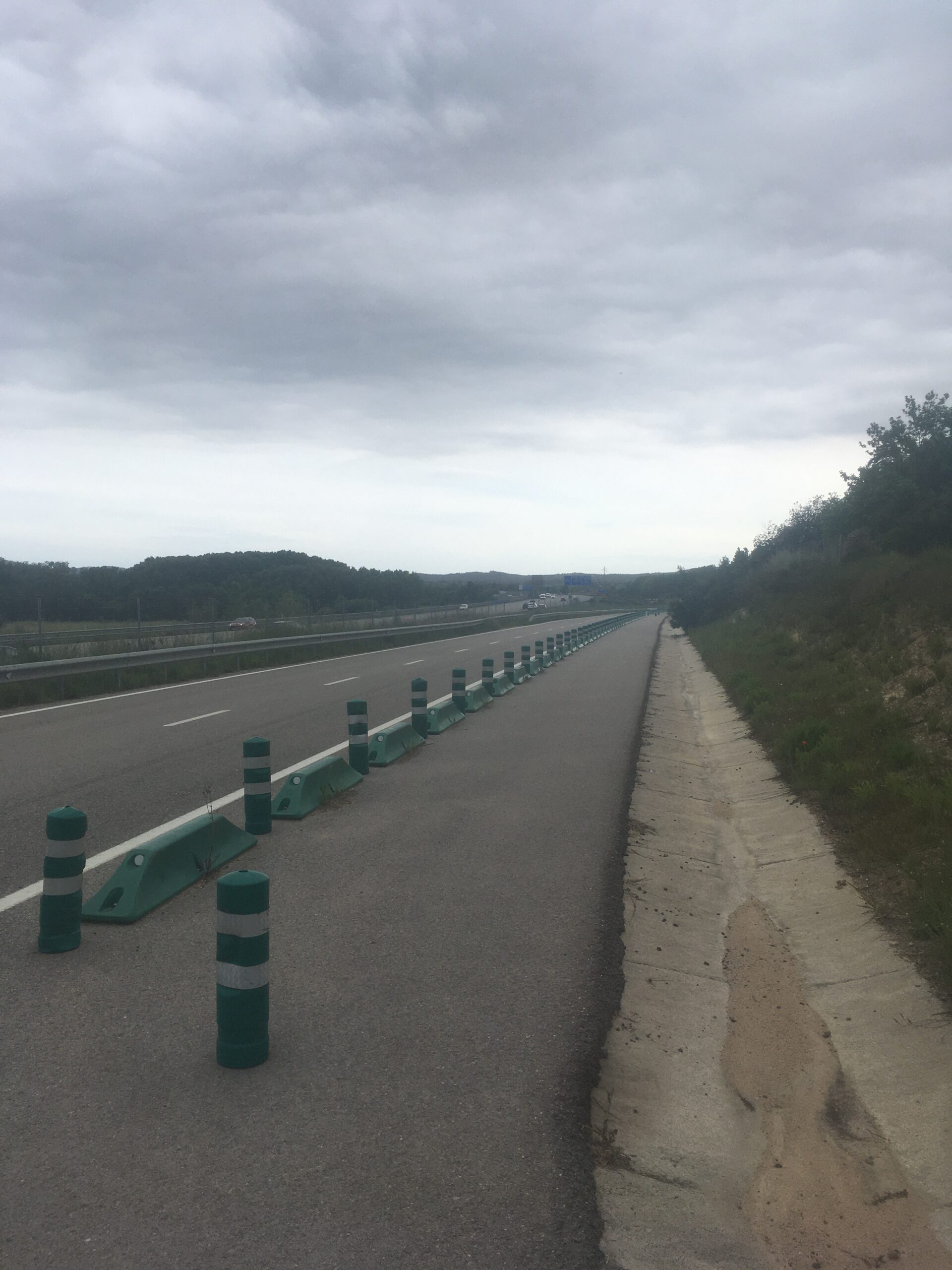
At one point, the EuroVelo 8 route took me onto a dirt road in a forest that was covered with lots of loose material (dirt and gravel), and while attempting to slow down on a downhill section to avoid damaging my bicycle’s wheels on a large rut, my tires lost traction, the bike slid out from under me, and I came crashing down to the ground. After a minute or two of moaning and frustration, I pulled myself together and assessed the damage: although nothing on my bicycle was broken, and none of my bones seemed to be broken either, the fall had scraped the skin off of a large patch under each of my knees. As a stream of blood trickled down my legs, I realised that I would need to stop somewhere to clean the wounds. I searched for a hotel in the next town, Caldes de Malavella, which was about a half-hour ride away, and decided that it would be good to stop there for the night. I made a reservation, then continued on my way, having no supplies with which to clean my bloody legs.
During the relatively short ride towards the small town where my hotel was located, I happened to stumble across another traveler, Batiste, a French man heading from Lyon to Morocco (or beyond) on a bicycle. Batiste’s bicycle setup was quite different from mine: he was using an electric bike to tow a large trailer, probably about two metres long, in which he stored all of his supplies and slept, and to which he had attached solar panels that he used to slowly charge the bicycle’s batteries. Despite the motor of his electric bike, Batiste indicated being able to travel only about 30 kilometres per day due to the heavy weight of the trailer and the limited capacity of the batteries. However, the trailer allowed him to carry lots of supplies (I saw several spare tires and other parts, for example) and remain autonomous for extended periods. Batiste happened to have a unused medical kit, and kindly allowed me to use some of his supplies to disinfect my wounds. After chatting for a while, I left him and continued towards the town.
After checking into the small and plain yet perfectly clean hotel, I made my way to a farmàcia, where I got some bandages for my still-bleeding knees and learned how to say “Thanks very much!” in Catalan: moltes graciès! Virtually all of the restaurants in this small town seemed to be closed, but I was able to find a small fast-food kebab shop that could provide me with a falafel sandwich.
After eating, I returned to the hotel to examine my progress along the planned route, and felt disappointed by my slow pace: I had ridden almost exactly one hundred kilometres, which was below the daily average required to reach Paris on time, but even worse, I was only sixty kilometres away from my starting point, due to the sinuous route that I’d taken.
Day 2: Caldes de Malavella to Banyuls-sur-Mer, ~100 kilometres
On the second day, having seen how slow my progress would be if I continued trying to follow the complex EuroVelo 8 route through this part of Spain, I decided to plan my own route, sticking with paved country roads instead of trying to navigate the Eurovelo 8 route.
I left Caldes de Malavella around 10 AM, heading north towards the city of Girona. The countryside of this part of Catalonia was beautiful, and I felt the pressure and stress of the previous day lift from my shoulders as I pedaled down the country roads, remaining largely undisturbed by vehicle traffic. As I approached Girona, I saw signs for a few cycle paths that had been developed, and followed those into the city. I enjoyed the feeling in Girona’s small city centre, and took advantage of the presence of a cycle-themed café, La Fabrica Girona, to fill up with a tasty lunch.
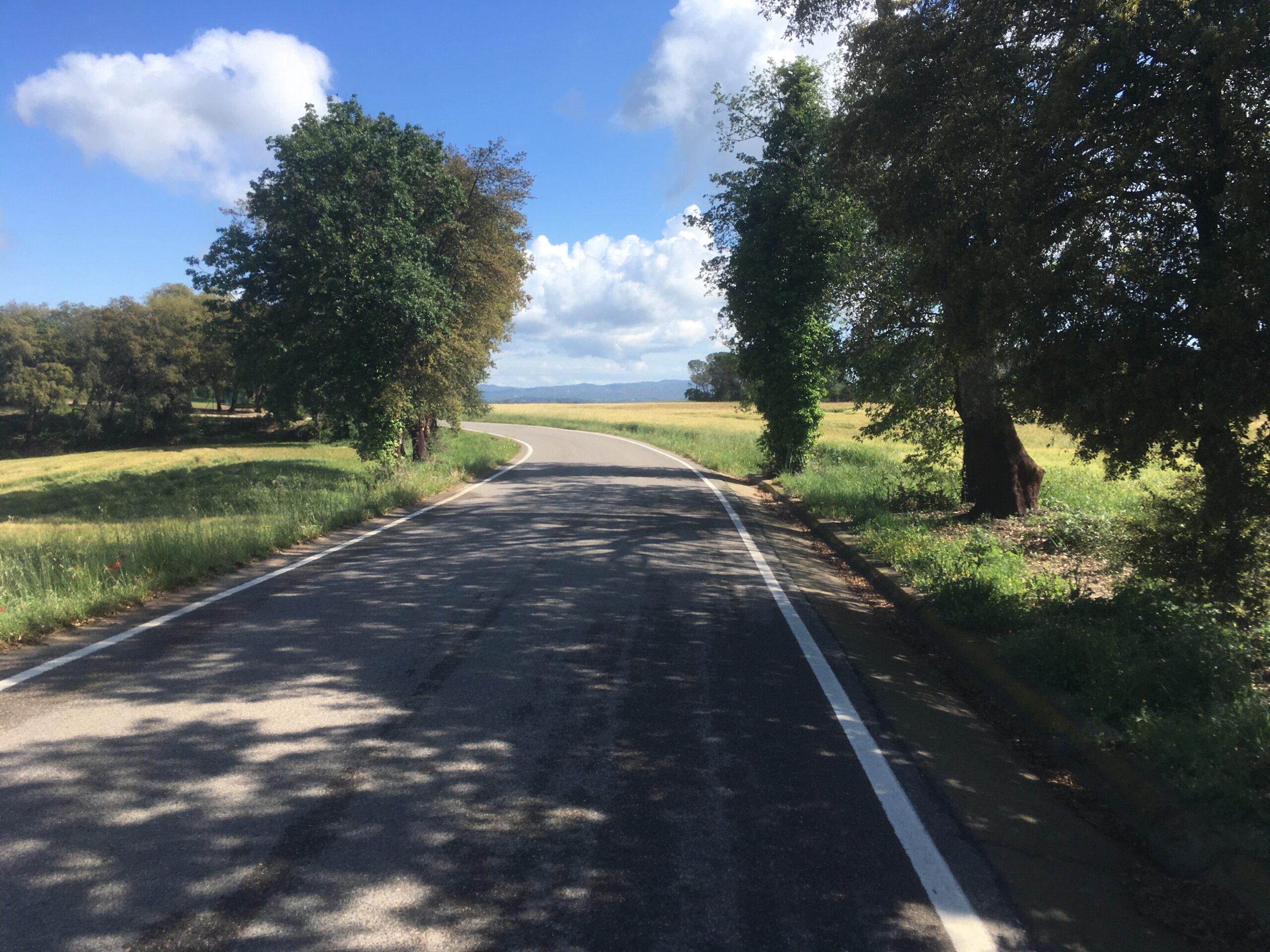
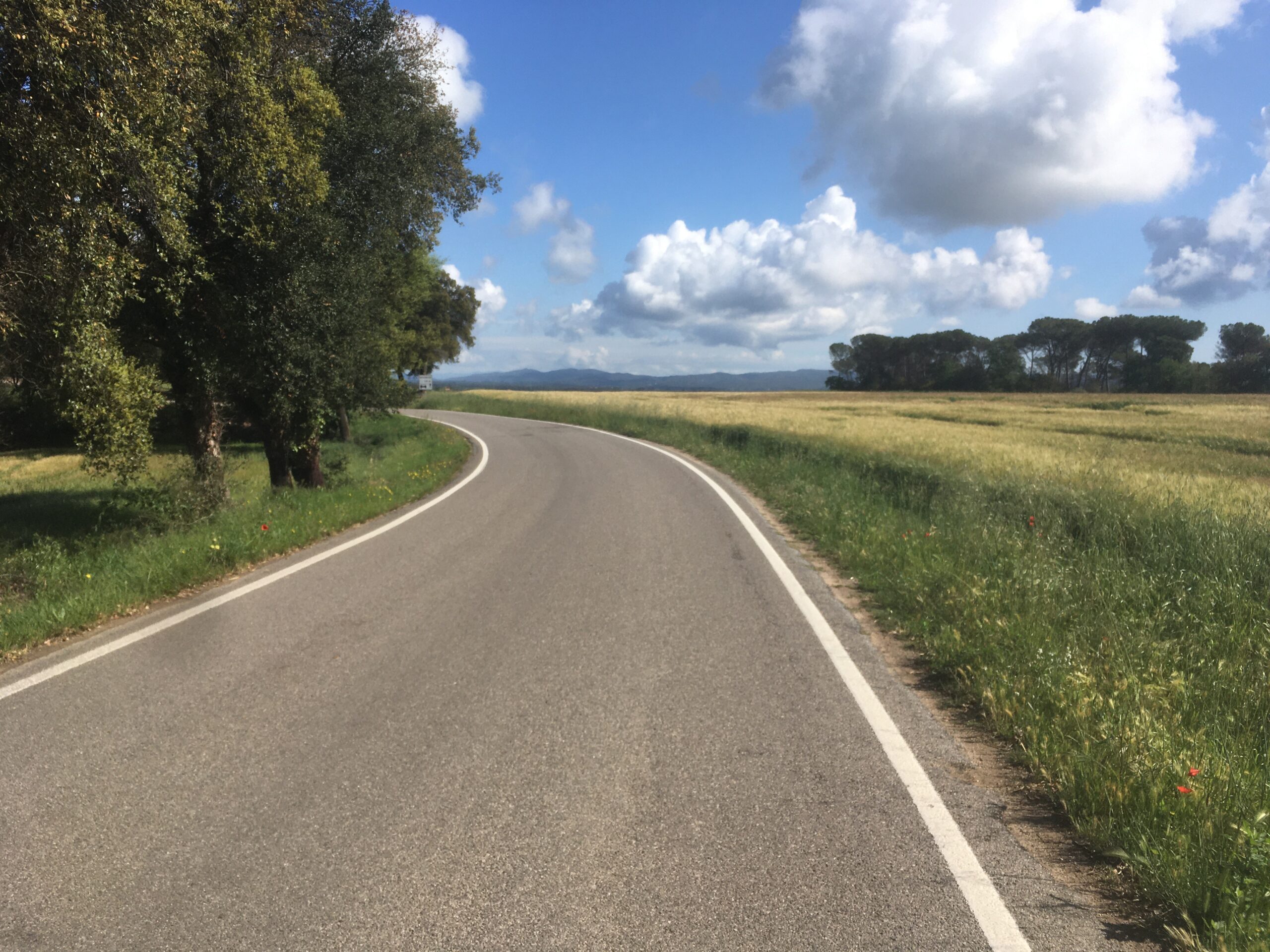
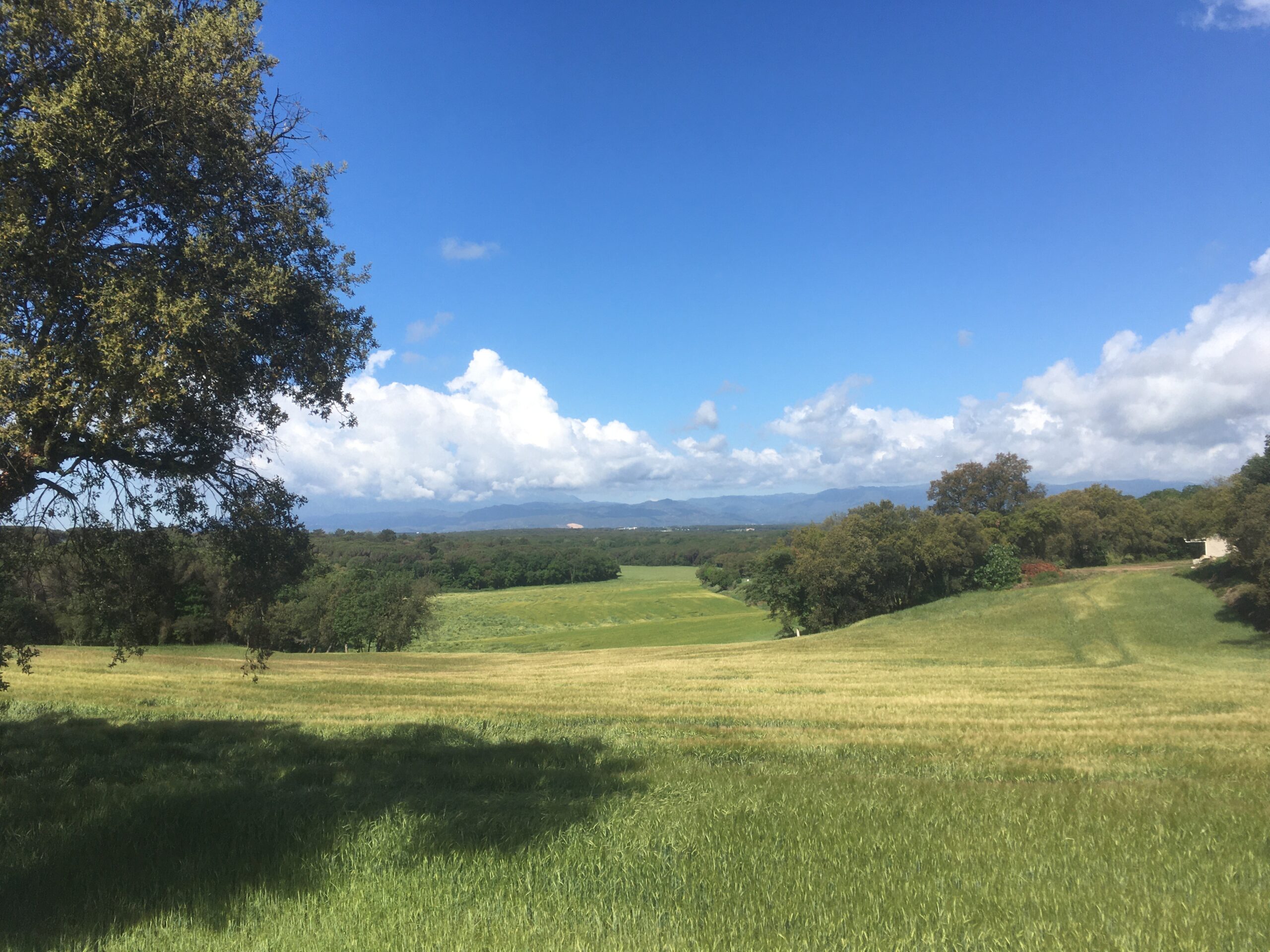

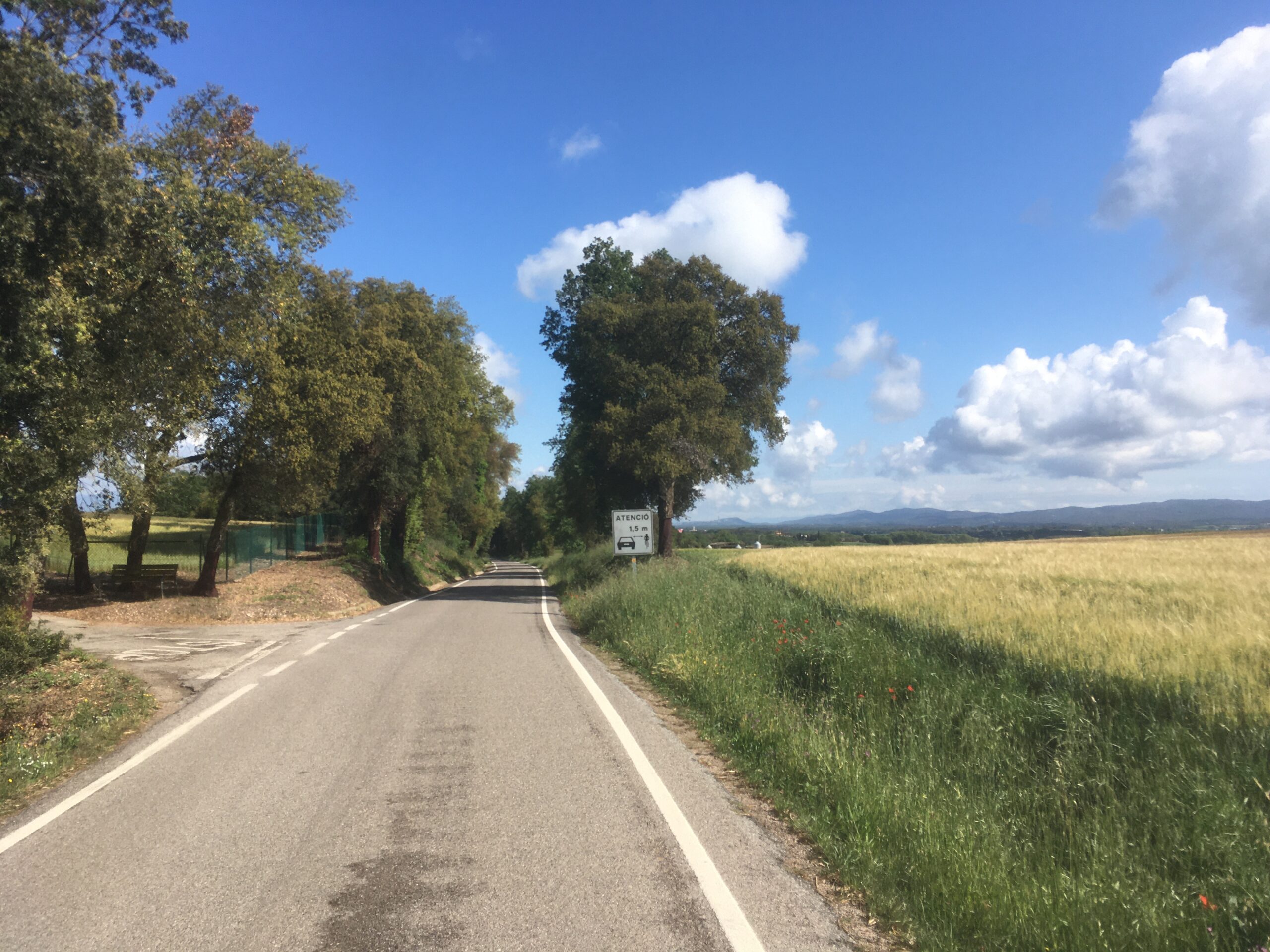
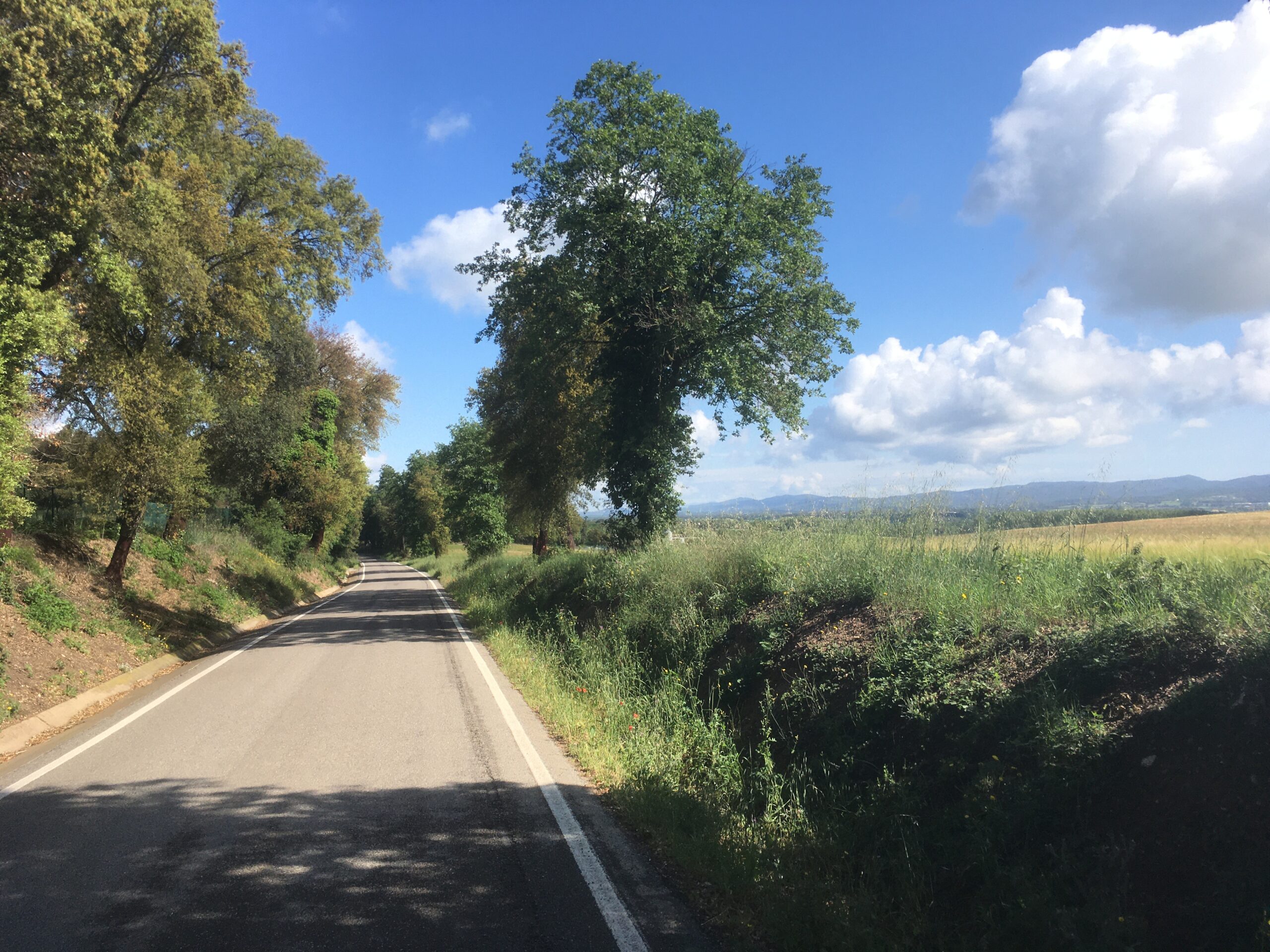
After lunch, I continued north from Girona towards Figueres. I chose to take the most direct route by following the highway N-II. Although less scenic than the small country roads I’d followed earlier in the day, progress was fast, as I did not have to focus on navigating and could just pedal. After reaching Figueres, I left highway N-II to once again follow small country roads from village to village towards the Col de Banyuls, the mountain pass where I would cross from Spain into France. After a few hours, I passed through the last Spanish village that I would encounter on this trip, Espolla, and started my ascent into the mountains.
The windy road from Espolla to the Col de Banyuls soon started climbing rapidly. There were many sections with up to 10% grades, which made progress quite slow and tiring. My bicycle only had six gears, with even the lowest gear not being very forgiving, so this quickly put my muscles to the test, exacerbating the aching I’d felt in my knees since starting the trip. As I continued to climb, light rain was joined by gusts of wind so strong that I sometimes had to get off my bike and push it up the road. As I reached the Col de Banyuls, things became truly unpleasant: I was met with near-freezing weather, and consistent rain.
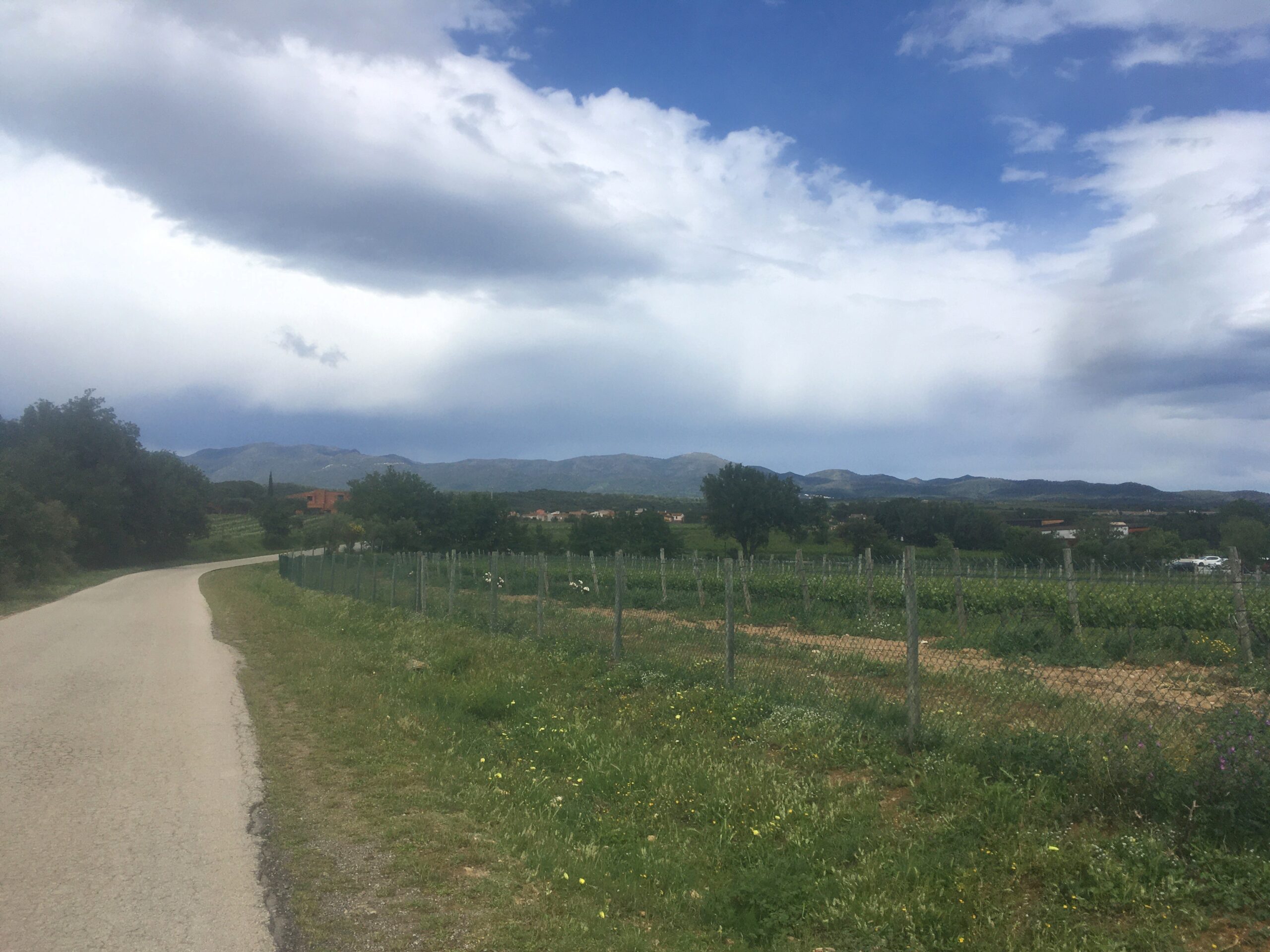
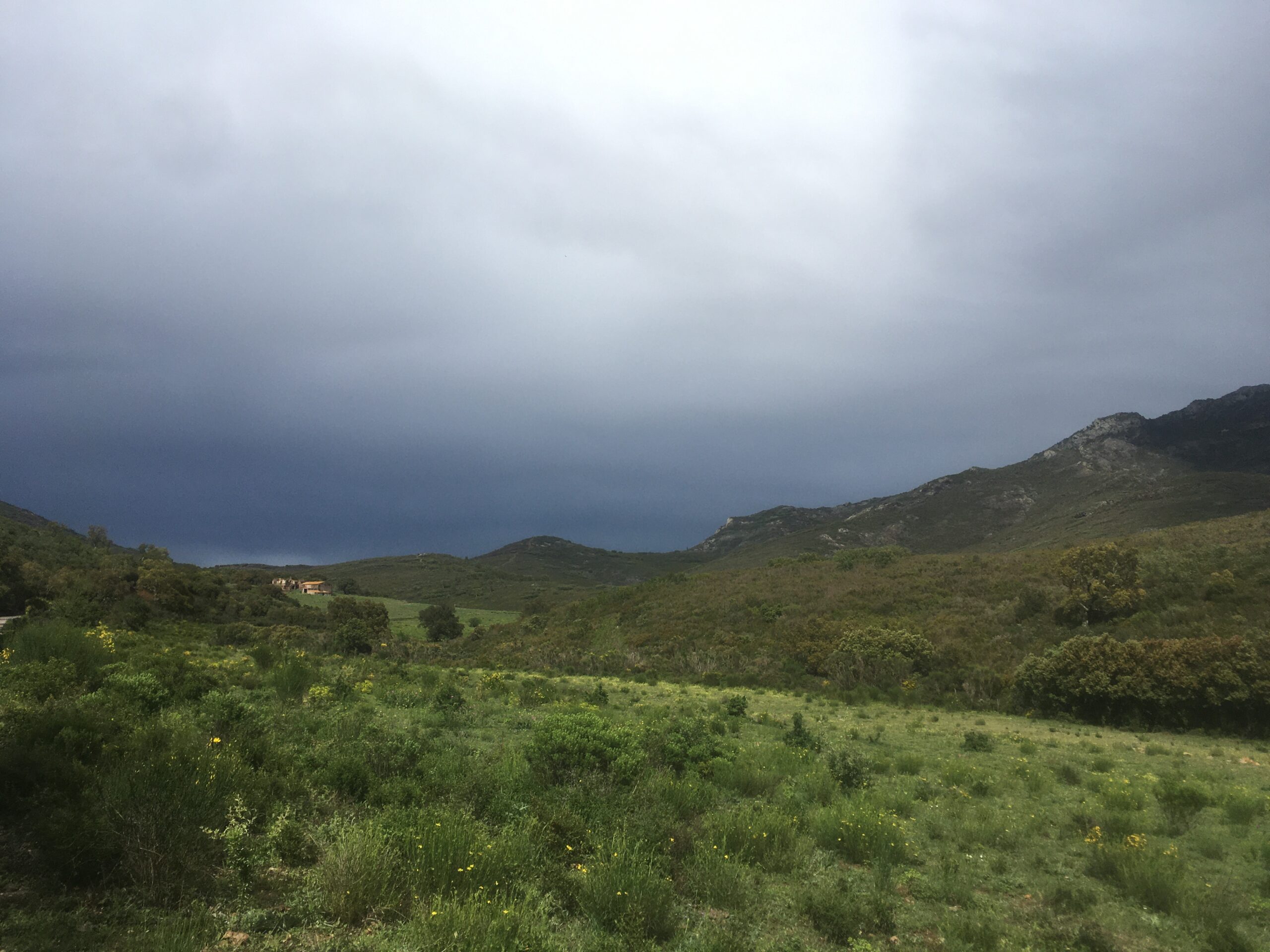
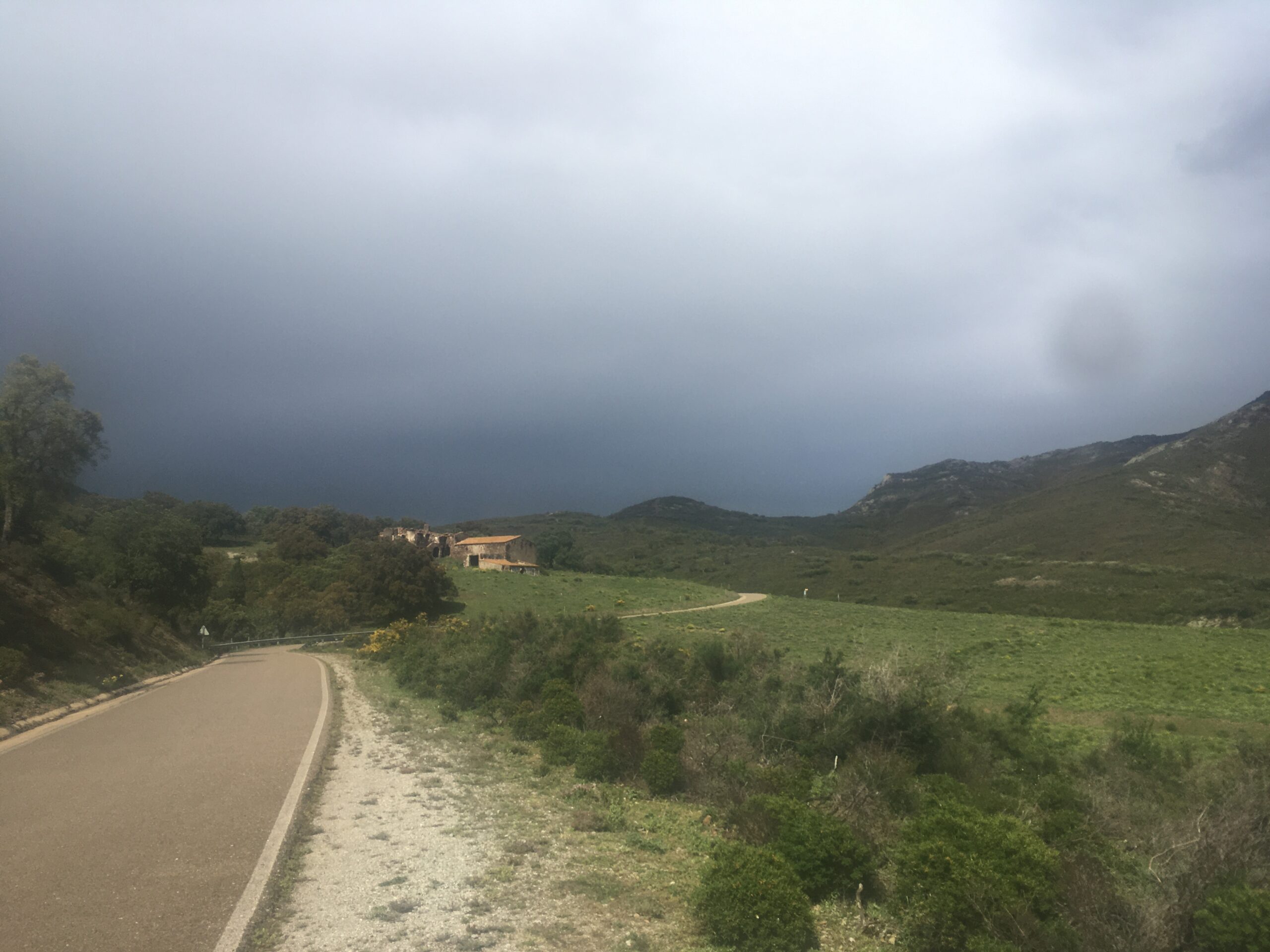
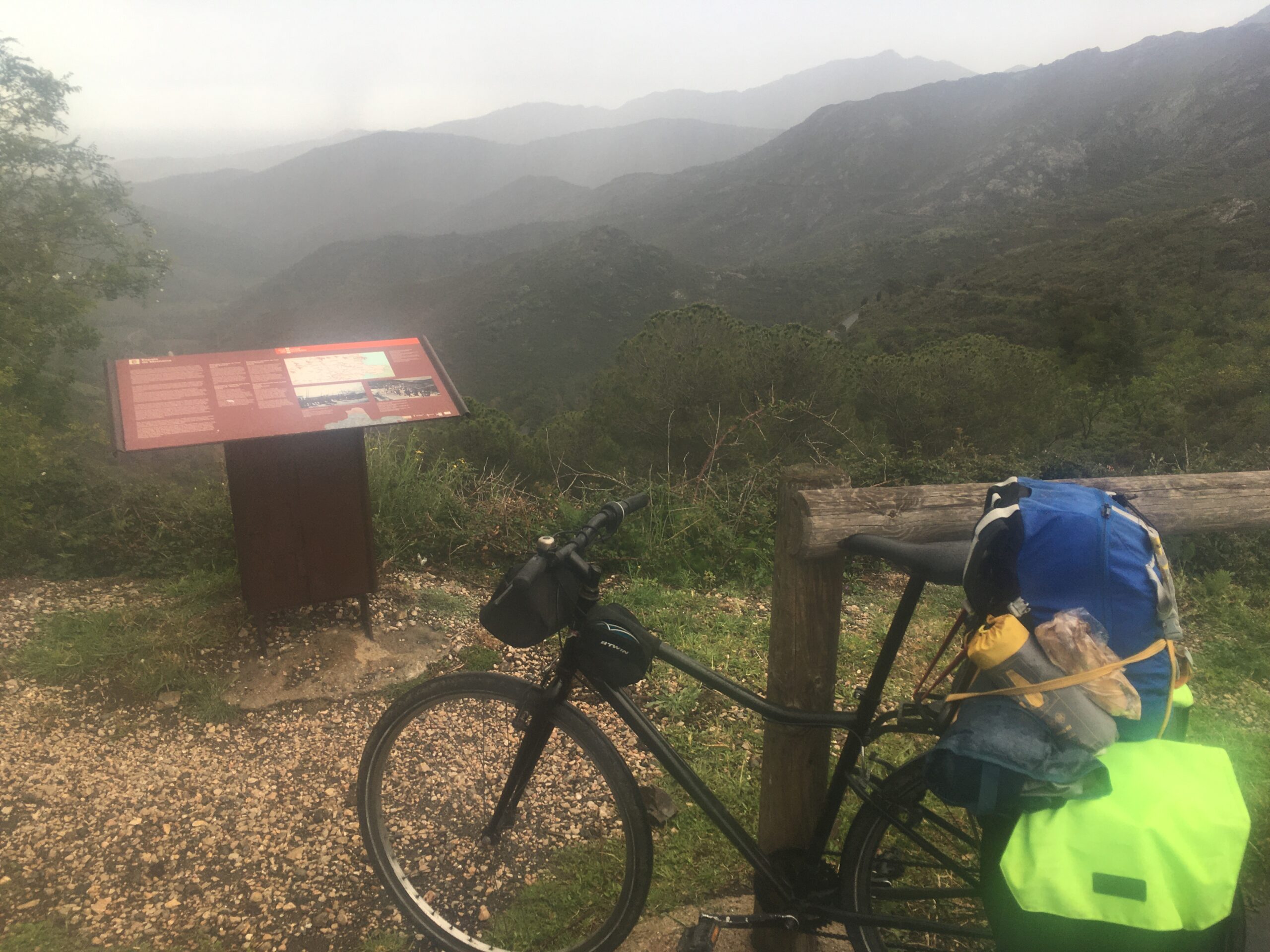
Being dressed in a light athletic t-shirt and biking shorts, I was shivering and quite miserable as I stood at the top of the mountain pass, with Spain behind me and France in front of me. There was no shelter available, so I had no choice but to continue, slowly starting my descent down the mountain through the cold rain. After about fifteen minutes of creeping down the wet, steep, curvy road carved into the mountain, I arrived at a small village, Mas Parer. After having endured a rainy, cold afternoon of cycling through the mountains, which I wanted to end as quickly as possible, I made the mistake of taking a shortcut that was suggested by Google: instead of going from Mas Parer towards the town of Banyuls-sur-Mer on the Mediterranean coast, and then heading north towards Port-Argèles, I decided to follow Google’s suggestion of taking small local roads that would allow me to reach the rural road D86, which provided a much more direct route to Port-Argèles. Unfortunately, I soon found out that most of this route didn’t really exist, or at least, not anymore.
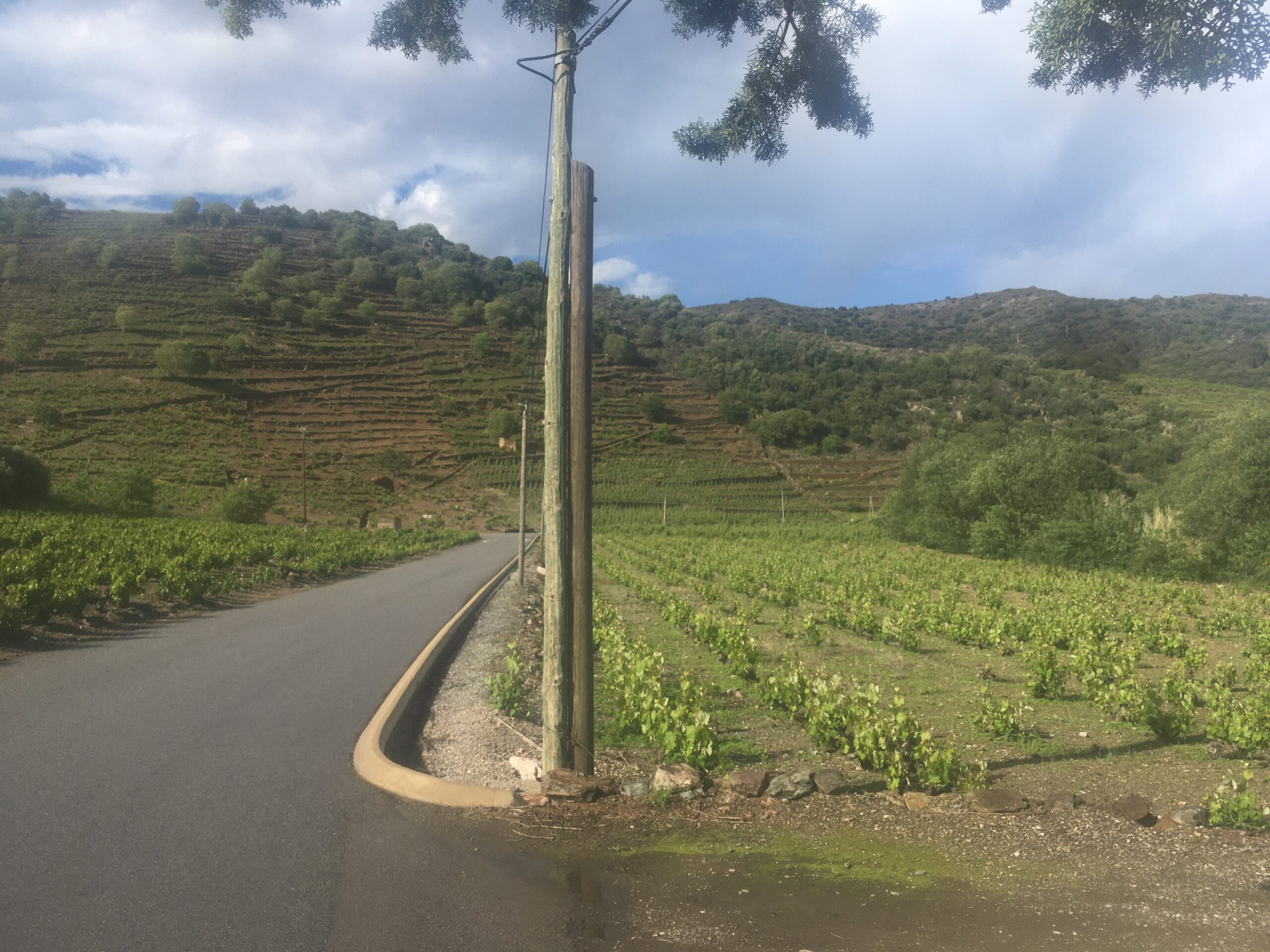
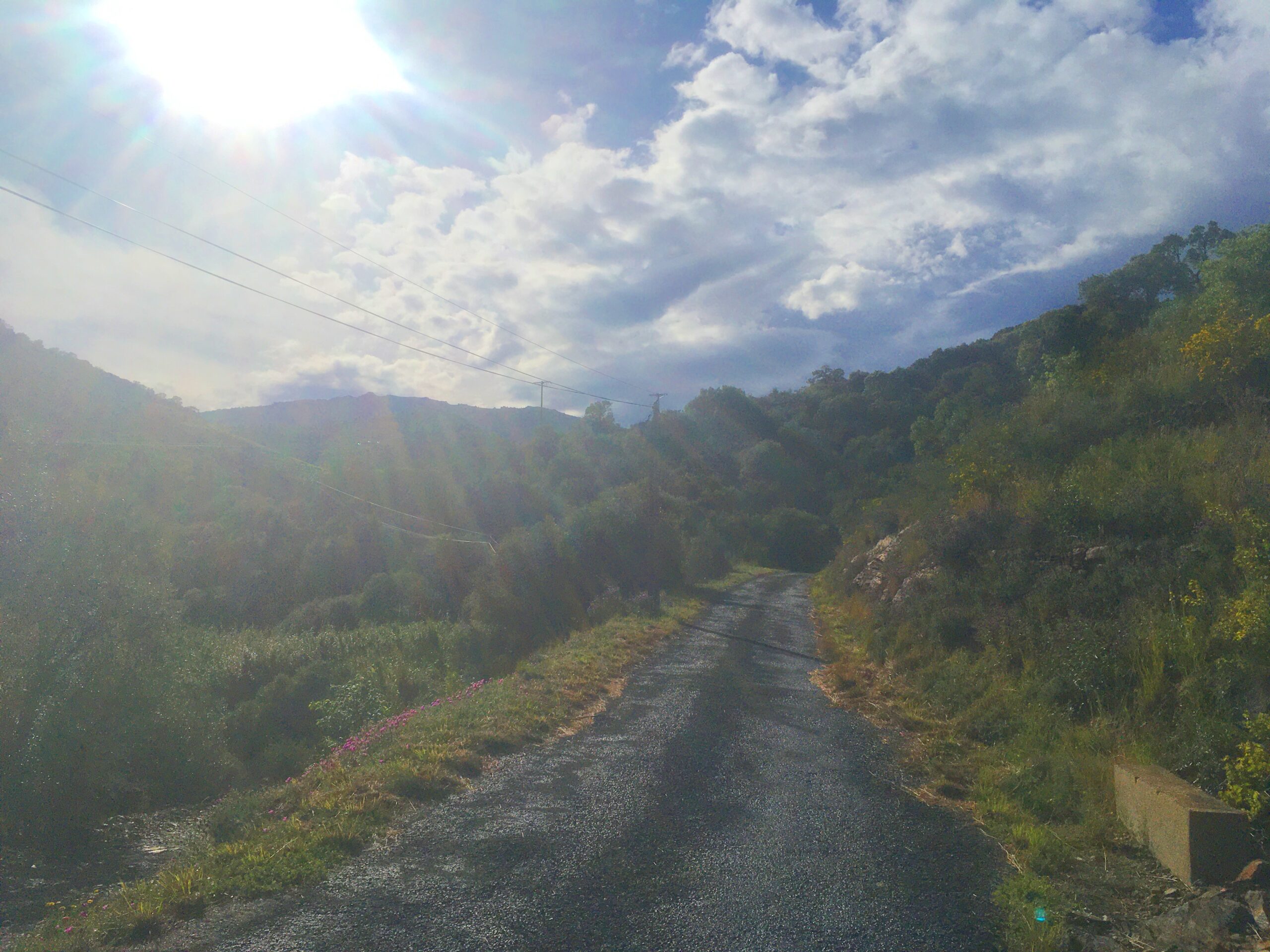

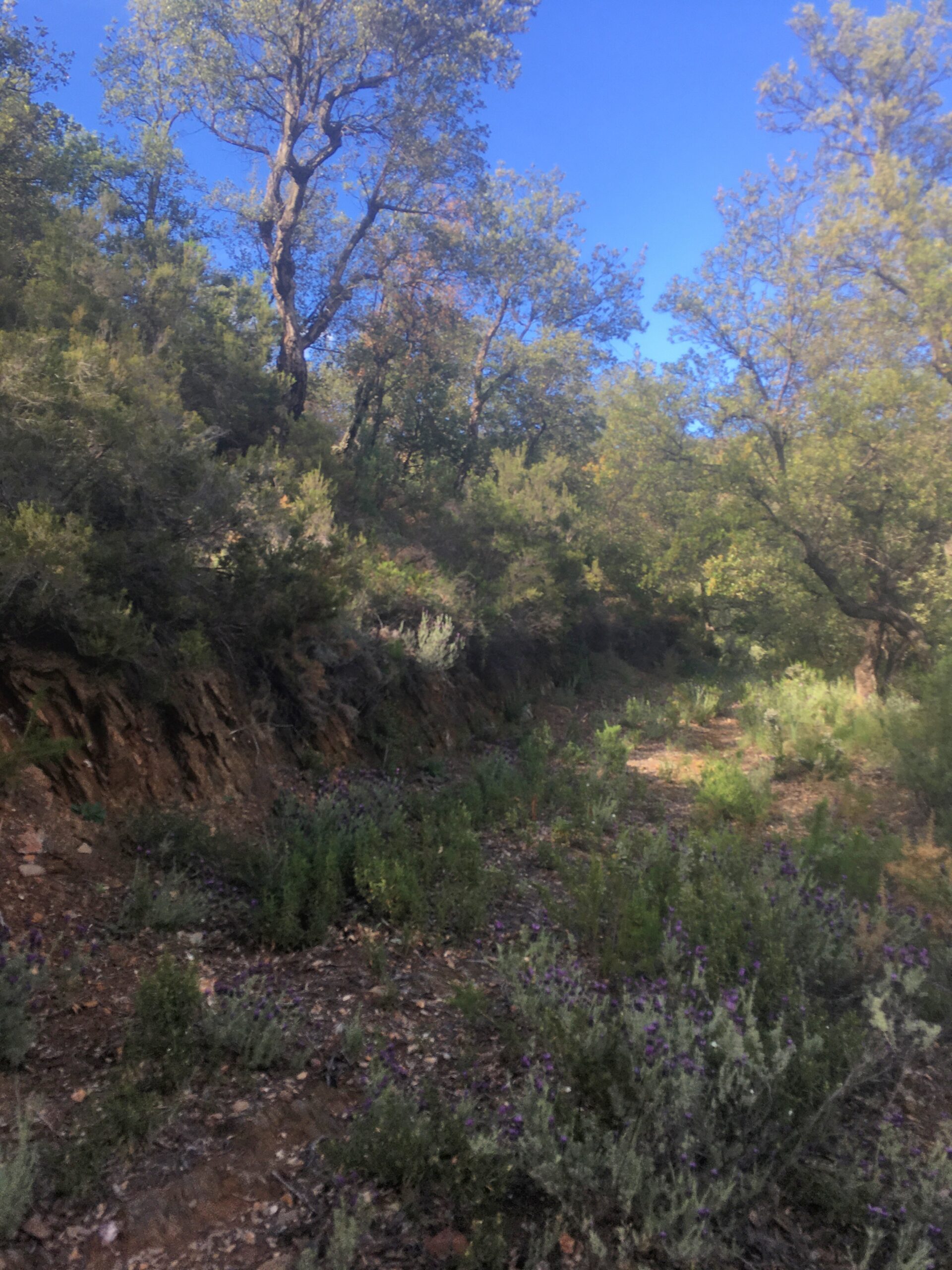
My best guess is that some government road network map still included this path as some kind of trail, and that online mapping solutions interpret it as a navigable road, which it certainly isn’t. In any case, after riding over dirt and rocks and through mud until finally reaching a road which was truly impracticable on a bicycle, I cursed for while, returned to the village of Mas Parer, then took the less-dubious road heading towards the coast, which saw me reach Banyuls-sur-Mer in just a few minutes.
Being wet and tired, I decided to treat myself to a hotel room that night instead of searching out the local municipal campground. After laying out my clothes to try, I wandered around the town until I found a small Italian restaurant for dinner, then headed back to the hotel room to rest.
Day 3: Banyuls-sur-Mer to Narbonne, ~105 kilometres
On this third day, I had an ambitious plan: I would follow the coast all the way from Banyuls-sur-Mer to Sète, where I would stay in a hostel. Despite the long distance of almost 180 kilometres, I was confident that I would be able to finish it without much trouble: the route remained close to the coast, and there were minimal variations in elevation, so I didn’t expect it to be physically taxing. In addition, as it followed part the EuroVelo 8 route, navigation would be easy.
I left my hotel shortly before 10 AM, and started riding along the departmental roads that remained near the coast. The terrain was not flat for the first few hours of riding, but I knew that it would flatten out as I moved away from the Pyrenees. However, I had underestimated the difficulty that would be posed by the wind: it was an incredibly windy day, with the wind blowing fiercely against me and slowing my progress.
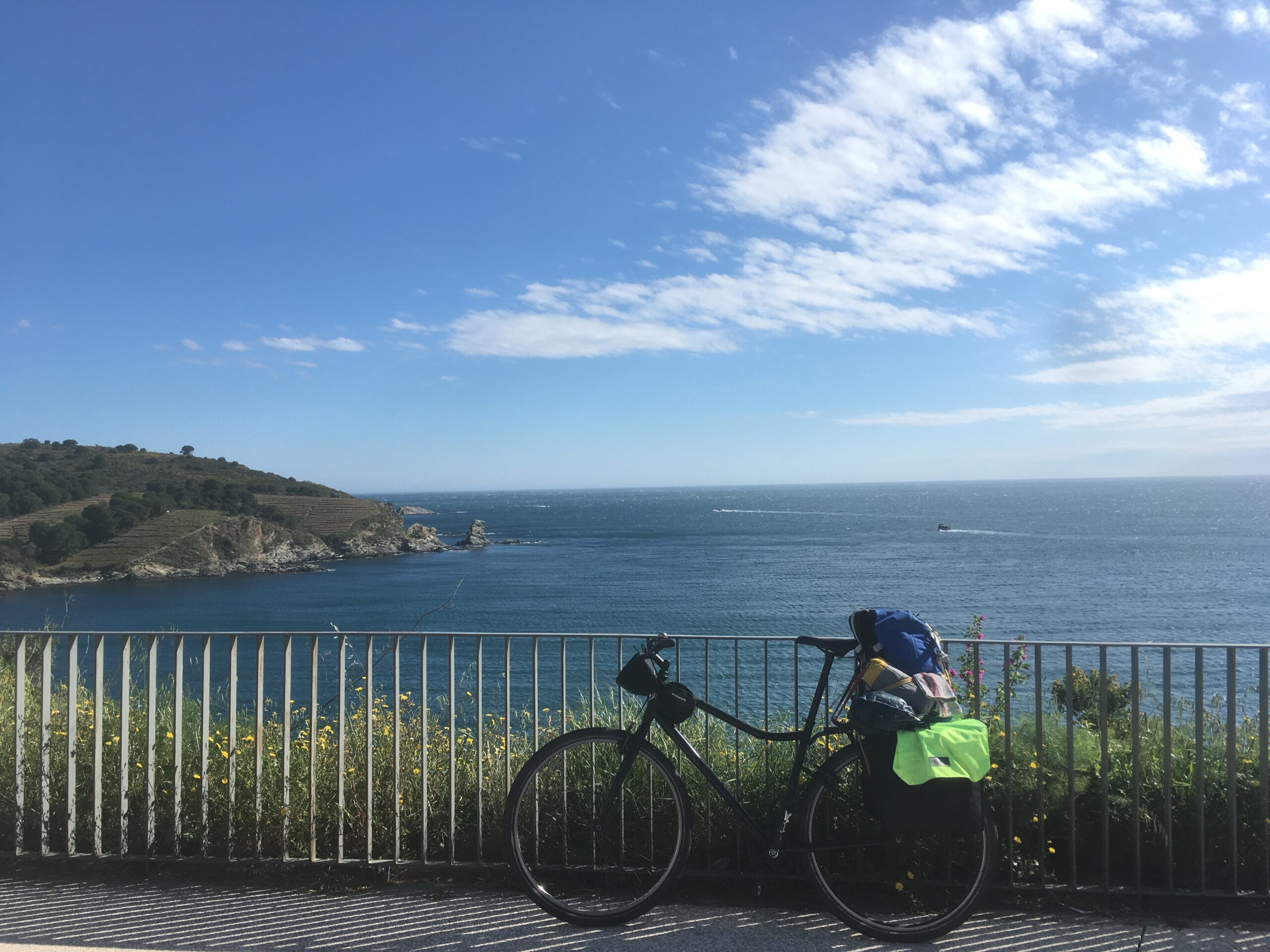
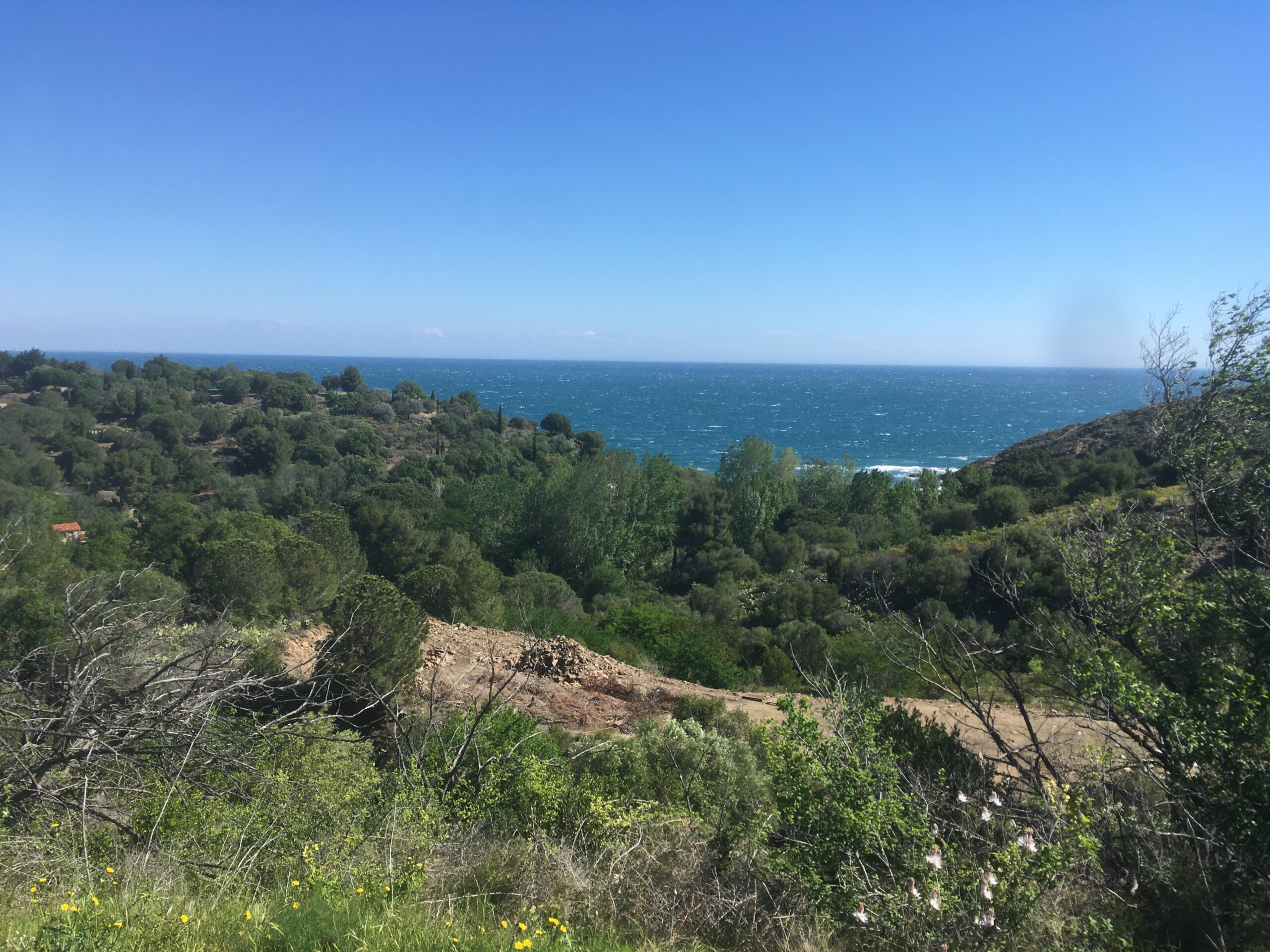
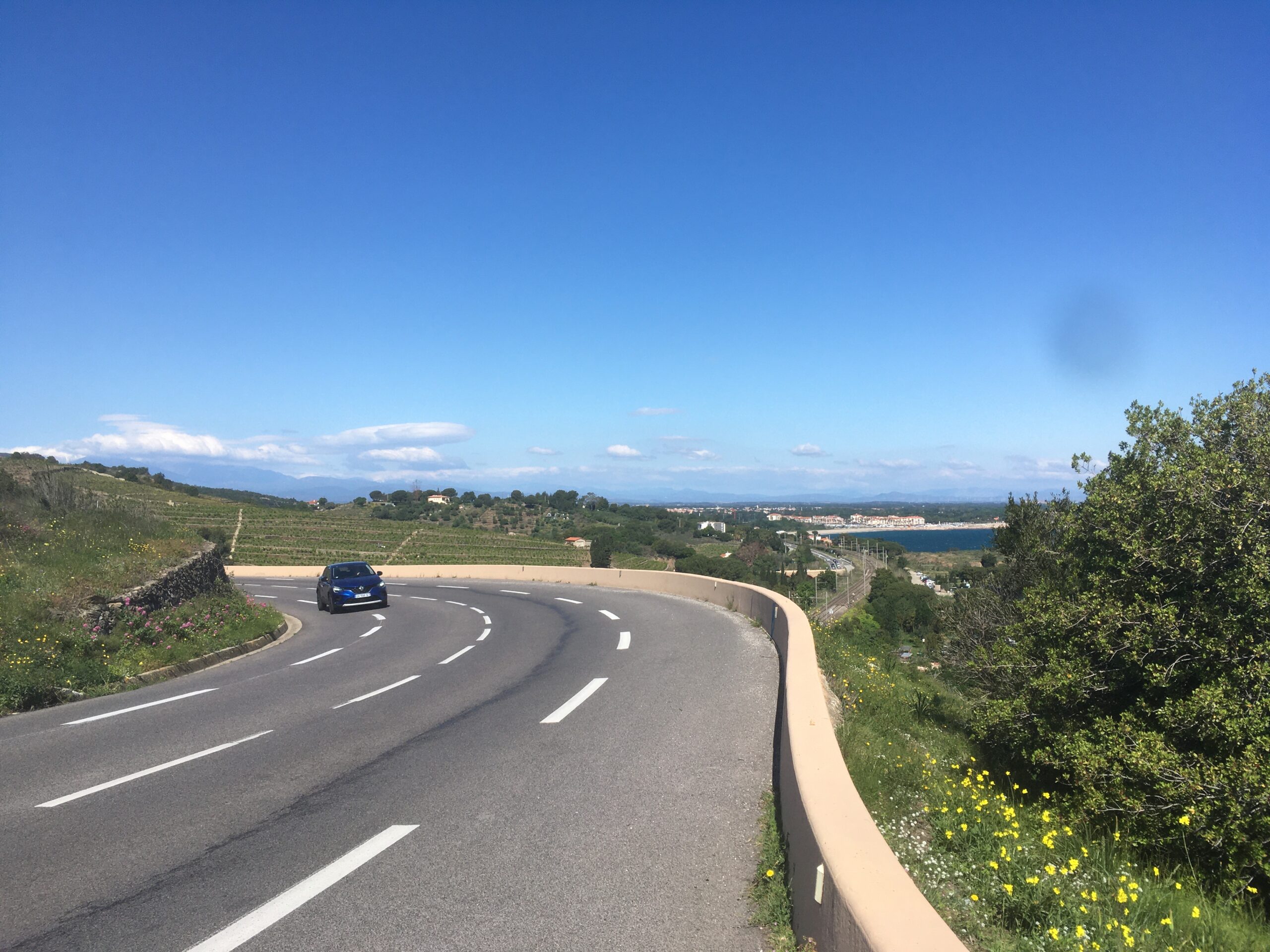
After a couple of hours, the terrain flattened out as the rocky coastline turned into sandy beaches, but my progress did not speed up, as the flat environment provided no shelter from the strong wind coming from the Mediterranean. I was falling behind my target speed, but hoped that the wind would die down and allow me to still reach Sète that evening. I stopped for lunch at Canet-en-Roussillon, feasting on canned tajine, chick peas, and potato chips from a small grocery store.

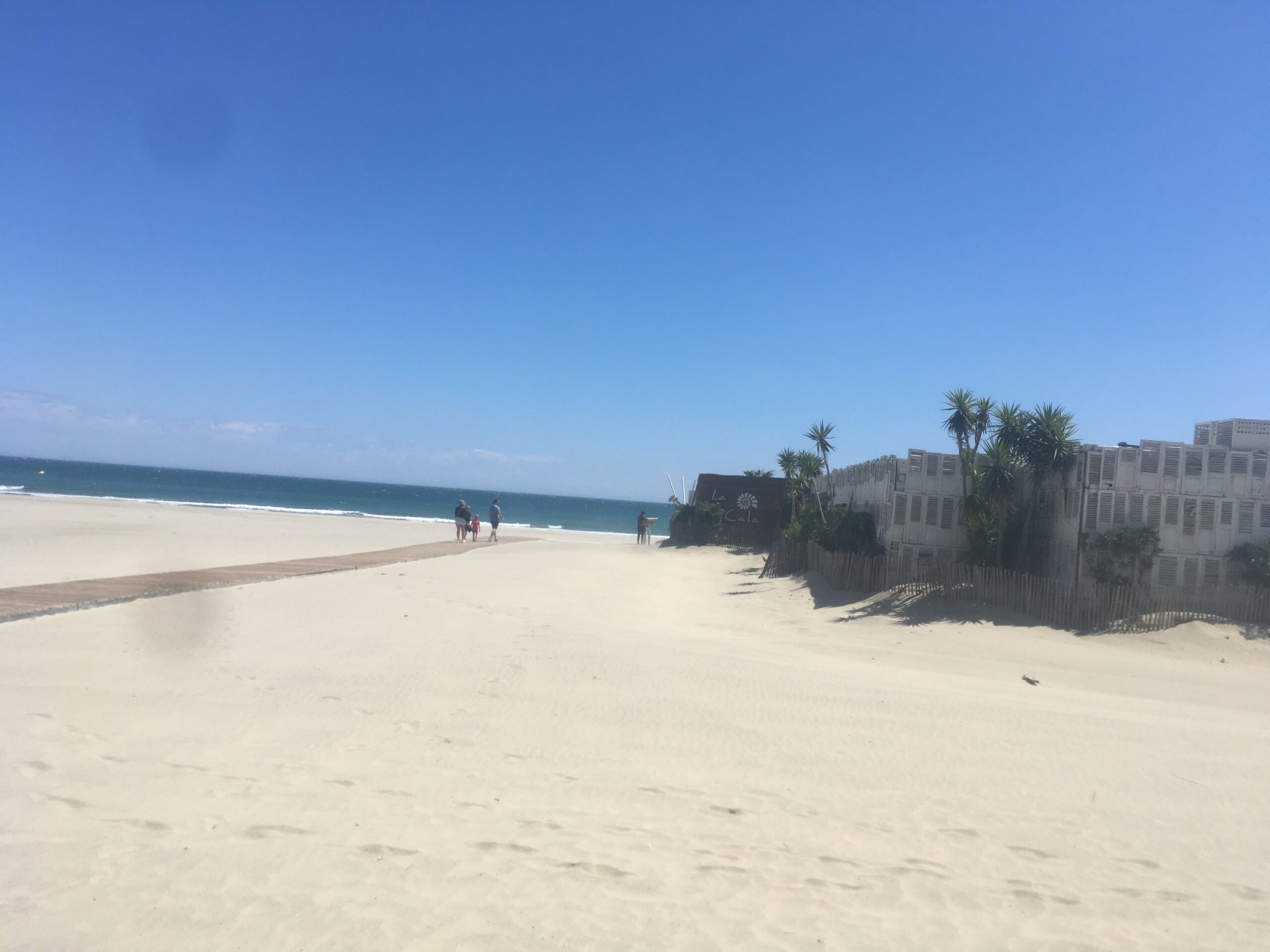
After eating my lunch, I made the mistake of visiting one of the self-cleaning automatic toilets in Canet-en-Roussillon close to the beach. I found out an an inopportune moment that the sensors that allow it to detect when someone is inside it were defective: as soon as I started doing what I needed to do, the self-clean cycle activated, a disgusting experience that required me to visit a nearby restaurant and ask to use their toilet to clean myself off. I spent a few moments cursing the city of Canet-en-Roussillon for the toilet’s poor operational state, then continued on my way.
Over the next few hours, the scenery changed frequently, including sandy beaches, rocky areas, and some areas with lots of bushes in what seemed like swamps. Often, the EuroVelo route would separate from the road, only to rejoin it soon afterward. However, there were some sections where the route had not yet been clearly defined, and one of these started just north of the town of Leucate, heading towards the town of Port-La-Nouvelle. On the EuroVelo site, no real route was indicated, with just a straight line from the Leucate’s train station towards Port-La-Nouvelle that seem to follow any road. Apparently, the recommended option for this route, for which there is no safe road and no clear cycle path, is to simply take the train for a few kilometres, but given that this wasn’t explicitly stated anywhere, I simply followed Google’s cycling directions from Leucate to Port-La-Nouvelle. This took my across a bridge onto an almost-peninsula connecting the two towns, but separated from the rest of the mainland by giant ponds, which themselves were slightly separated from the sea. This landmass had no roads on it, only some trails that seemed to be used mostly for walking or riding horses, yet these were the trails that Google suggested I take.
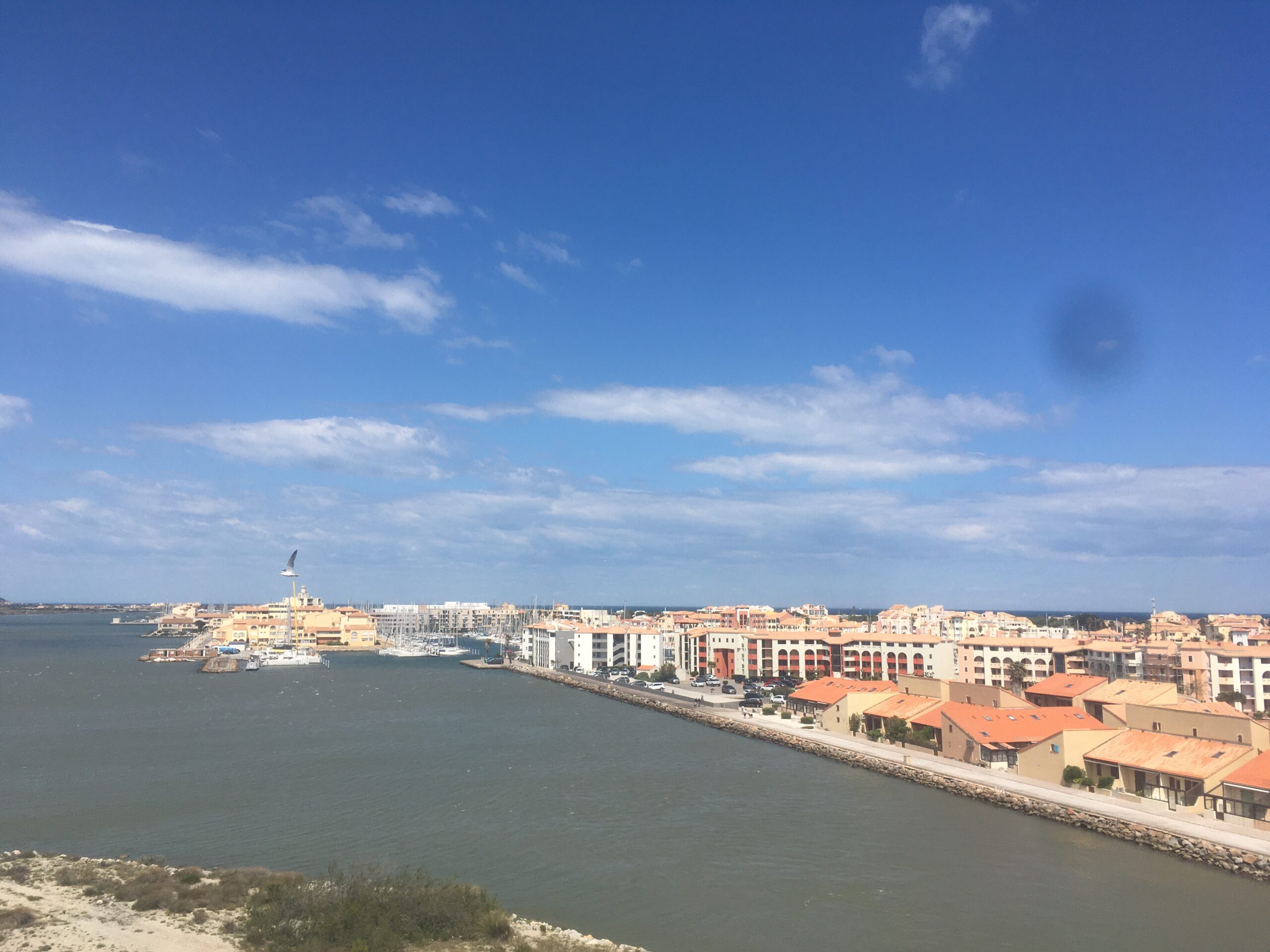
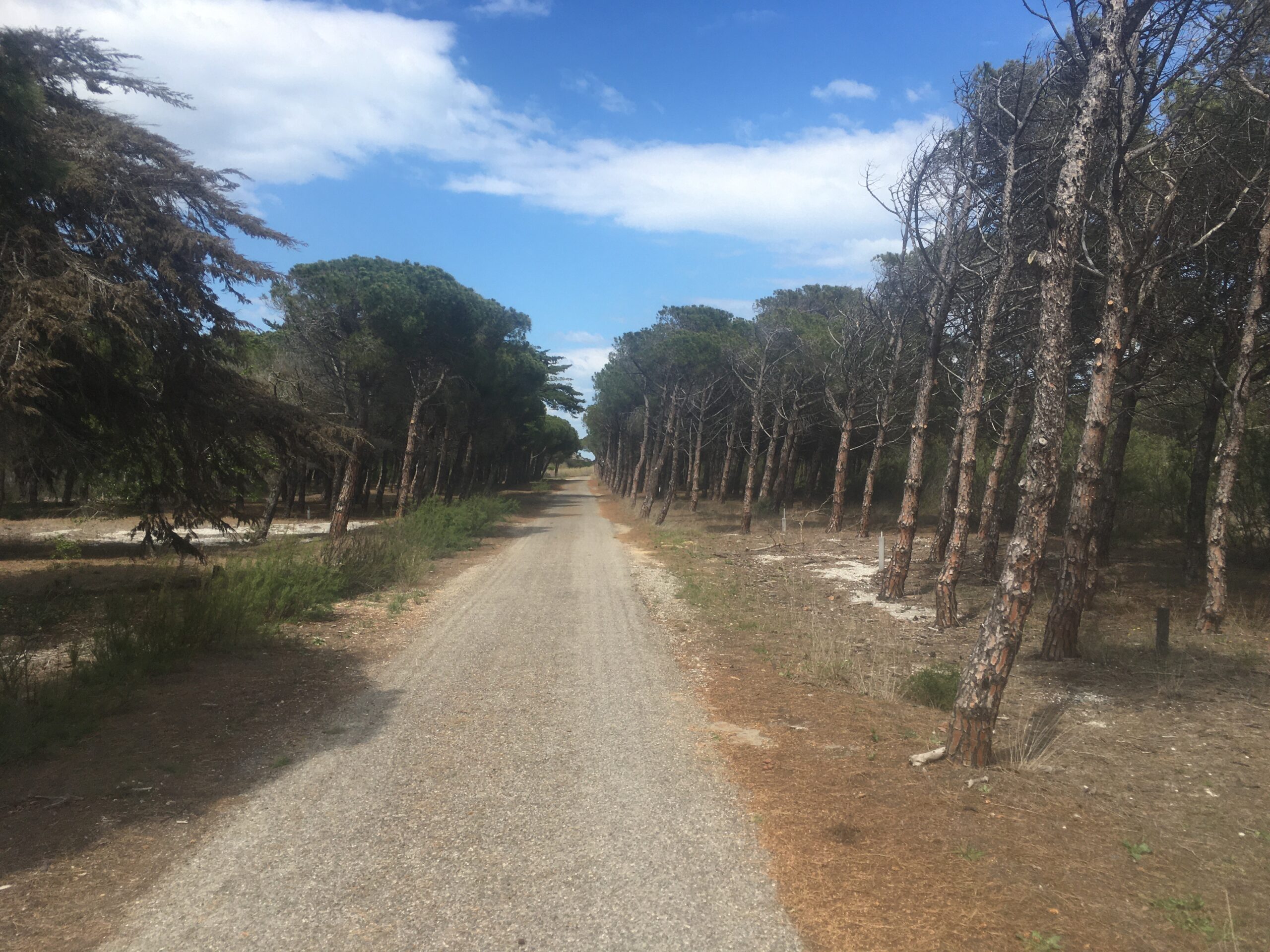
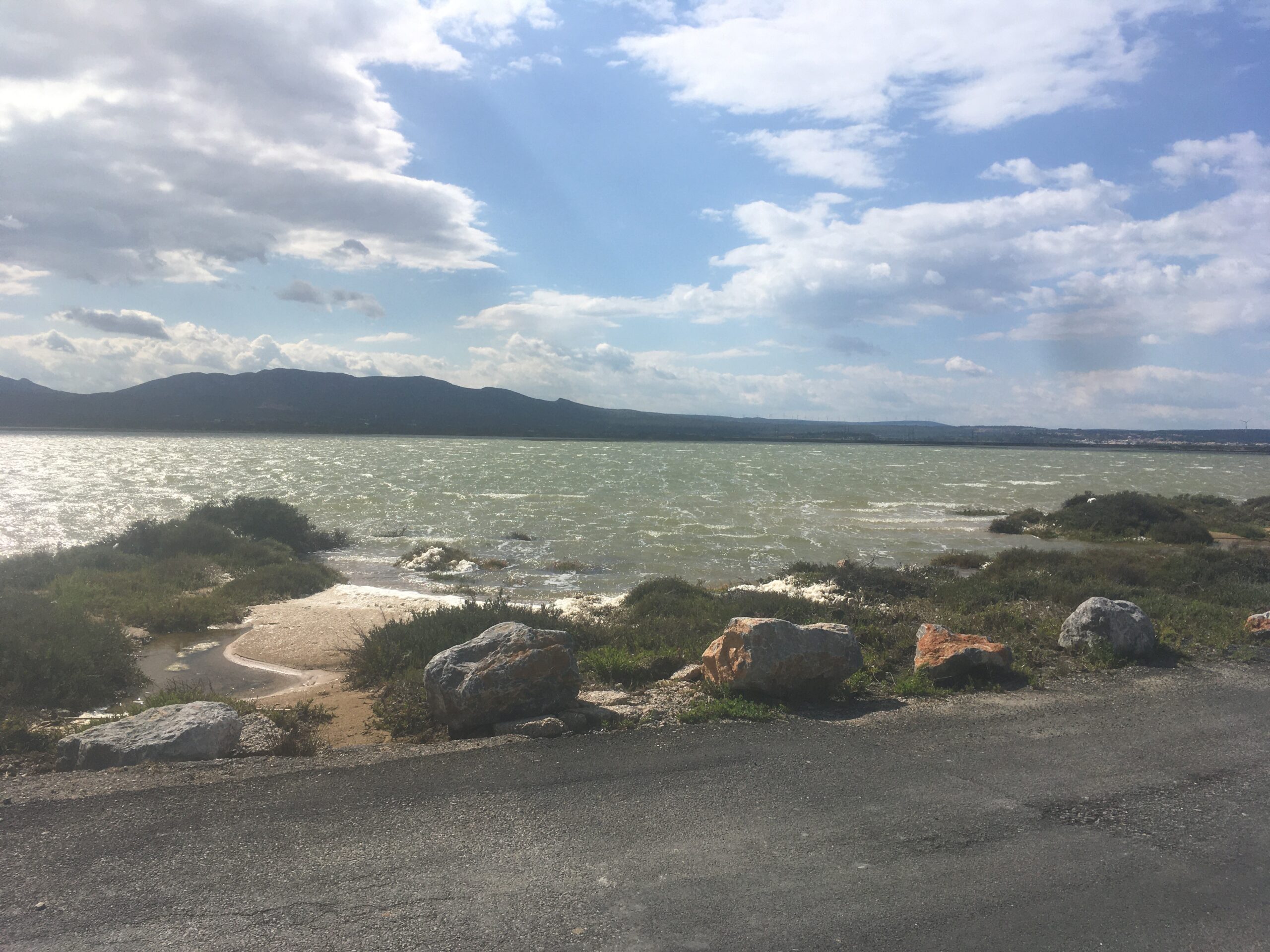
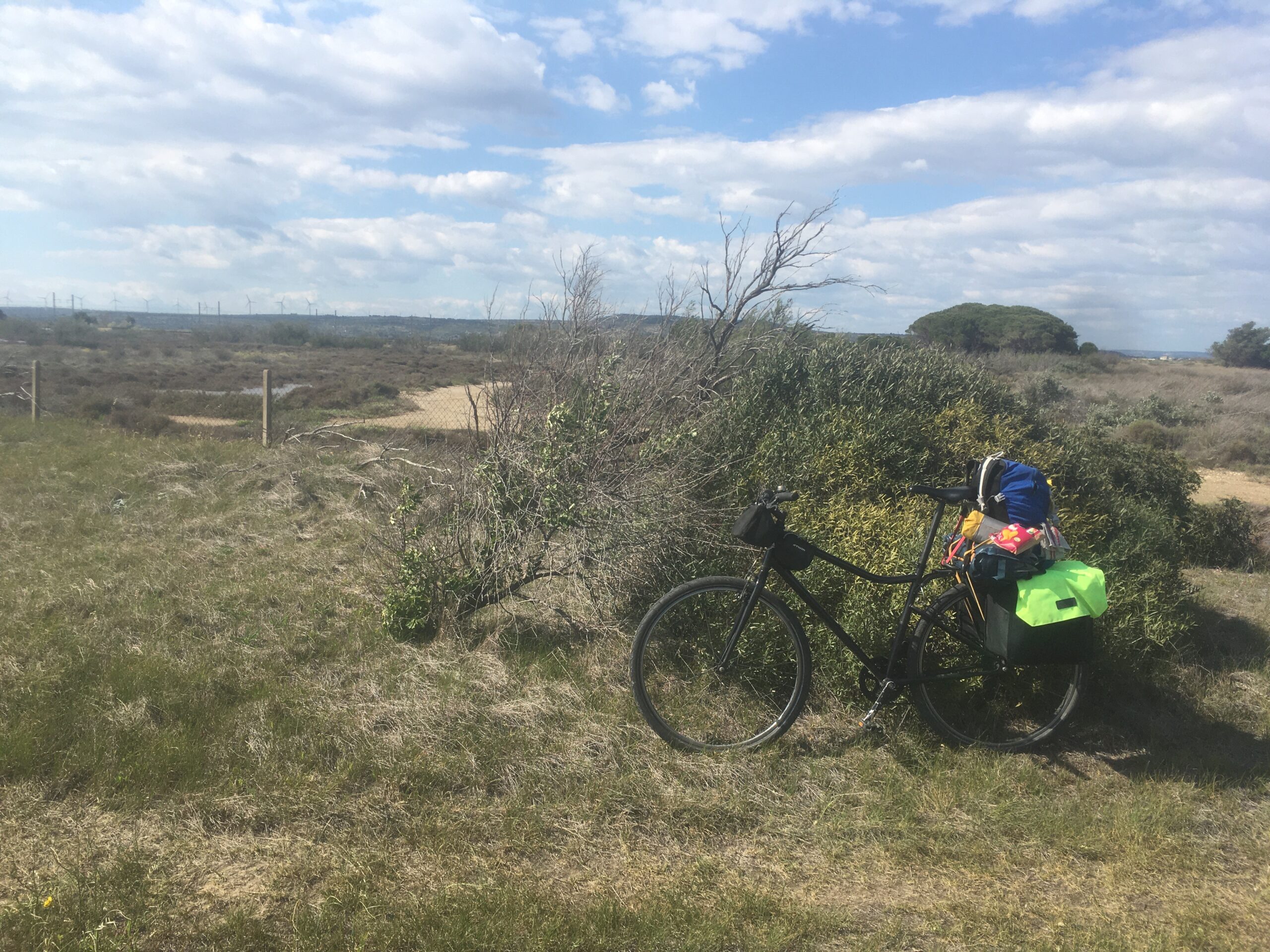
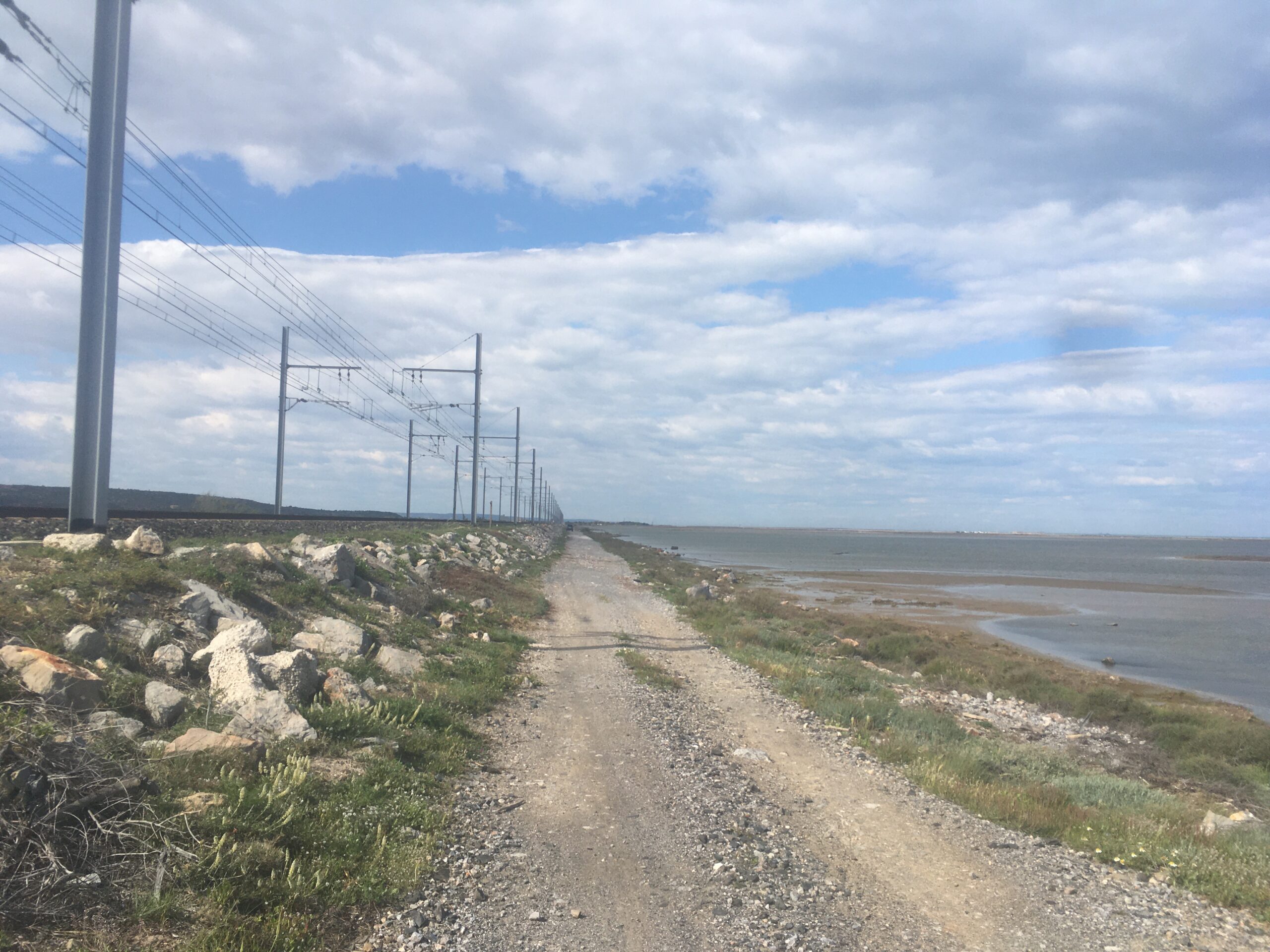
By the time I reached Port-La-Nouvelle, it was very clear that I had no chance of getting to Sète that night, as I had already been travelling for almost eight hours but had only covered about half of the required distance. So, I found a very cheap hotel on the outskirts of the city of Narbonne, which I’d be able to reach in about two hours, and started making my way there.
The EuroVelo 8 route showed a path that followed some trails on the narrow bridges of land that divided some large ponds next to the Mediterranean, but having little faith in its instructions on this stretch of the route following the previous problematic crossing between Leucate and Port-La-Nouvelle, I decided to stick with routes that I knew would be navigable, so I headed west from Port-La-Nouvelle along the departmental route D6139, which would take me to route D6009 heading towards Narbonne. I was surprised that D6139 was not forbidden to cyclists, as it was a four-lane separated highway with speed limits sometimes reaching 90 kilometres per hour. I definitely felt uncomfortable riding along it, but given the late hour in the day, I couldn’t afford to waste further time attempting to find other routes that might – or might not – be better.
Eventually, I reached route D6009, and headed north to Narbonne. To avoid the rather unsafe highway, I diverted onto a small coastal road, passing through the villages of Peyriac-de-Mer and Bages.

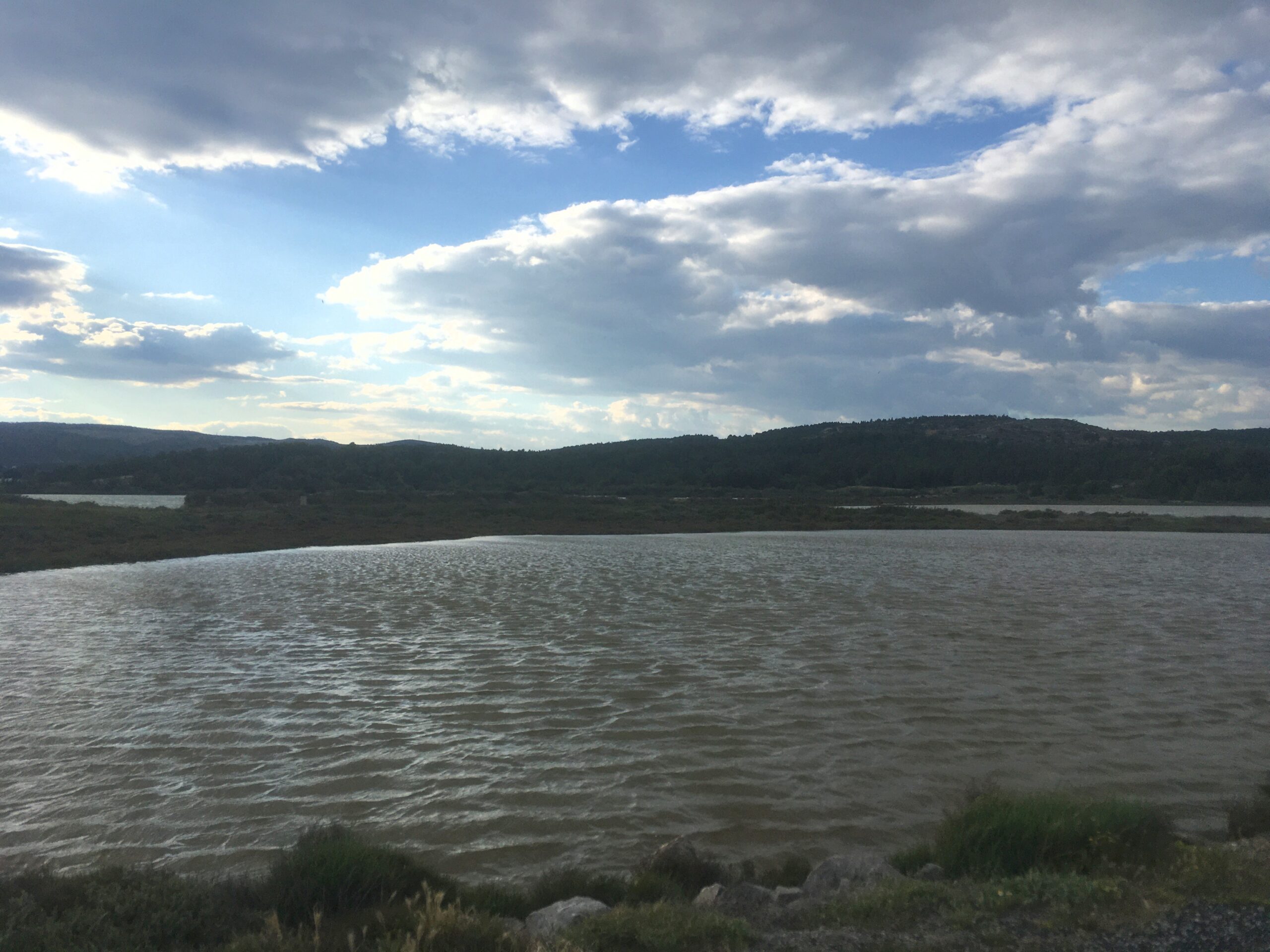
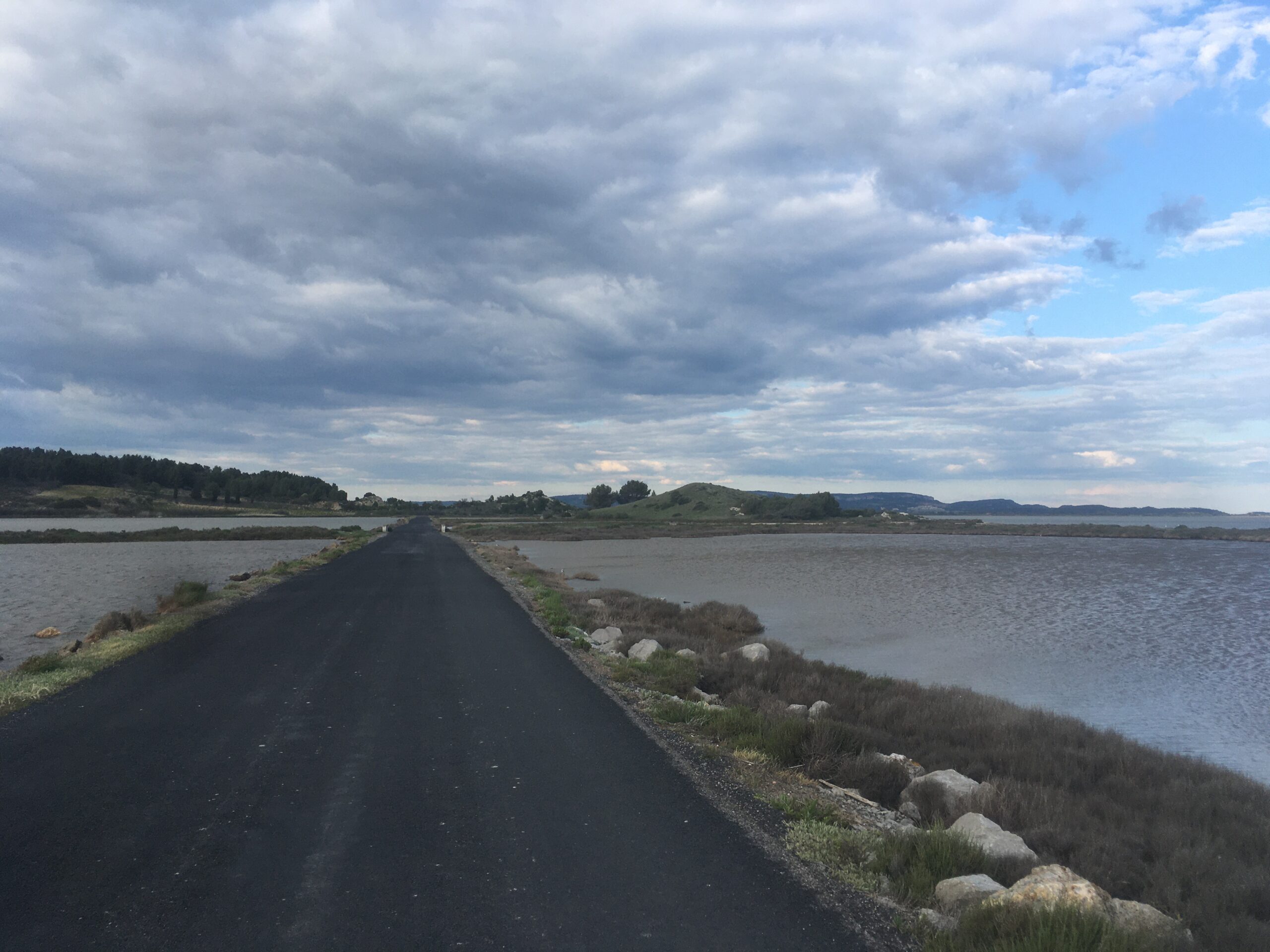
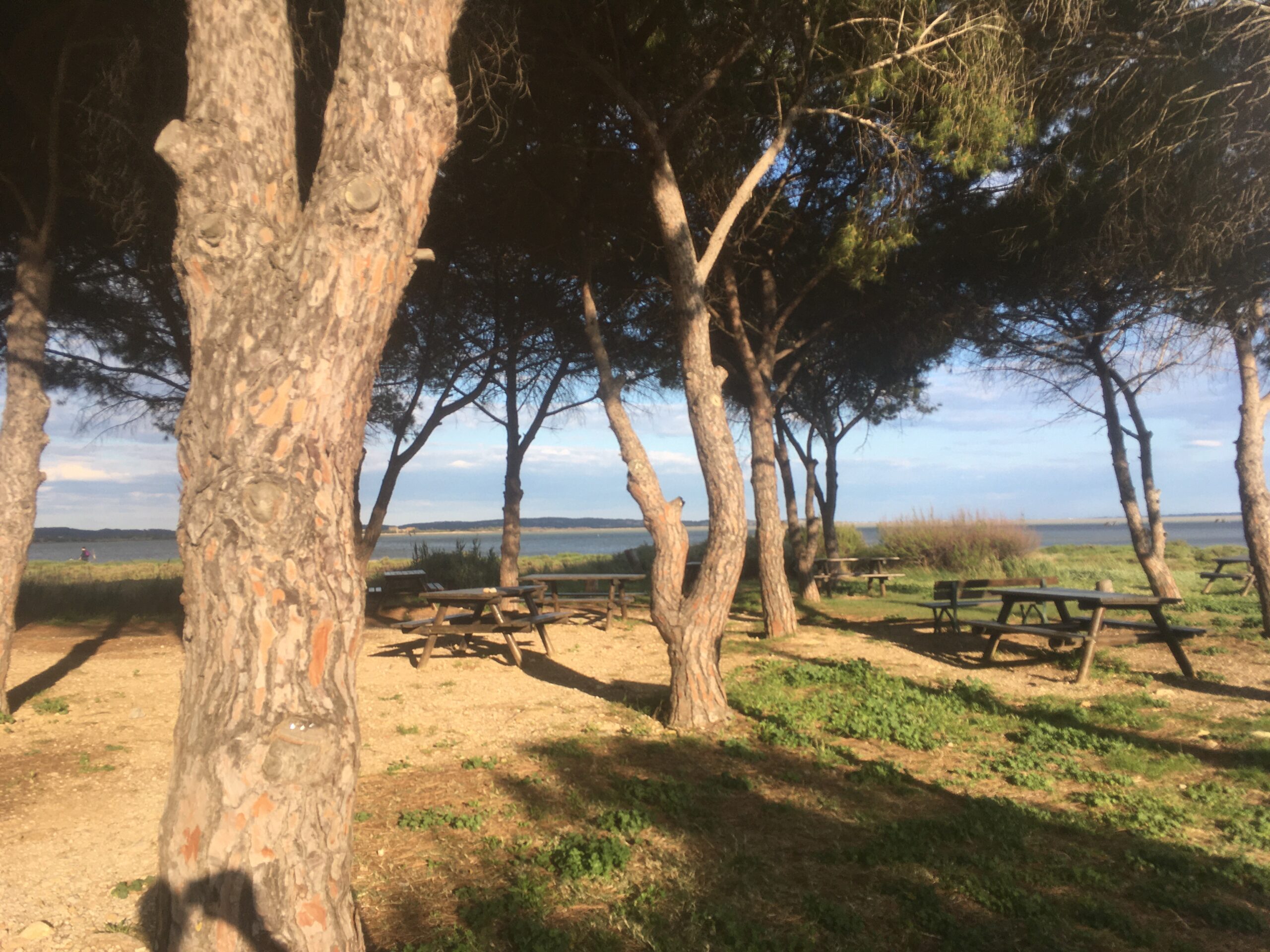
I finally reached my hotel at the edge of Narbonne just before 8 PM. During the time it took me to check in, all the grocery stores in the area closed, and there were very few restaurants nearby. I wandered around the area and found three options: a questionable all-you-can-eat buffet, a French Savoy-style restaurant based around cheese, and another place that seemed to be a pizzeria. I went to the pizzeria, which ended up seeming to be a bizarre mix between a restaurant and nightclub, playing 2000s-era pop (for example, the Black Eyed Peas) at an uncomfortably loud volume but with horrible audio quality. It sounded as though someone was streaming the Black Eyed Peas at a bitrate that would work over dial-up internet, and it was… awful. The food was oily, and the ambiance was bizarre (like a nightclub, but with only two occupied tables and nobody dancing), but I didn’t have many options.
After paying for my oily, cheeseless pizza, I returned to my room, sore from the long day of pedalling against the wind, and examined my progress. I had barely averaged a disappointing 10 kilometres per hour. Still, I was able to relax, take a shower, and see things positively: it had been a beautiful day, and despite the dangerous roads I’d taken, I had arrived safely, and had a bed in which to sleep for the night.
Day 4 – Narbonne to Prades-le-Lez, ~120 kilometres
It was a beautiful day, and despite the discouraging previous day, I was excited to start pedalling away from Narbonne. After riding through the old city centre, I headed out of the northeast end of the city, and to my delight, found that my route mainly followed small roads winding through the vineyards of the region. I had decided to be easier on myself on this day, and that instead of fixing a specific objective (and subsequently being disappointed if I didn’t reach it), I would slow down and enjoy myself. This was easy: there was not much vehicular traffic, the weather was beautiful, and riding past the vineyards while listening to podcasts was very relaxing.
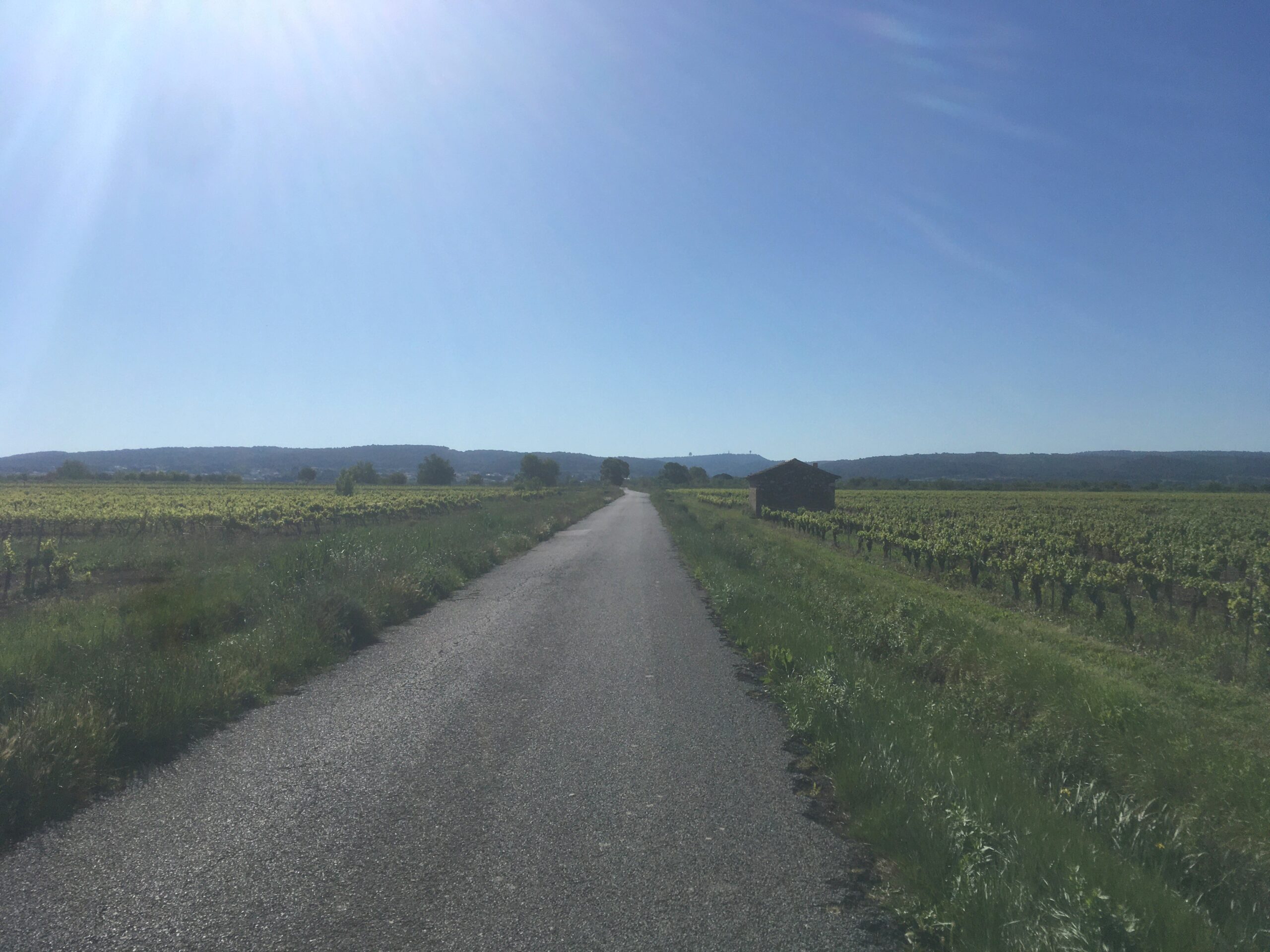
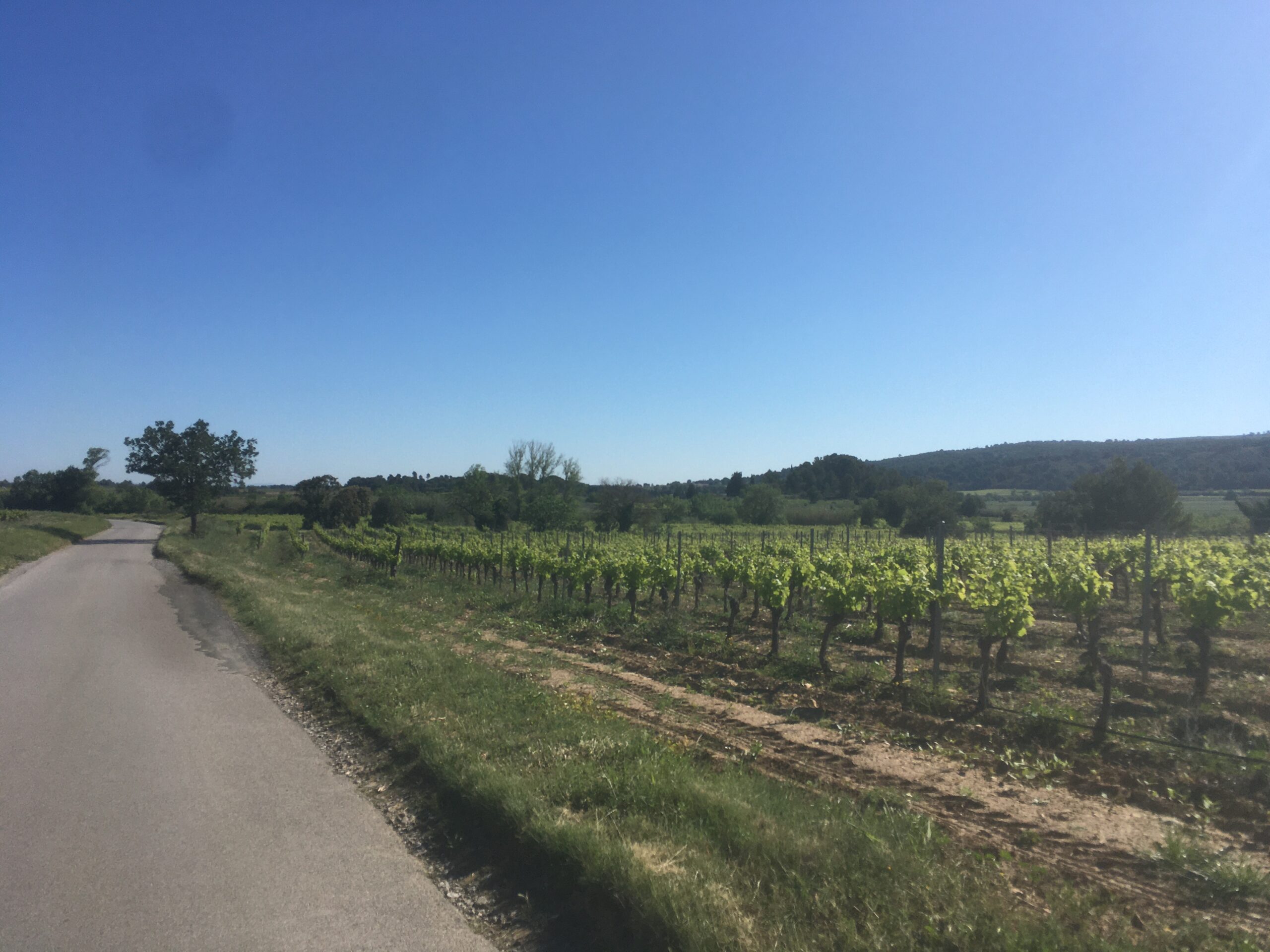
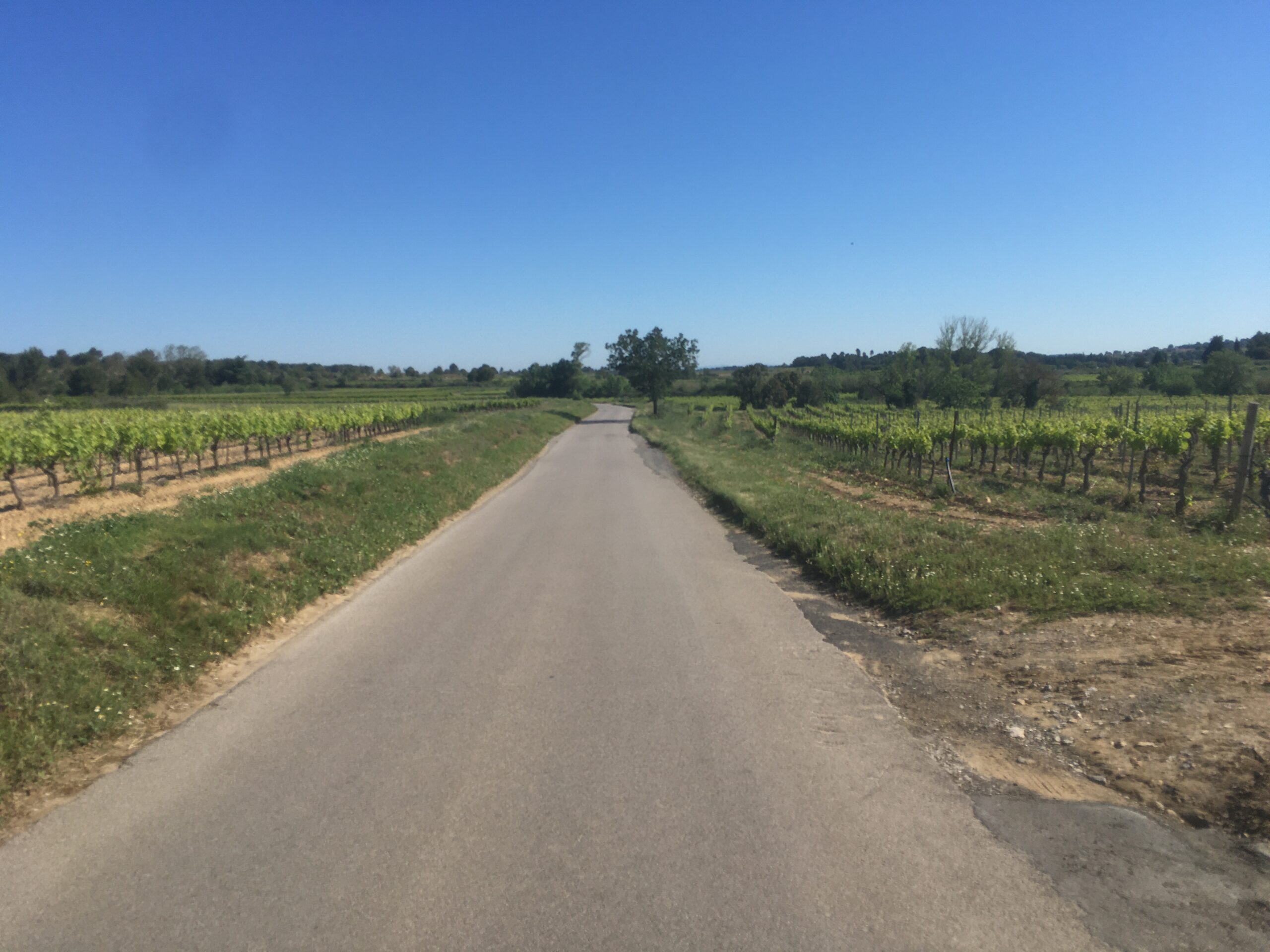
There were a few spots where Google took me onto very small, rocky roads running through fields, and although I often doubted whether these roads would be complete given my previous experiences in the Pyrenees, I usually had no trouble getting where I was going. However, at one point, while travelling over a rocky single-lane road going through some fields, I saw a cyclist approaching me in the other direction, with a bicycle almost as heavily-loaded as mine. It was at this point that I had the pleasure of meeting Niels, a German cyclist who, coincidentally, was also travelling the EuroVelo 8 route from Barcelona to Paris. Niels had taken the road that I was supposed to use, but found that it was impassable due to mud, so turned around – and thus saved me from the misfortune of having to do the same thing as him.
Niels and I decided to ride together for a bit, as we collectively decided on a set of roads to take, and continued heading northeast. It was great to hear about his experience travelling, and about his life in general. Although it was apparent that he spoke fluent English, we kept the conversation in French for a while, as he had learned French decades before, and he wanted to practice it. Travelling with Niels was nice, but we determined that our routes did not line up, so after sharing the road for a while, we said goodbye and parted ways. I stopped for lunch in the town of Portiragnes.
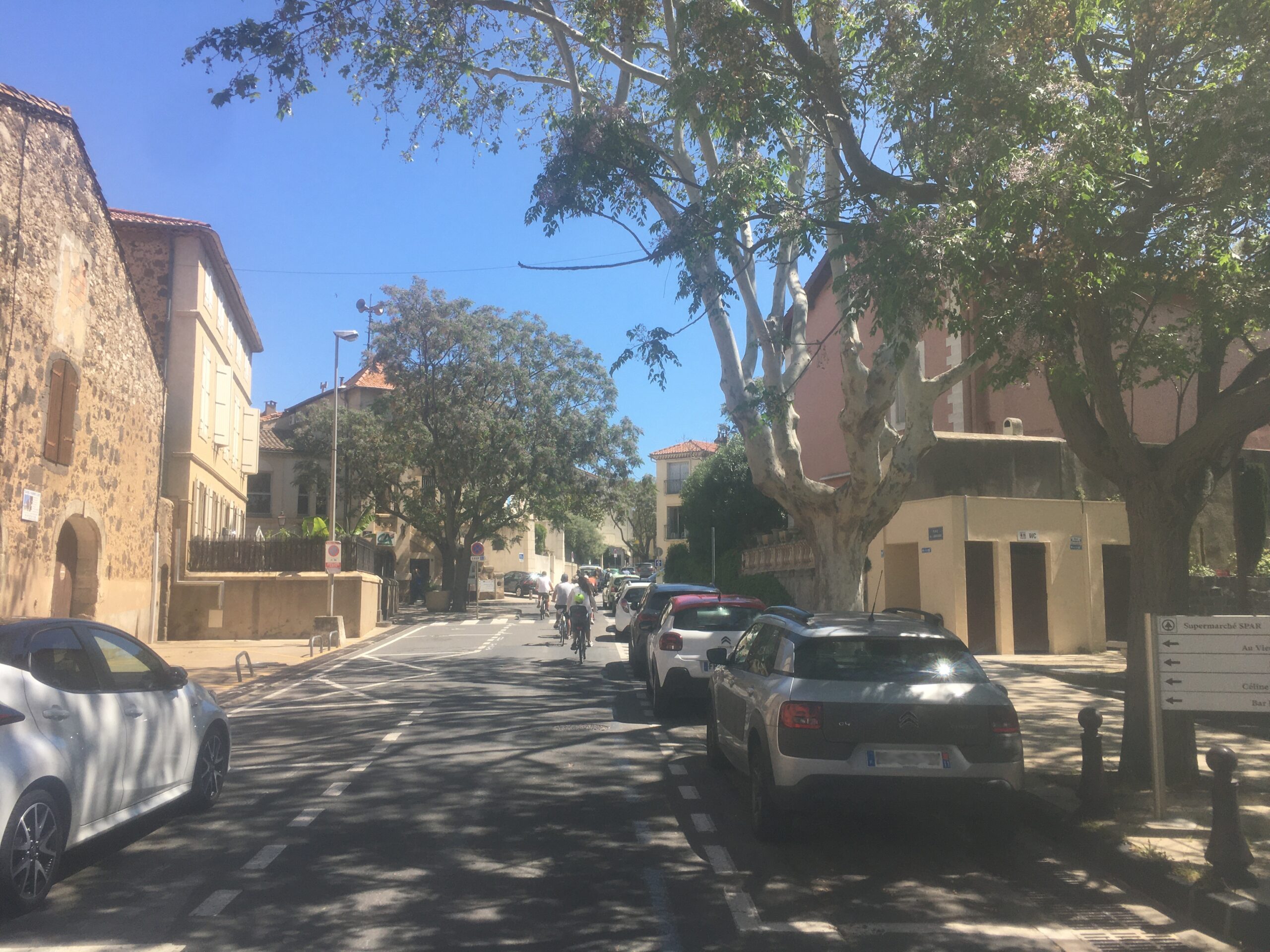
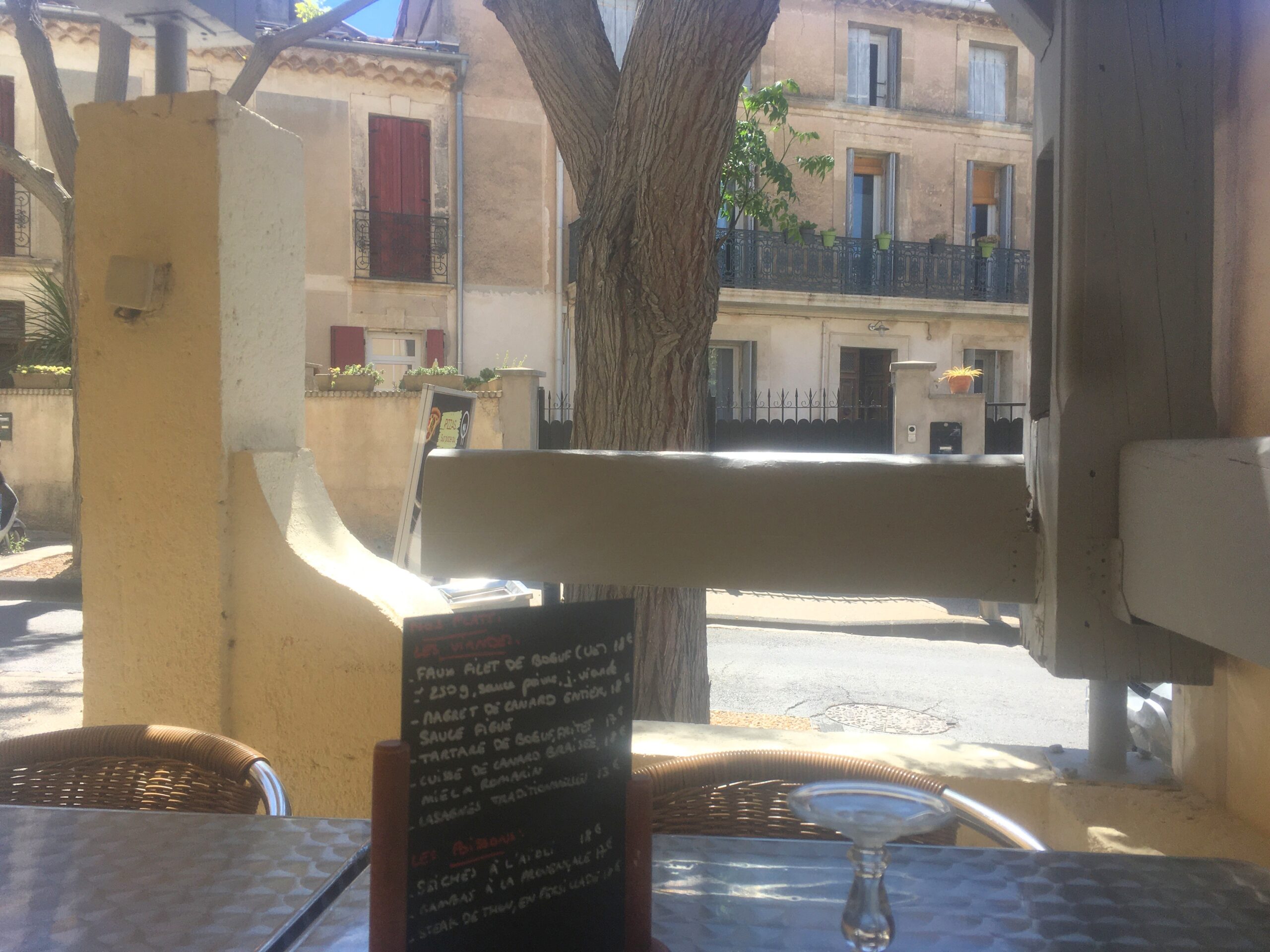
My morning’s route did not place me more than a few kilometres away from the Mediterranean, but the winds and sandy beaches of the previous day felt very distant in this calm, still, peaceful village. After having taken a long break for lunch, I continued heading northeast along small roads towards Montpellier.
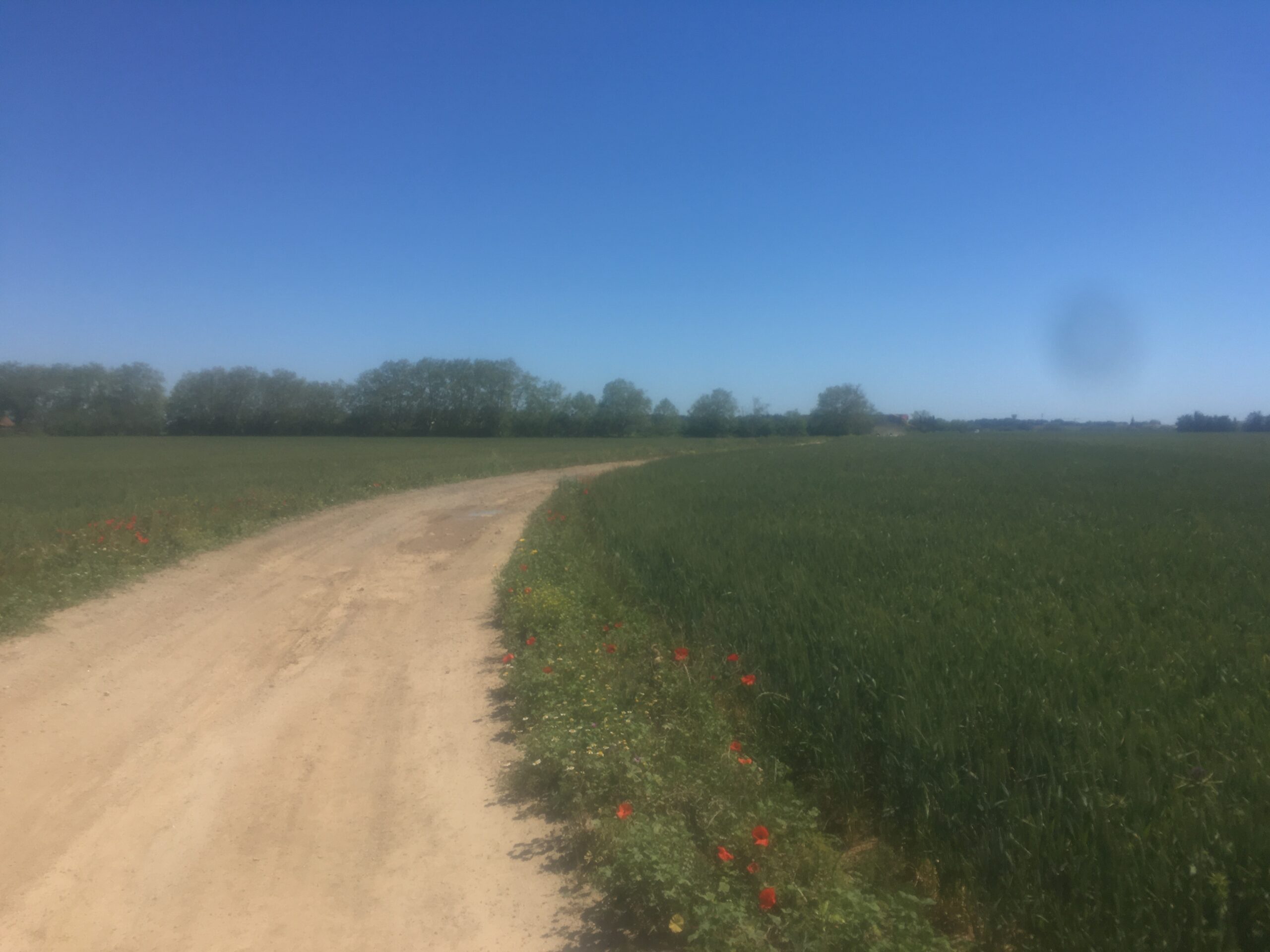
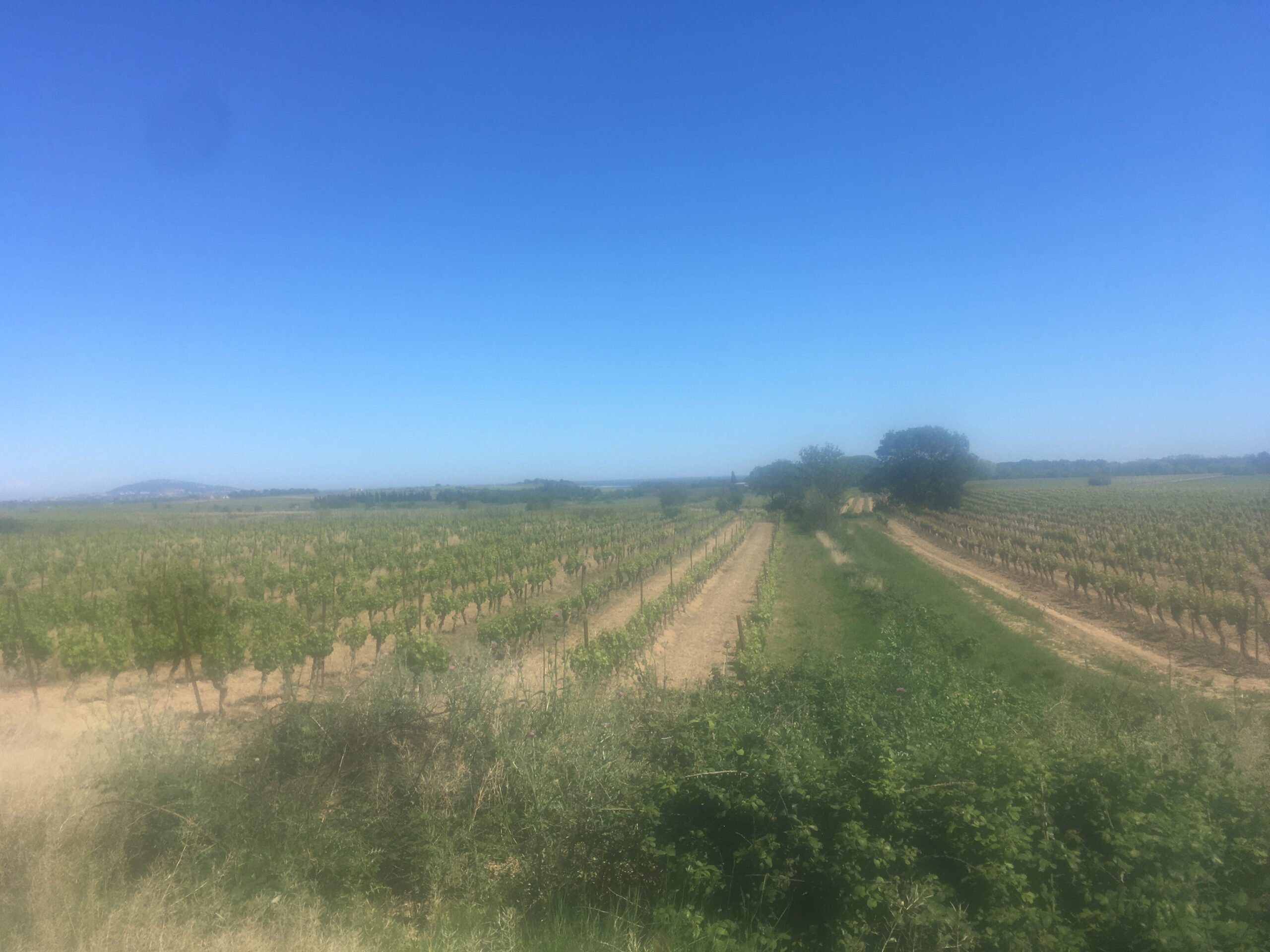
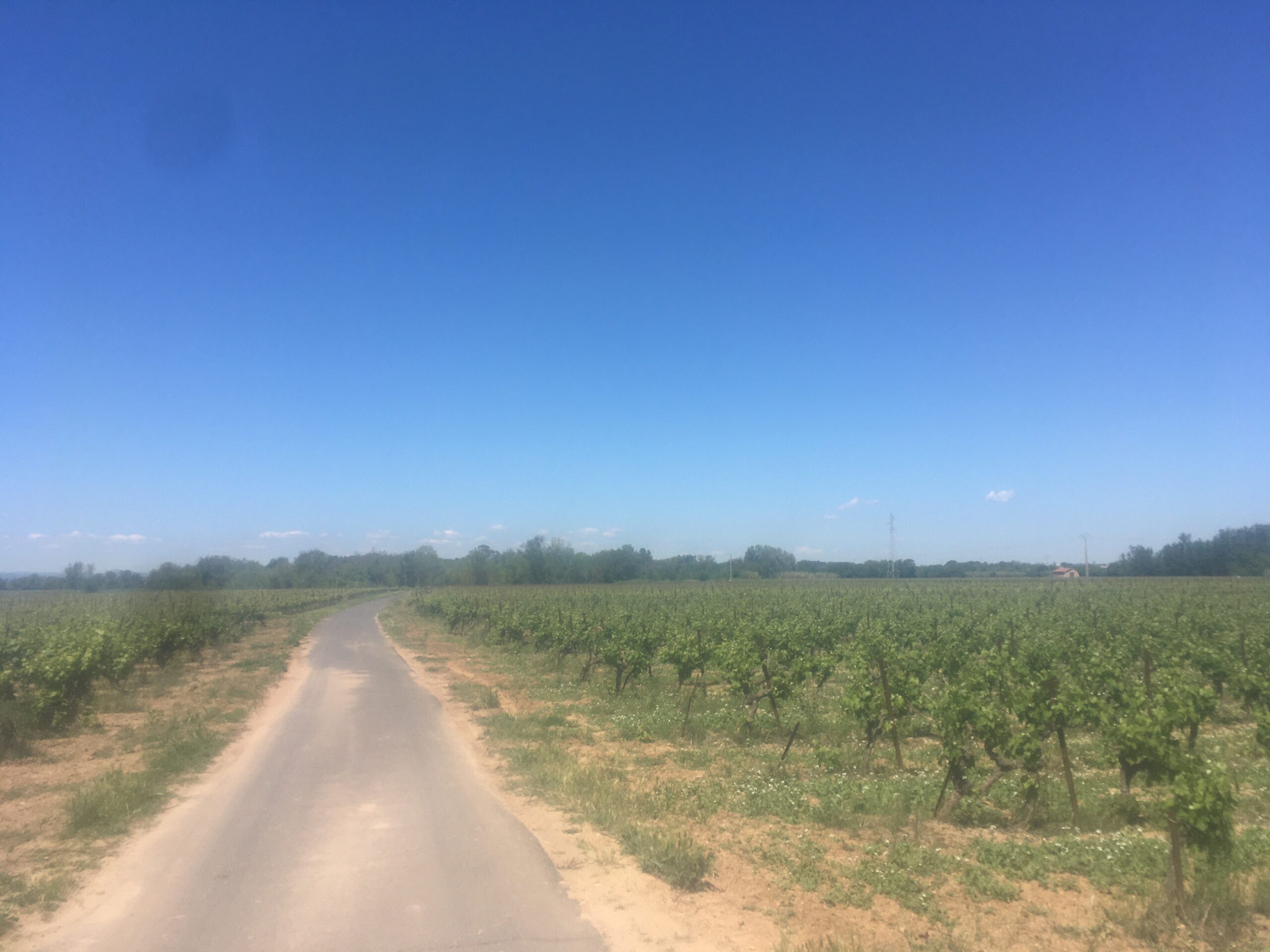
The route suggested by Google took me away from the little roads winding through vineyeards and closes to the A9 highway, but for the last hour or so before reaching Montpellier, I was on a proper cycle path running next to a departmental road, with clear signs indicating the distance to Montpellier.
I arrived in Montpellier in the early evening, with a few hours remaining before sunset. At this point, I could have stopped in one of the affordable places to stay in the city, but I really wanted to finally use my tent and do some camping, so I decided that I would continue onwards until I found a nice place to stop for the night. After grabbing some canned food and eating a snack in the parking lot of a Lidl grocery store, I resumed my journey.
My departure from Montpellier marked the point in the trip where I stopped heading northeast up the Mediterranean coast and started heading primarily to the north. My next navigation point was the town of Langogne, where I would start following the Allier river for several hundred kilometres, and then the Loire river, before eventually meeting up with EuroVelo 6 and then EuroVelo 3 routes, which would guide me all the way to Paris. I followed some small roads out of the city, and was happy to see that the landscape was more forested, which would allow me to find a discreet place to pitch my tent and sleep for the night.
I passed a few locations that seemed to be promising, but because there remained a decent amount of time before sunset, I convinced myself to keep going for a while longer. However, at a certain point, places where I might be able to camp seemed to come less frequently, so when I only had one hour of sunlight left, I convinced myself to stop at the next place that I could find. I had just passed through the town of Prades-le-Lez, and as soon as I found a road that left the highway and ascended into the hilly area, I followed it, and made my way past a few industrial buildings, including the town’s garbage dump. Seeing a small area between two different plots of land that seemed to be out of sight, I carried my bike off the road, through some bushes, and into a small, mostly-clear patch of land that was sandwiched between the adjacent properties’ fences. It seemed like a perfect spot to pitch my tent, eat my dinner, and look at the sunset.
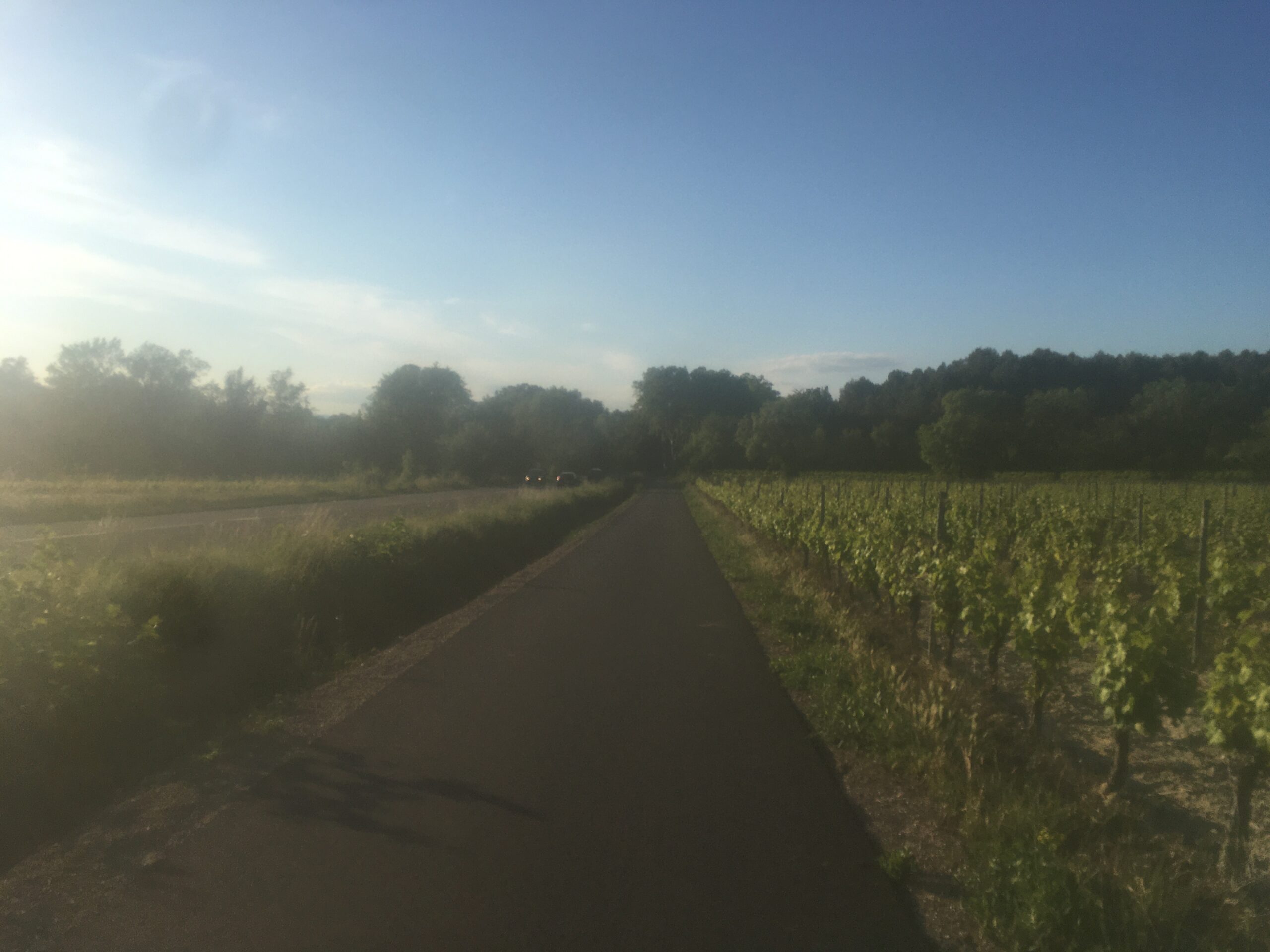
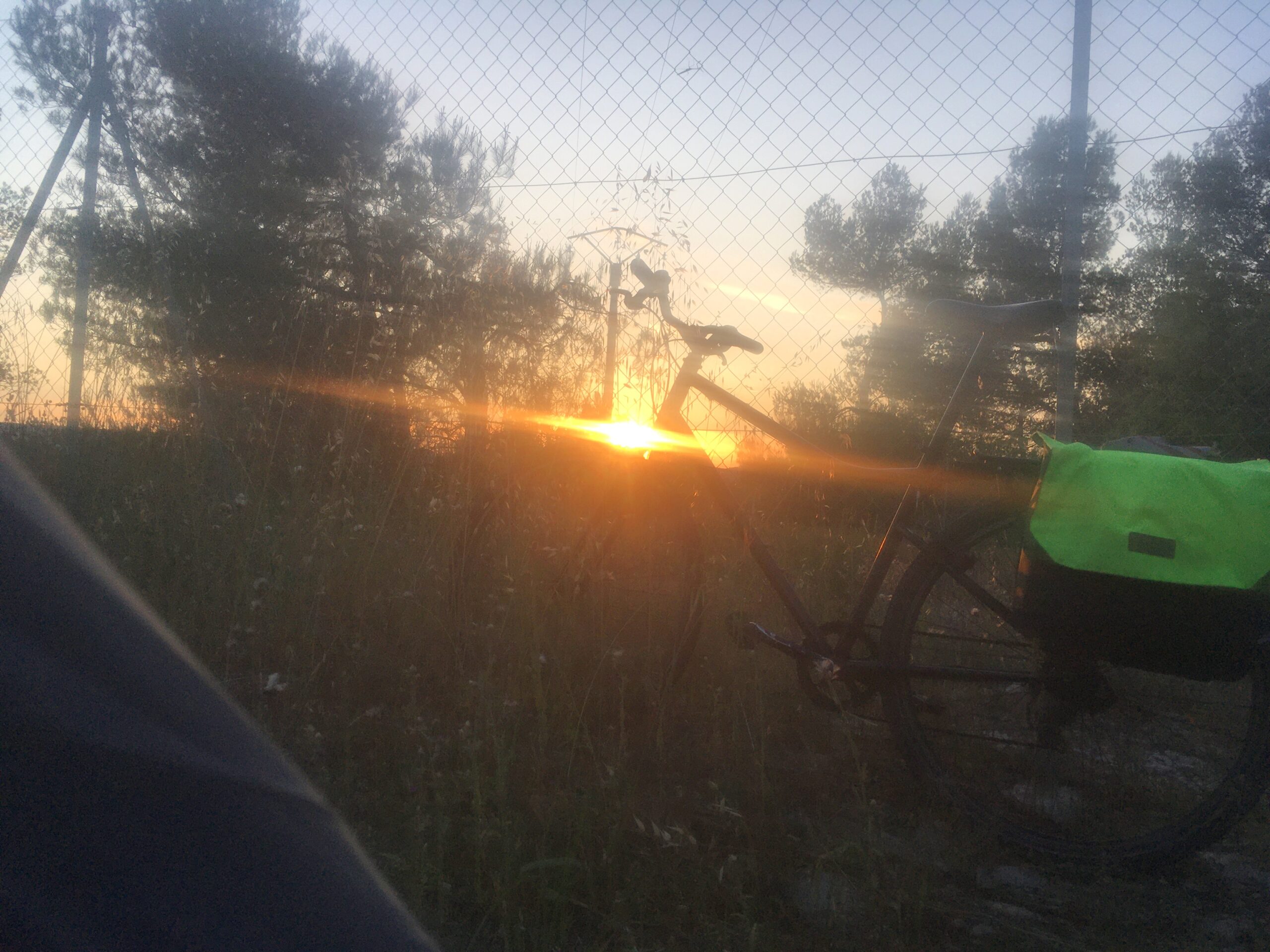
I was so happy with how the day had ended. I had enjoyed my travels for the day, nothing had gone wrong, and I was ready to settle in for a good night’s sleep after having enjoyed such a nice sunset. It seemed as though nothing could go wrong.
Shortly before going to sleep, I heard noises in the trees around me, coming from inside the fenced area of one of the properties next to where I was camping, and then, the barking started. At first, I could not see the sources, but eventually I was able to recognise two large dogs, barking relentlessly at me, not twenty metres away. I generally love dogs, but these ones were aggressive and huge, and I wondered whether they would try to jump over the fence if I didn’t leave – or whether they would bark so much that the property owners might come out, see my campsite, and tell me to leave, or call the police. I went into my tent and prepared to sleep, hoping that the barking would stop, and that the people responsible for the dogs might invite them inside for the night.
Eventually, the dogs went away, but I heard them barking at the other side of the property. They were still outside, and had merely gone elsewhere, but this allowed me to relax and try to sleep… until the dogs came and started barking again.
Just the slightest sound from my tent would cause the dogs to start barking. When I tried to eat, they heard the movements, and started barking. When I rolled over and my sleeping bag made a noise, they started barking. The sun had set, and it was too late to consider moving to a new campsite, so I just laid in the tent, perfectly still, cold, and petrified.
I did not get much sleep that night.
Day 5 – Prades-le-Lez to Aujac, ~110 kilometres
Clearly, I didn’t feel very good in the morning, having spent the night next to the barking dogs in the yard next to me who would react each time I rolled over too quickly. Once the sun had risen, I got up, abandoned all attempts at avoiding the attention of the dogs, packed up my tent as quickly as possible (while being barked at the entire time), and left my campsite, reaching the main road just after 8 AM.
I made my way northeast towards the town of Quissac, mostly following the departmental roads and riding next motorised traffic. After stopping in Quissac to purchase some bandages and ointment for my scraped knees, which still looked quite gross, I continued in the general direction of the town of Alès, riding along a mix of departmental roads and bicycle trails.
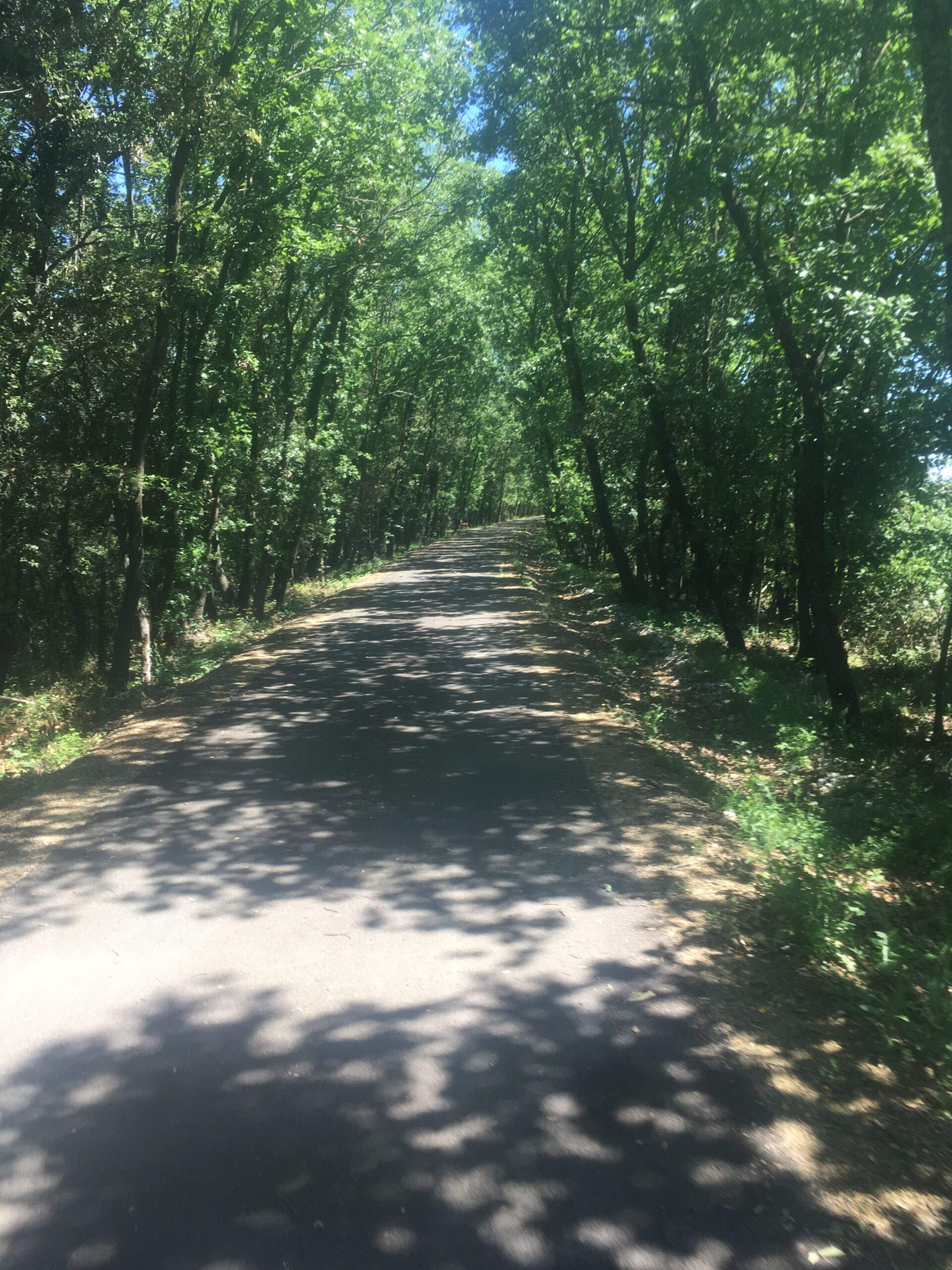

I stopped in Alès, the town described as the “capital of the Cévennes” (a mountain range), where I purchased a sleeping bag that would help me in the colder regions at higher elevations into which I was about to ascend. After leaving Alès, I continued into the mountains, enjoying the beautiful, sunny weather and gradually climbing higher, first hitting the Col de Malpertus (399 metres) then the Col de Trelis (415 metres). Upon arriving in the town of Bessèges, I stopped at a café for an early-evening break, ate some fries, and looked sadly at an abandoned railway station, which had been closed since the suspension of services on the railway in 2012 due to the poor condition of the tracks:
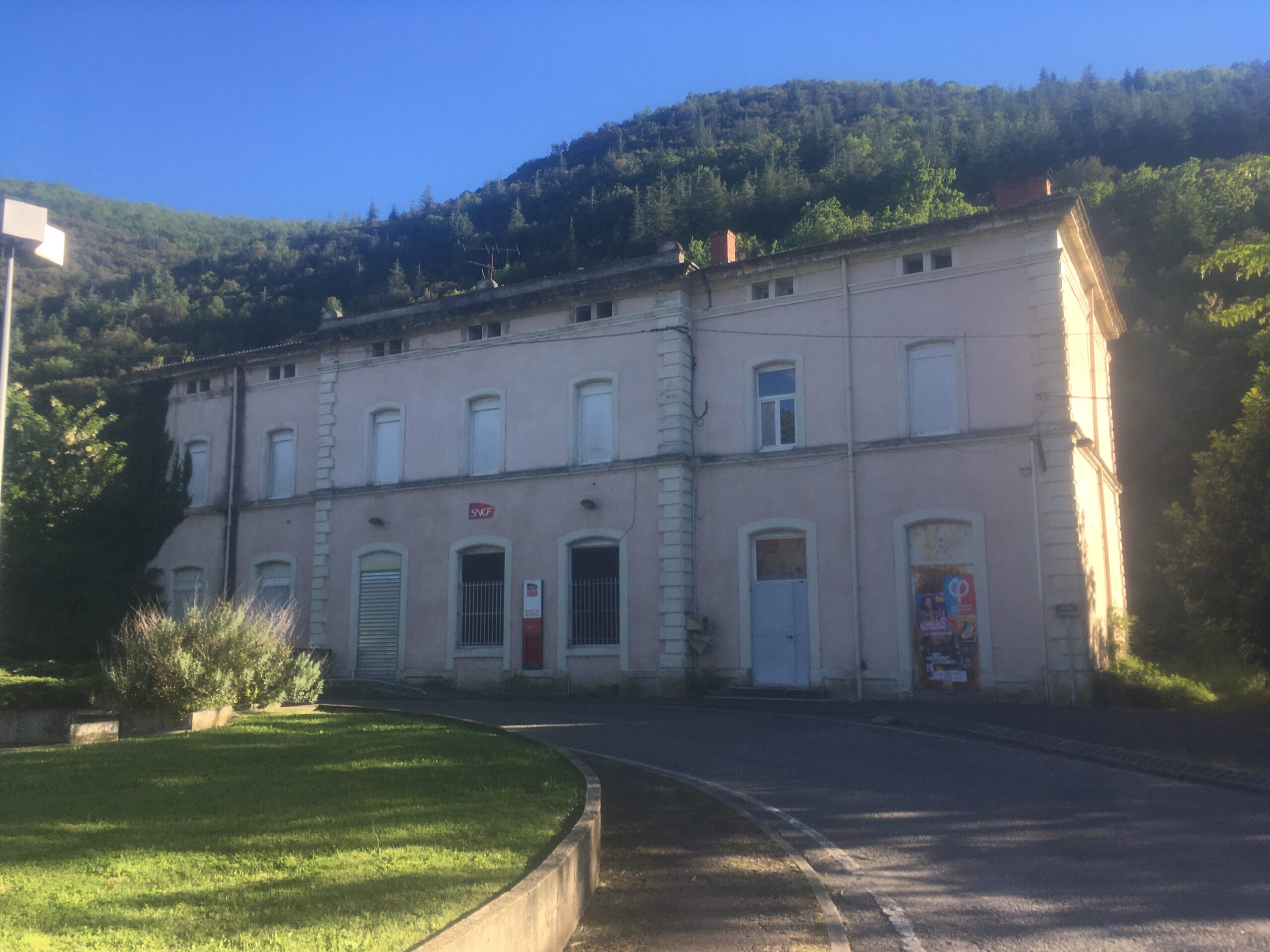
After my short stop, I continued as the sun set, pedalling hard to climb up the steep road despite my heavy load. I made a few tentative efforts to find a spot where I could discreetly camp without being noticed, but after the previous night’s experience with wild camping, I decided to look online for a room to stay for the night, eventually reserving online with a small establishment in the hamlet of Aujac.

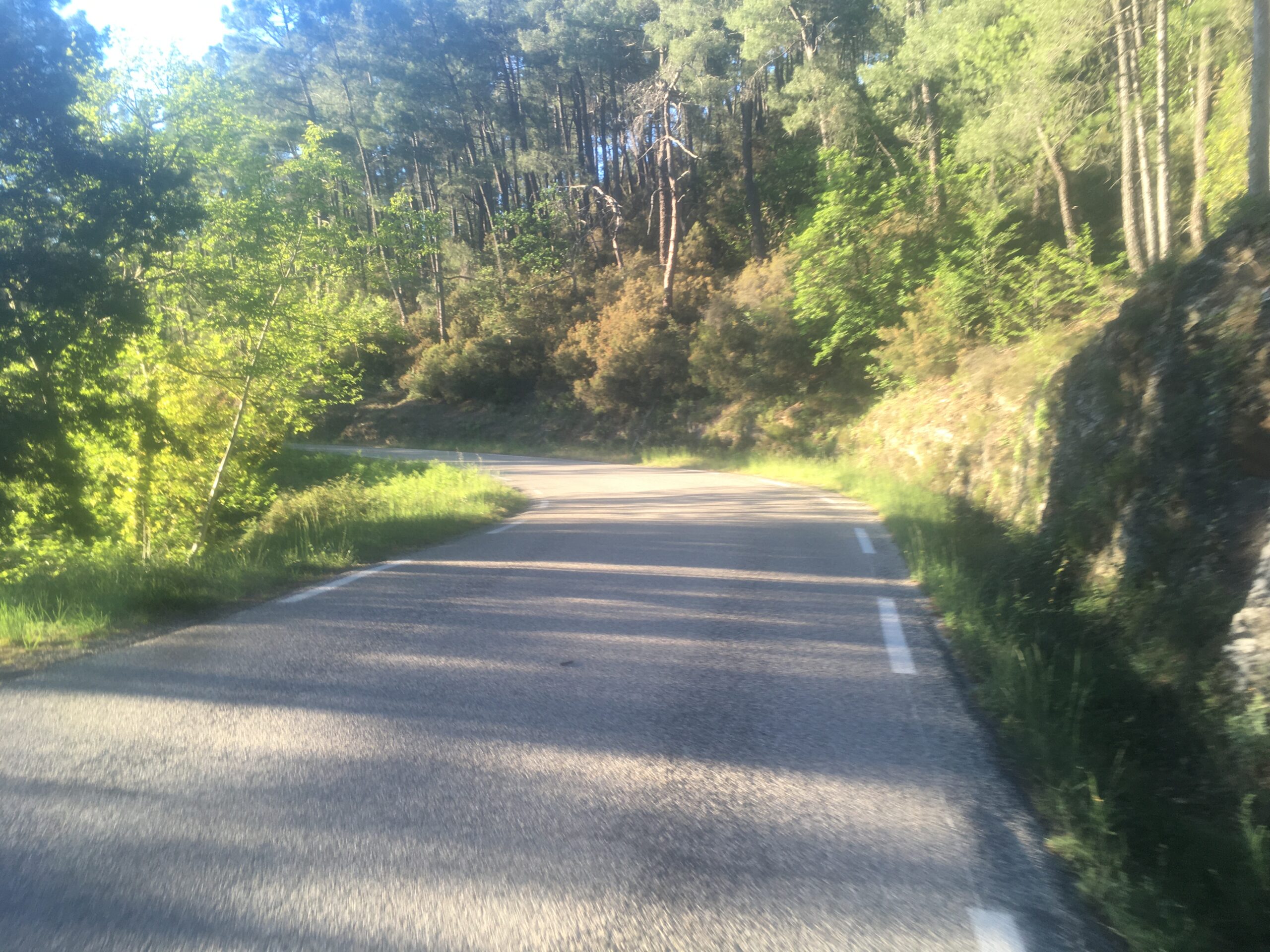
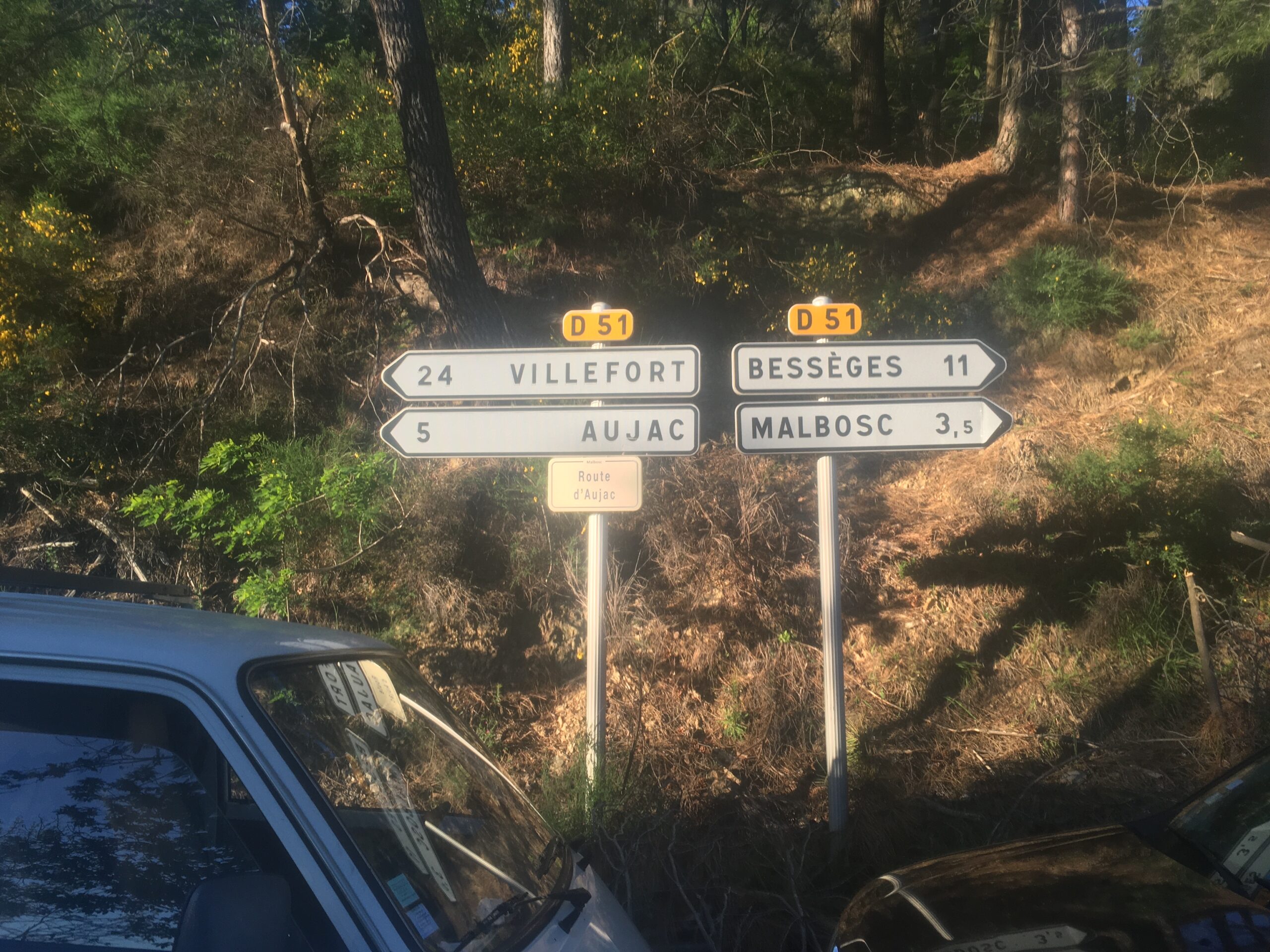
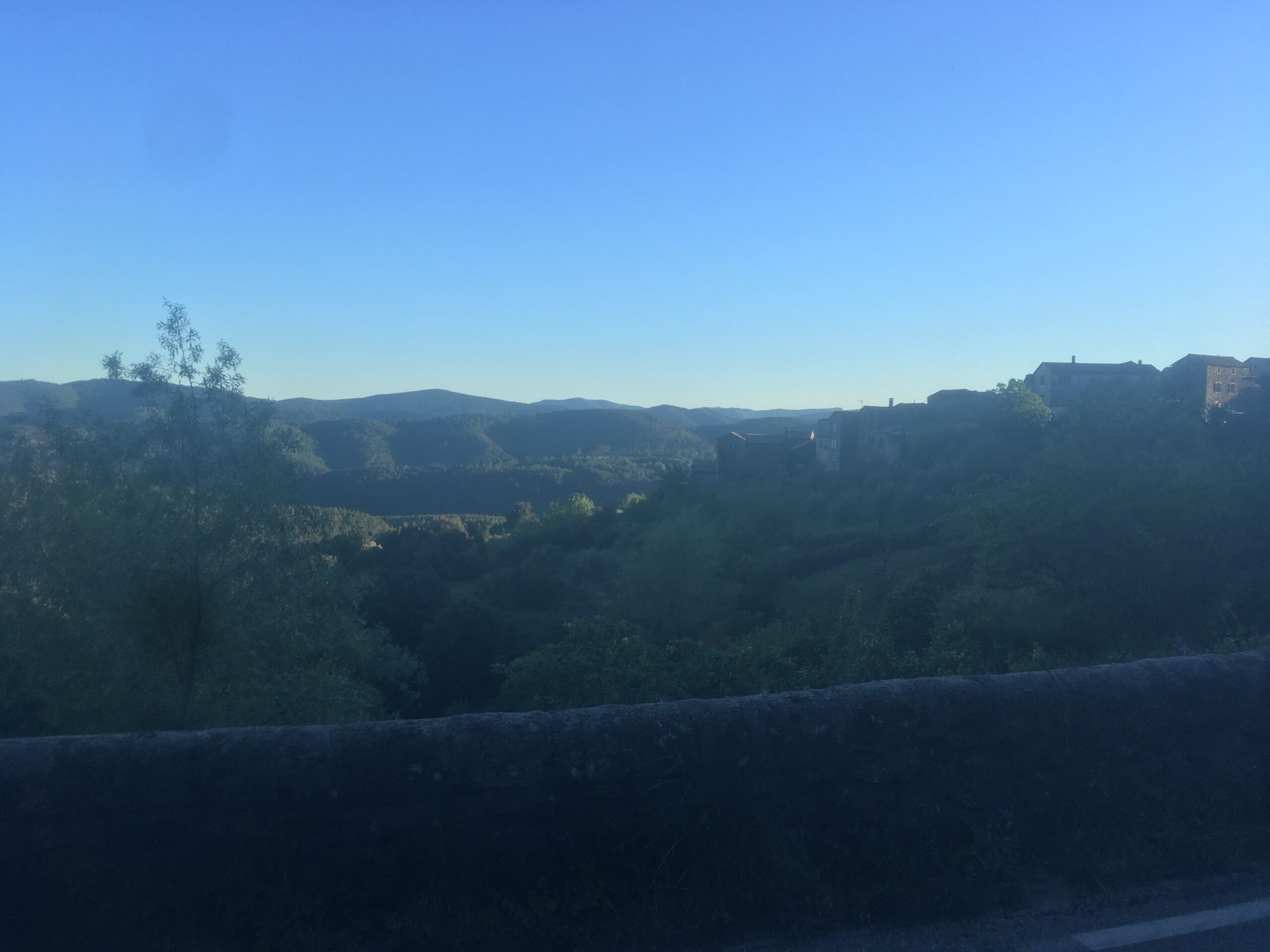

I arrived at around 8:30 PM at the small hotel where I was supposed to stay, almost two hours after having left Bessèges. The managers of the establishment, which boasted four rooms for rent and a small restaurant/bar, were surprised to see me, as they somehow weren’t aware that I’d reserved a room online and they didn’t have a normal room remaining. They did indicate that there was a fifth room available, but were insistent on the fact that it hadn’t been used in a long time. Not having much other choice, I was happy to accept staying in what was undoubtedly the most basic room I’ve ever seen, with just a bed, an old wooden table, and a sink. It was perfect for someone like me who just needed a place to sleep for the night.
I removed all of my supplies from my bike and brought them up to the room, then quickly headed down to the restaurant to see what I might be able to eat. There was nothing on the menu that didn’t include animal parts or secretions, but the cook was happy to make something vegan for me. Once she listed off what she had available in the kitchen, we settled on something resembling a pizza, essentially a medley of all available vegetables (including potatoes – on a pizza!) on top of cooked dough, accompanied by a refreshing glass of beer. I was thrilled with my unusual pizza-like dinner, and spent quite a while slowly eating while enjoying the cozy atmosphere of the tiny restaurant.
After the previous night’s disastrous attempt at sleeping, followed by a day of tiring cycling, I slept very well that night.
Day 6 – Aujac to Lavoûte-Chillac, ~145 kilometres
In the morning, I was well-rested, and felt very prepared for the day that awaited me. After a quick breakfast of bread, jam, orange juice, and coffee, I packed my bicycle and left the hotel just before 9:30 AM. The weather was beautiful, but the physical effort was equally demanding: over the course of the day, according to the geographical data of Google, I climbed from an elevation of about 350 metres to a maximum elevation of about 1170 kilometres, though when factoring in the various times where I would ascend and descend in rapid succession, the total amount of elevation gain on my bicycle over the course of the day was over 1800 metres, with the route looking something roughly like this.
I don’t have a lot to say about this day that isn’t shown by the photos, so here they are:
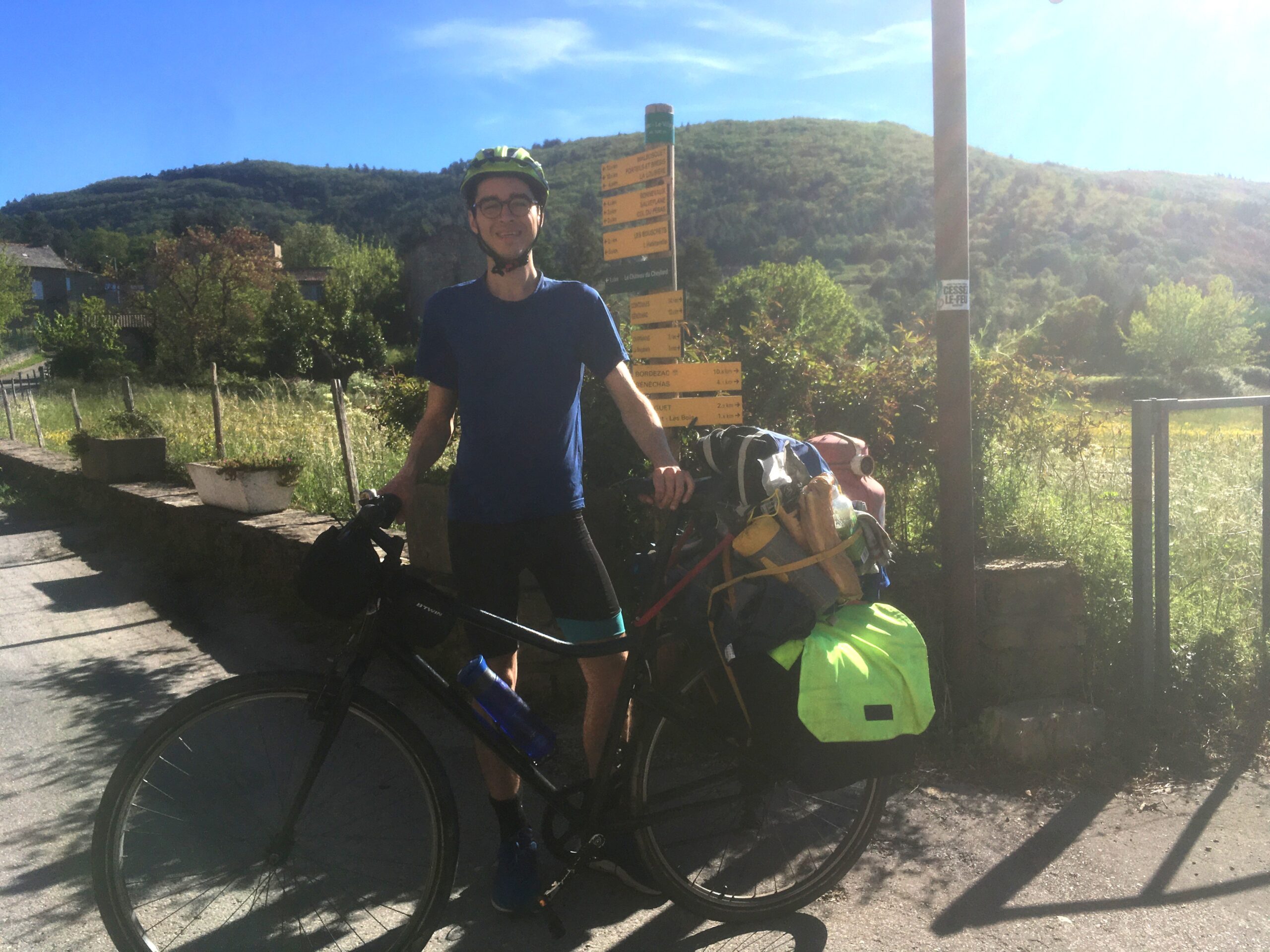
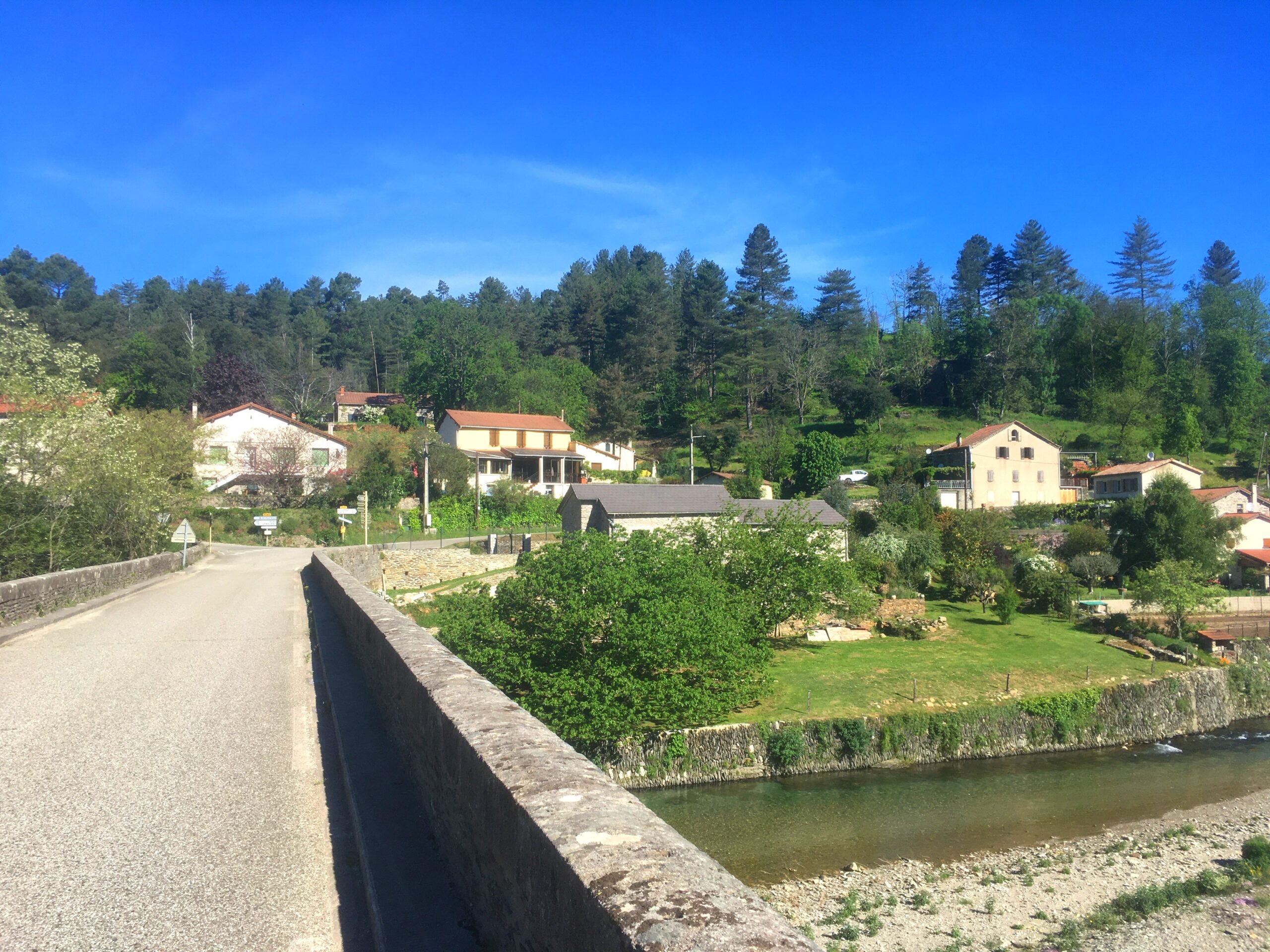
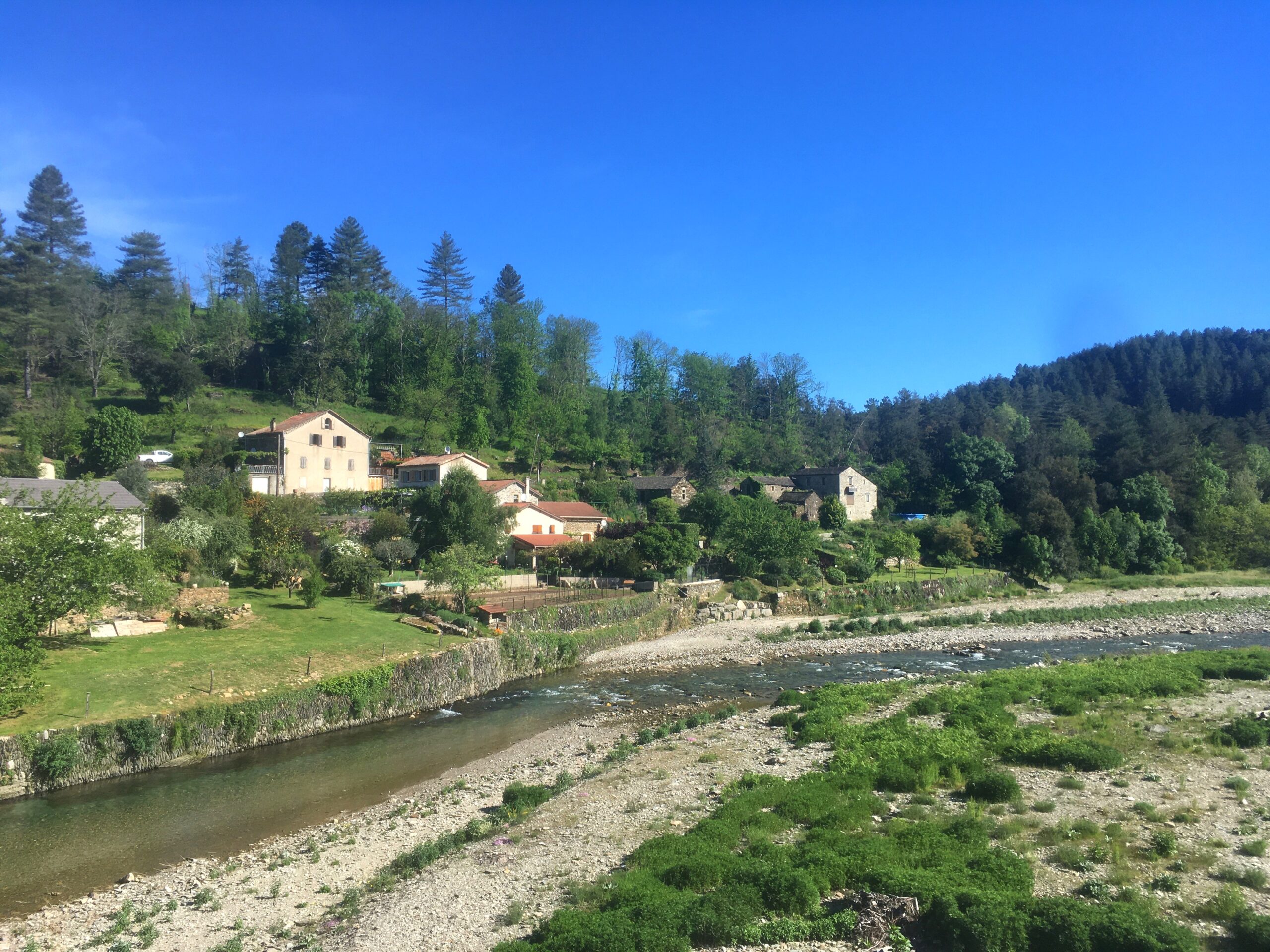
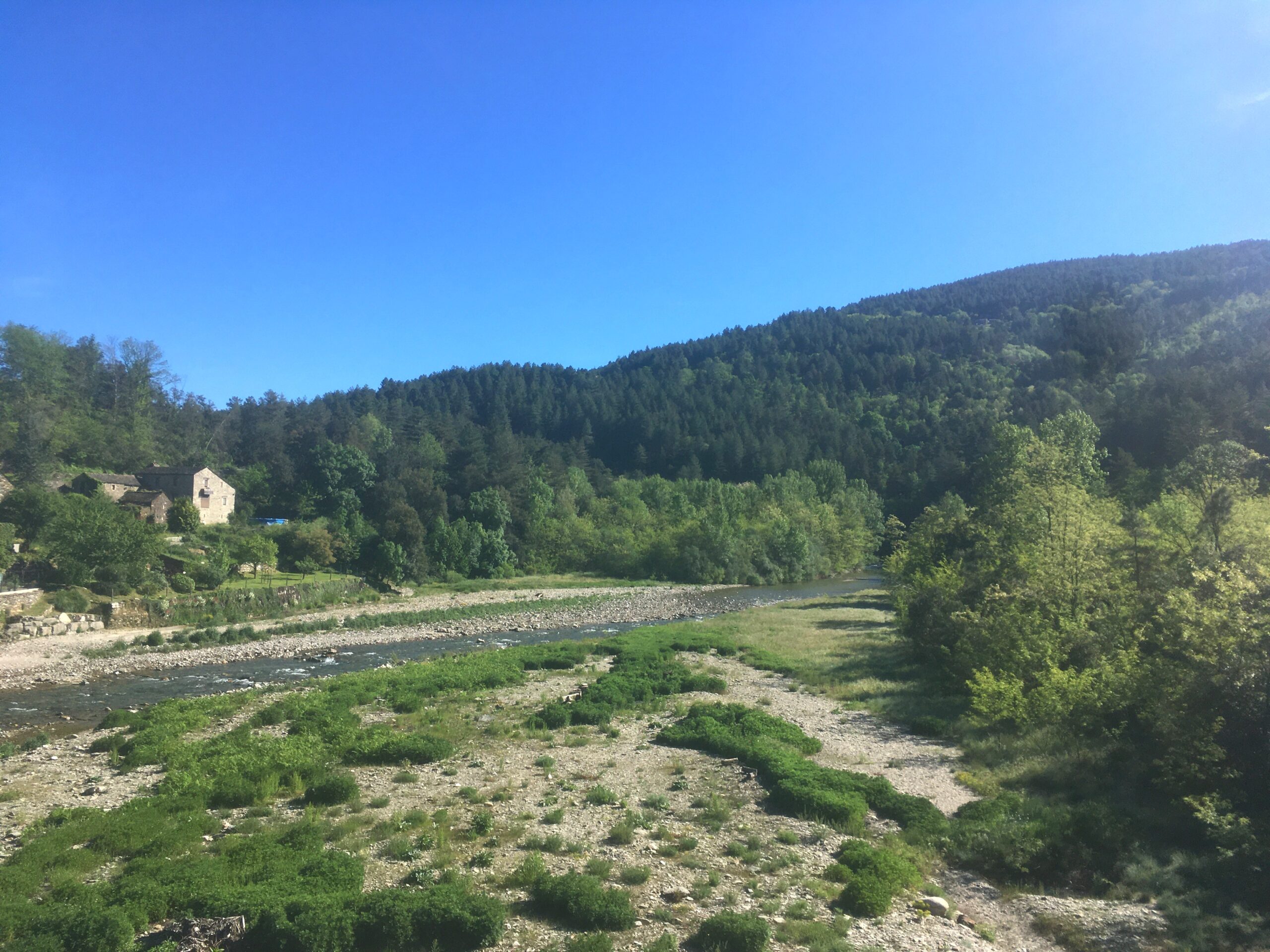
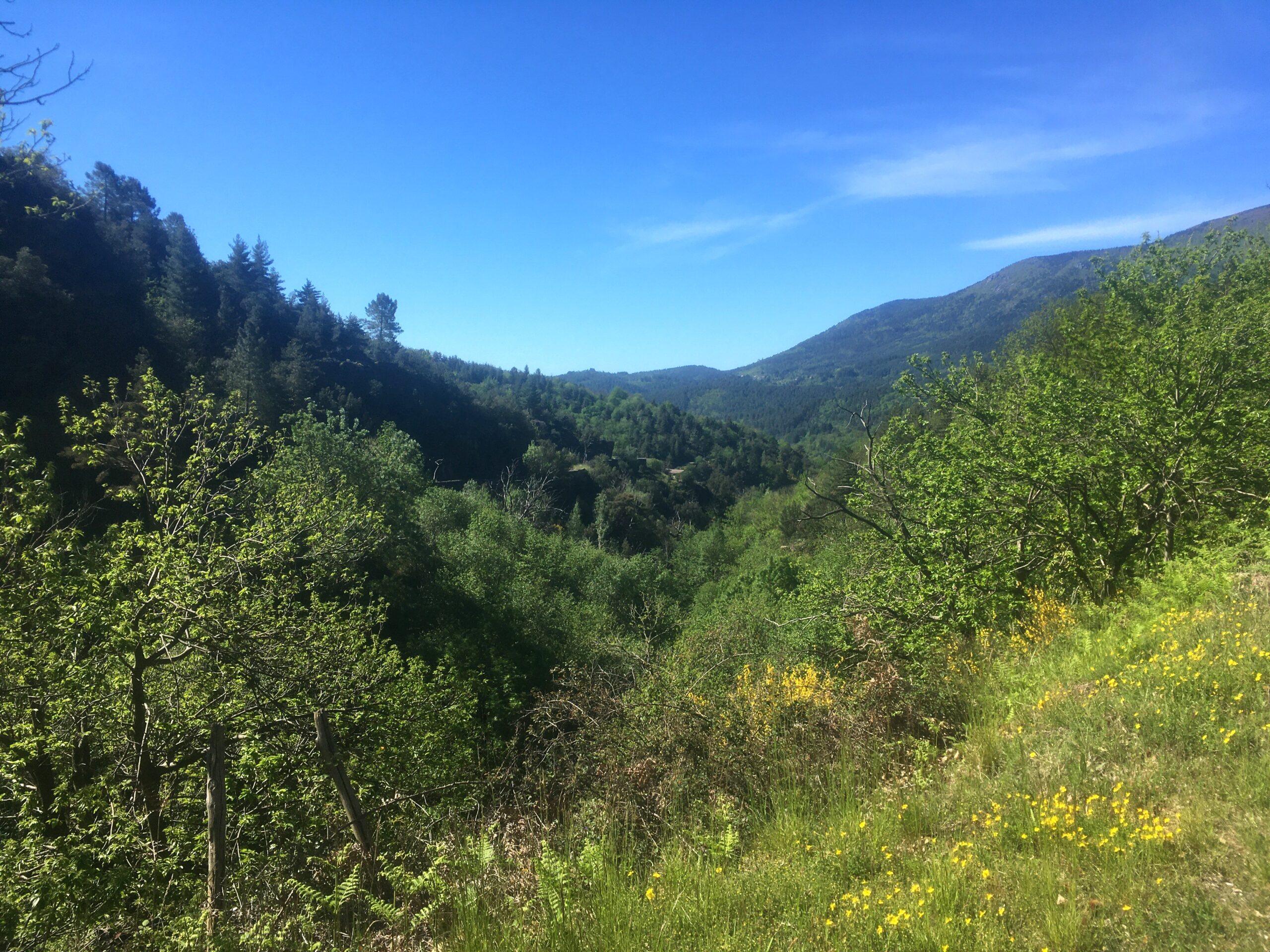
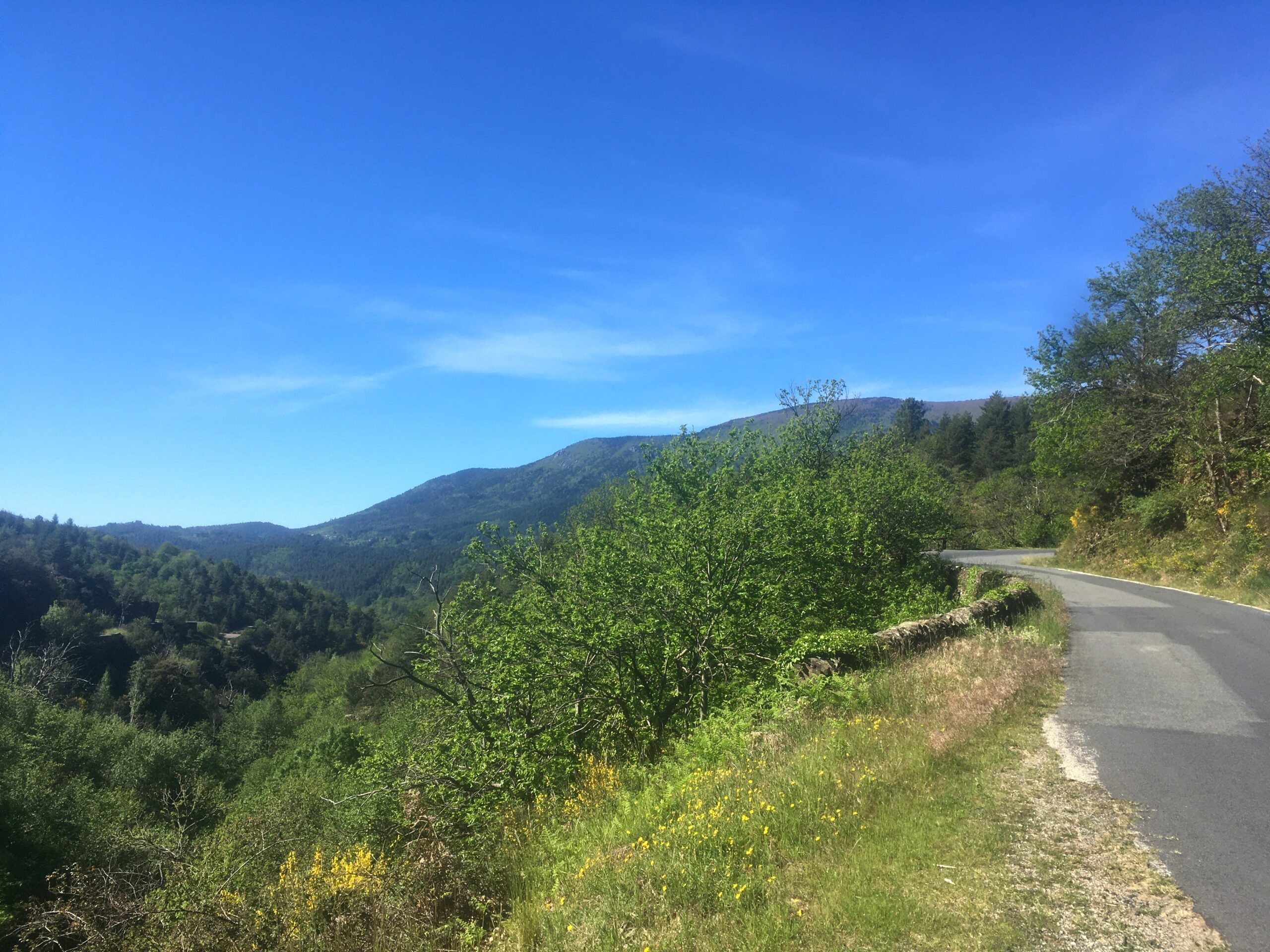
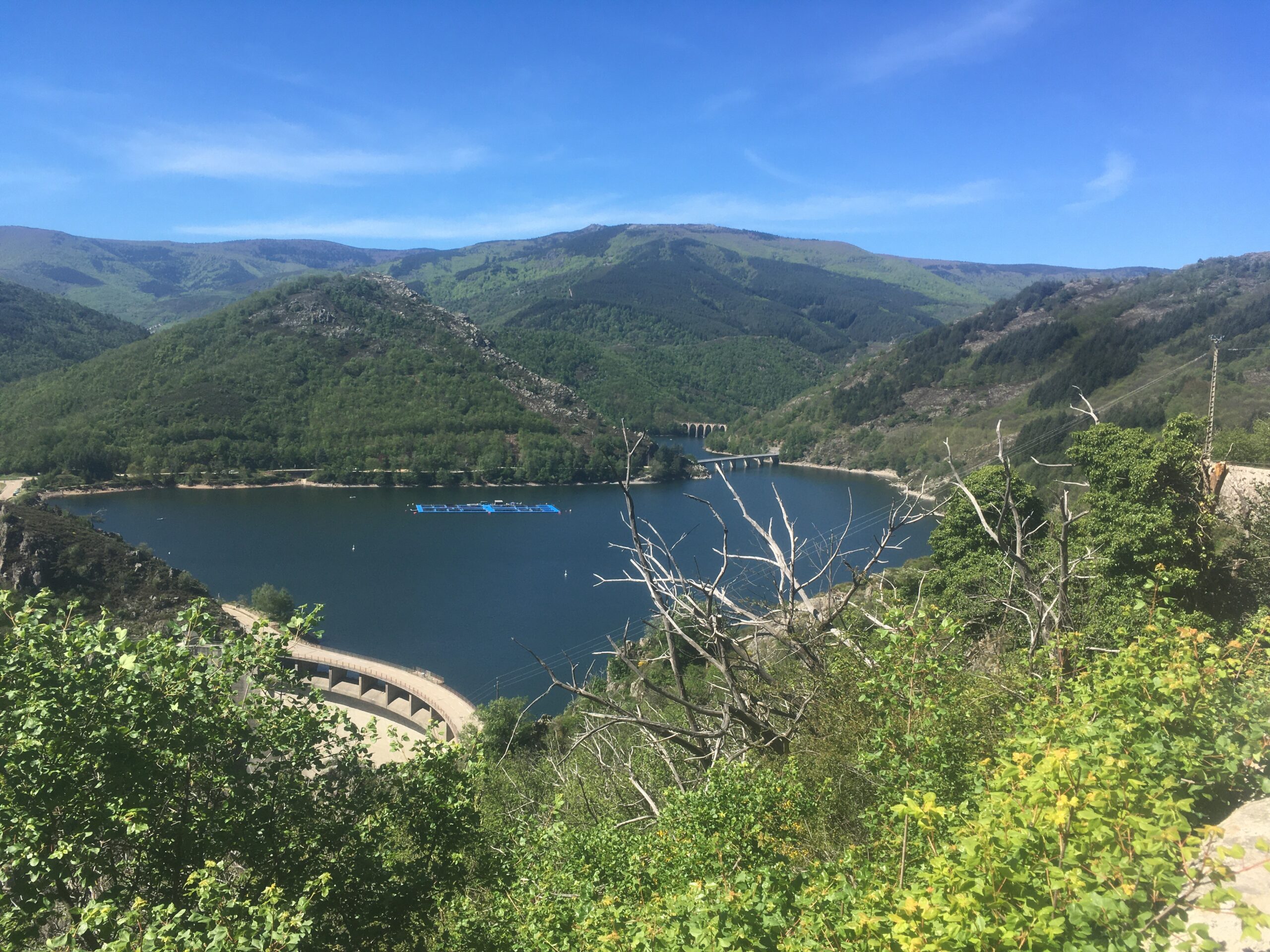
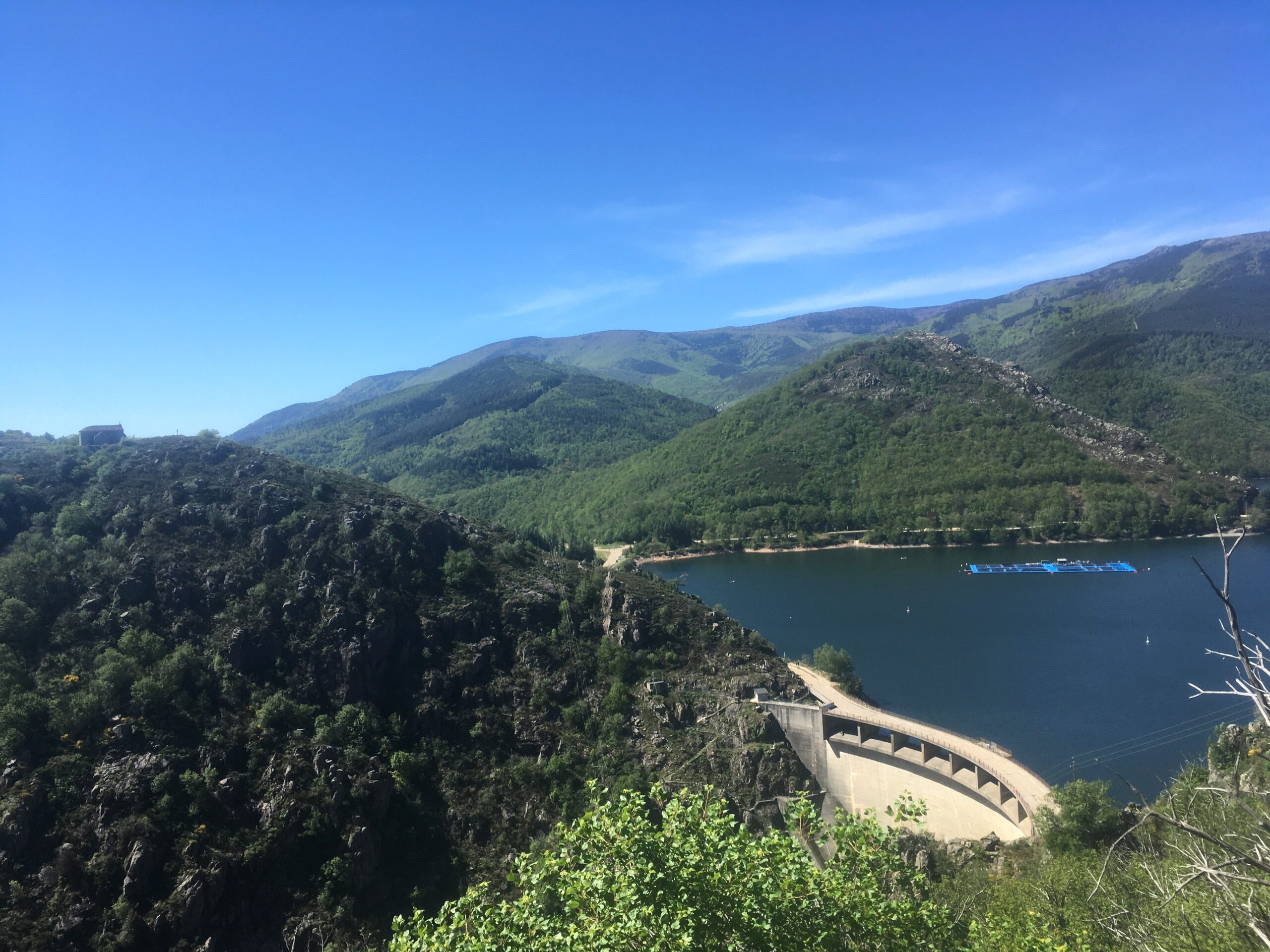
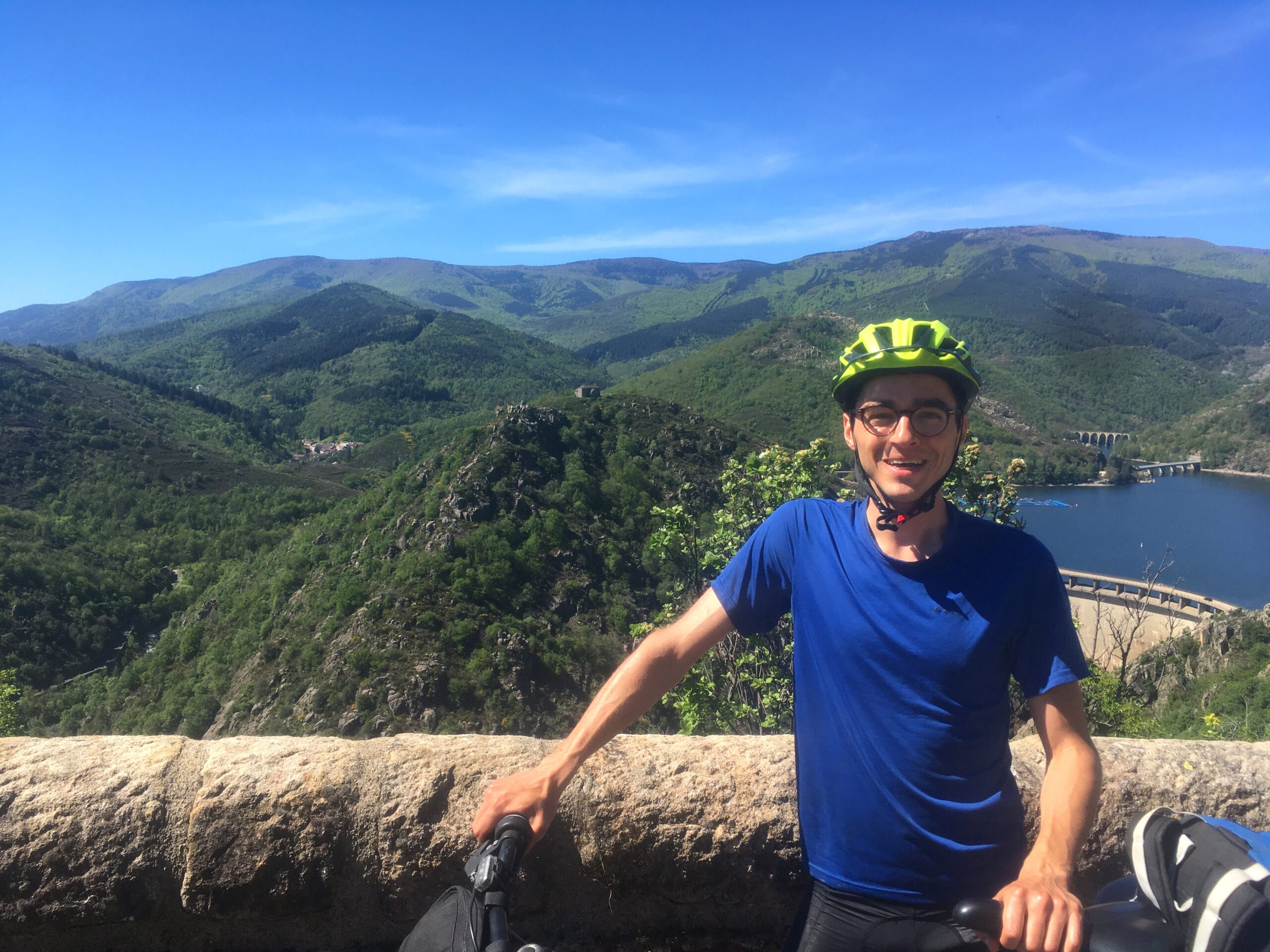
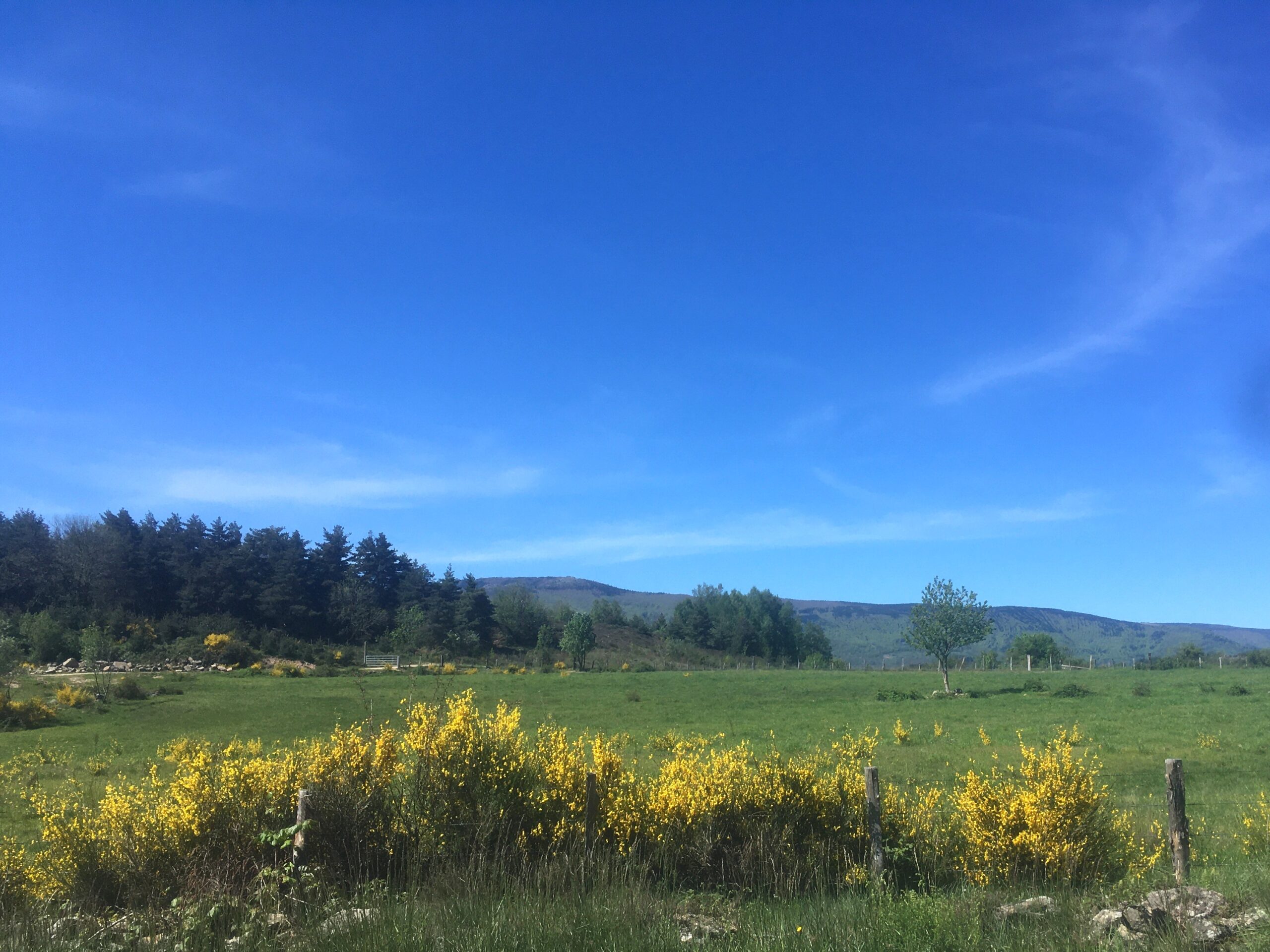
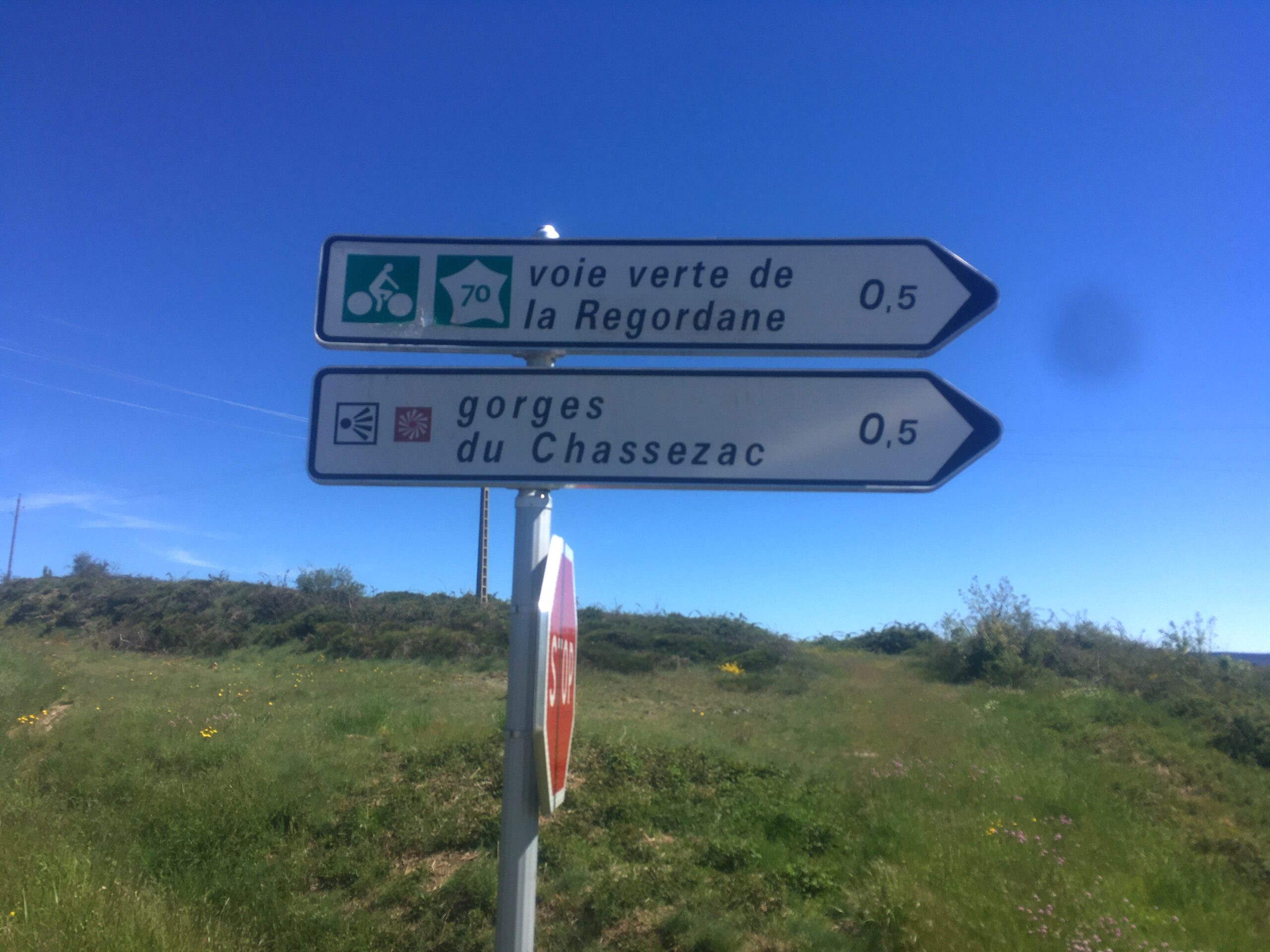

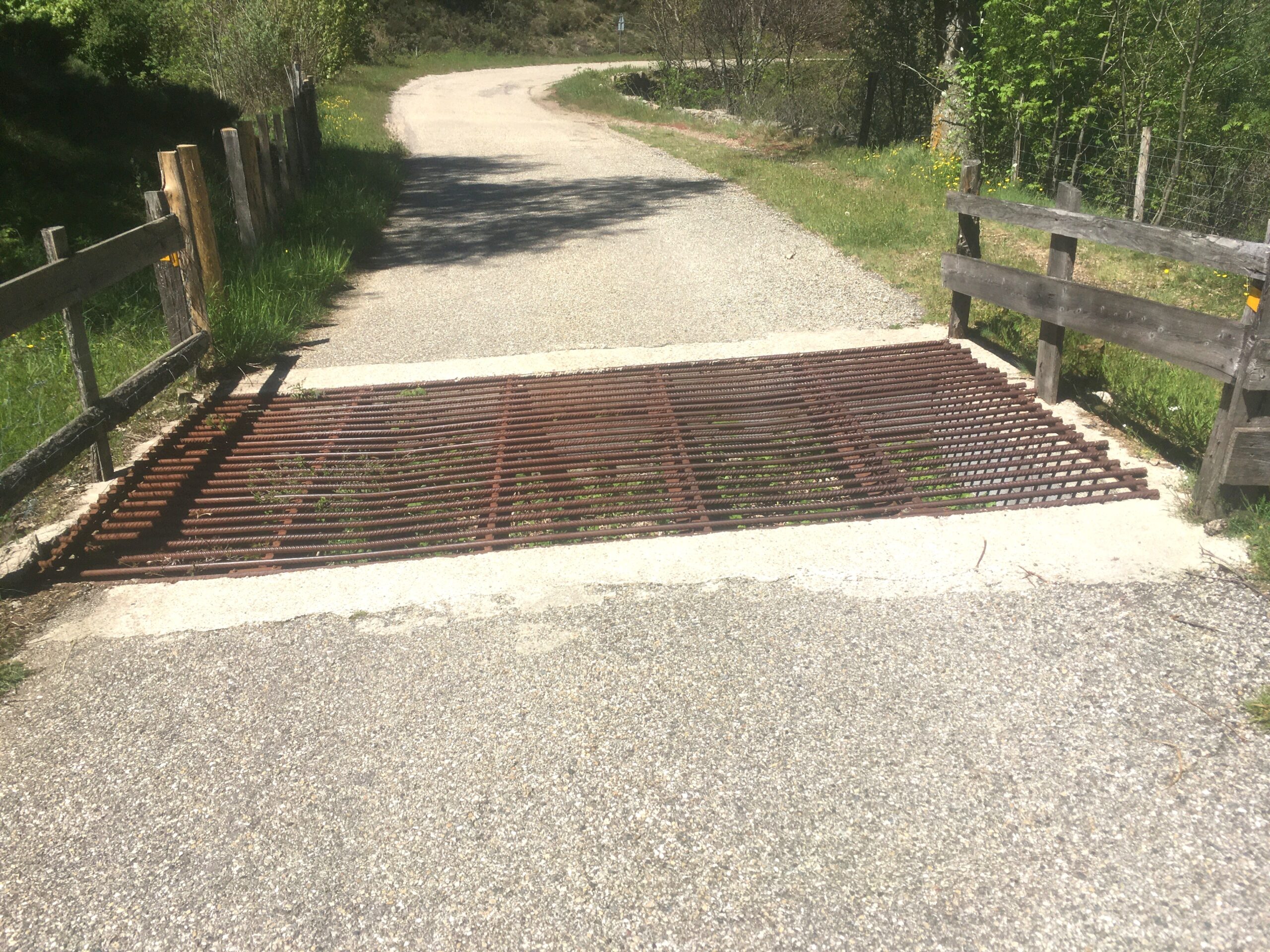
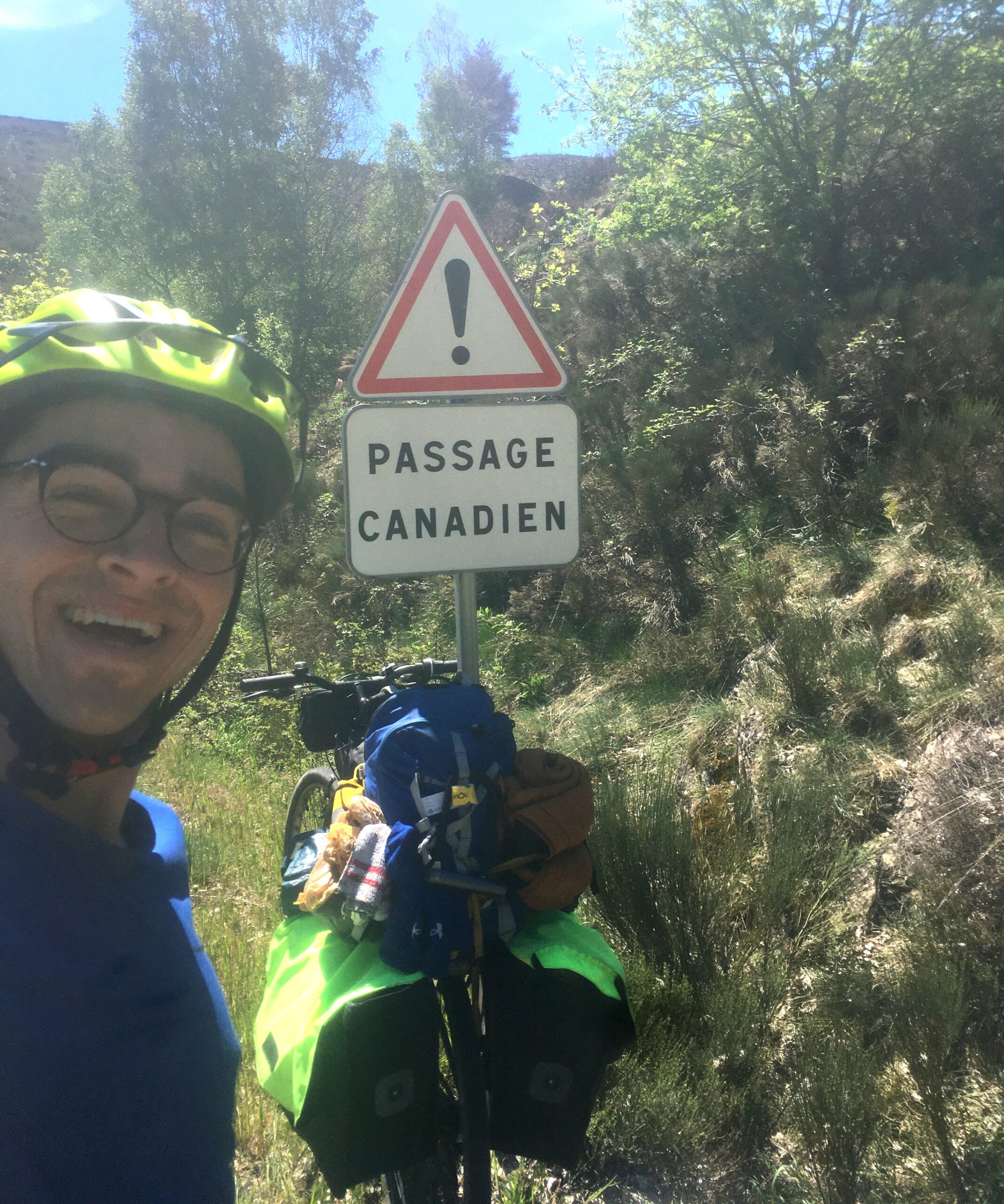
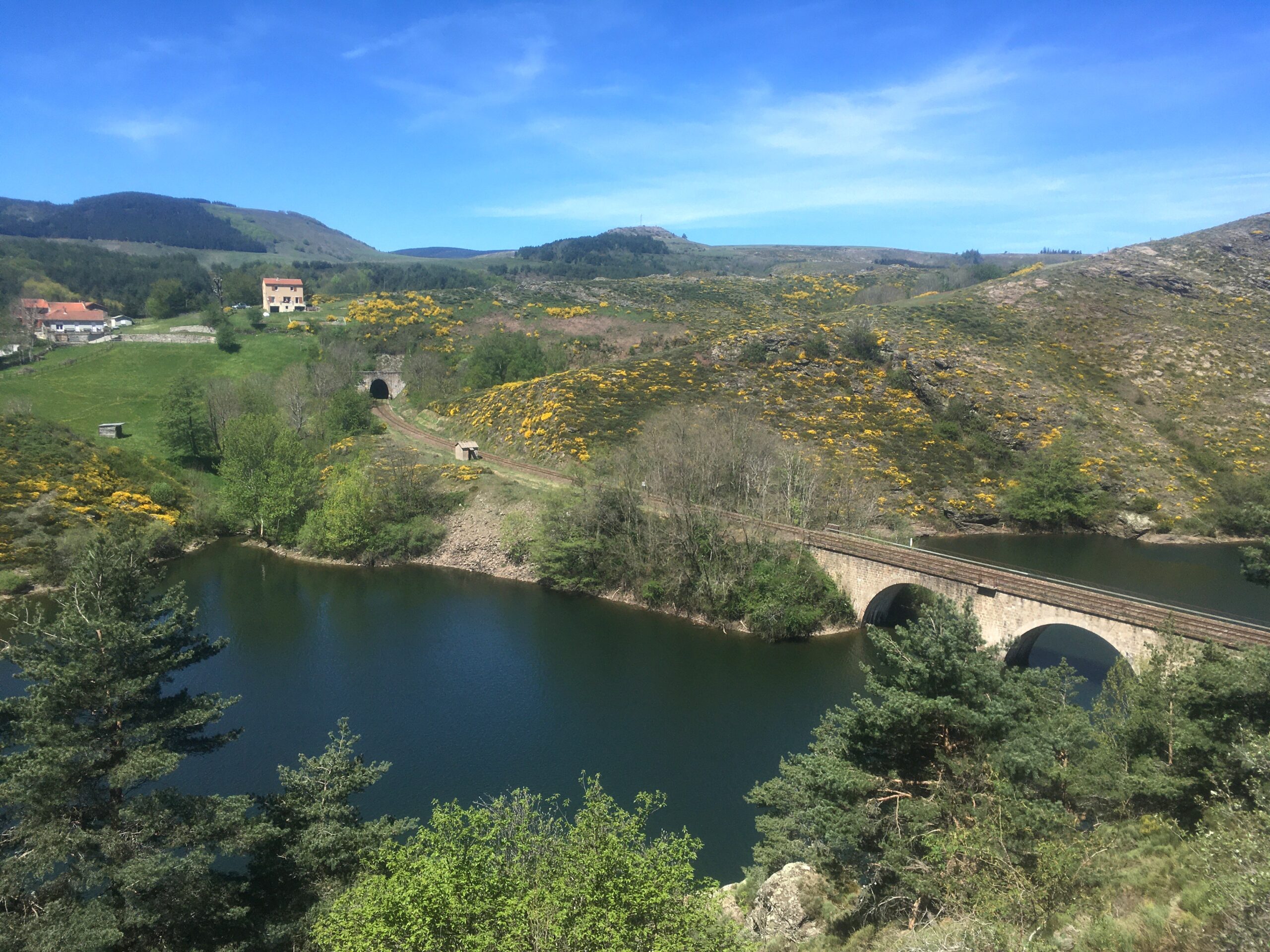





After eleven hours of biking, I arrived in Lavoûte-Chillac, a small town on the Allier river with a very nice and reasonably-priced municipal campground. For about ten euros, I got a place to pitch my tent (legally, and with no dogs barking at me all night), plus access to a shower. I set up my tent, then walked to the area of town where the restaurants were located.






After enjoying a much-needed meal on a patio overlooking the river, I returned to the campsite and went to sleep around 10:30 PM, in a state of total exhaustion but total contentment.
Day 7 – Lavoûte-Chillac to Clermont-Ferrand, ~105 kilometres
In the morning, I woke up to a grey sky. I ate, packed up my campsite, and started pedalling. A light rain started almost immediately after I exited the town. Still feeling great from how nice the previous day had been, I avoided becoming discouraged by the rain, and followed my way along the Allier river for several hours. By this point in my trip, I was following the Via Allier portion of the V70 national cycle route, which had a well-marked itinerary and lots of signs. However, the route often took me onto busy departmental roads where drivers would perform unsafe passing manoeuvres without slowing down, including in locations with blind corners and generally poor visibility. In addition, the on-and-off rain made it difficult to enjoy the countryside, and the proximity to the river didn’t seem to spare me from having to deviate away from it and climb up some big hills to go from one valley to another.


During a moment of heavy rain, I stopped under a bus shelter and took a few minutes to check out the weather that I would encounter for the rest of my trip back to Paris. I was planning on stopping that night in Vichy, then in Nevers the next night, then finally in Montargis the following night before finally reaching Paris, but it seems that my entire route would be haunted by poor weather as I passed through it.
After seven days of difficult cycling, and knowing that the most beautiful parts of the trip were likely behind me, I asked myself: “Is the desire to ride a bicycle all the way from Barcelona to Paris sufficiently strong to justify spending the final three days in unpleasant, cold, rainy weather?”
It didn’t take long for me to realise that, given the poor weather that was to be expected for the rest of the trip, I would prefer to return to Paris by train. Clermont-Ferrand, the largest city in the area, was only about one hour away by bicycle, meaning that I’d easily be able to ride there and then get a train back to Paris. It was too late in the day to get a train for that same day, but I found a train for the following morning from Clermont-Ferrand to Paris, with a transfer in Nevers, so I booked it immediately, and booked a cheap hotel room close to the main town square, Place de Jaude.
After a bit over an hour of travelling into the city on what was essentially a highway, I arrived at my hotel, where the receptionist kindly allowed me to hide my bicycle in a storage room to avoid having to bring it up to my room. I took my things to me room, and looked online for a place where I might eat before going to sleep, given that evening had arrived. I wasn’t expecting much in Clermont-Ferrand, but was pleasantly surprised to find that Copper Branch, a Canadian vegan fast-food restaurant, had opened a location in Clermont-Ferrand – and that it was just a ten minute walk away! I walked across the Place de Jaude, ordered a bunch of tasty vegan food, then happily returned to my hotel room to sleep.
Day 8 – Clermont-Ferrand to Paris (by train)
The return to Paris was uneventful. I had purchased tickets for two TER regional trains, instead of the direct (and more-expensive) Intercité train, because the TER trains allow for bringing a bicycle on the train without having to disassemble it.
My first train left Clermont-Ferrand before 8 AM, and by 9:30 AM, I was wandering around Nevers with my bicycle while waiting for my train to Paris. I stopped in a coffee shop for an espresso, then slowly made my way back to the train station, feeling slightly nostalgic as I remembered the previous time when I’d visited Nevers a few years earlier for just one night to see a concert.
The trip from Nevers to Paris was equally uneventful, and I was happy to arrive at Paris Gare de Bercy and then at my apartment a few minutes later. I love visiting other places, but returning to Paris always gives me the nice feeling of returning to my home.
Closing thoughts
Well, clearly “Barcelona to Paris on a Bicycle” was the original plan, but didn’t quite end up being what happened. Despite not having followed the entire route that I’d planned, and despite the pedalling being more difficult that I’d expected, I was very happy with my experience on this trip. I had still ridden almost 800 kilometres in seven days with no prior physical preparation through often-mountainous terrain on my heavy (and heavily-laden) bicycle, I had seen many beautiful landscapes, and I got to listen to a lot of music and podcasts.
This trip did reassure me that I really do enjoy travelling long distances by bicycle, and that I would have no doubts about doing this in in the future for more ambitious trips. However, as has been the case with many experiences in my life as I have grown older, I am reminded me of the fact that it would be even better if I were able to share the trip with others. Fortunately, there are some group cycle trips in the works for this year!
Your adventures always bring a smile to my face knowing you are living your best life and doing things that bring you happiness! Please keep journaling and sharing!